23 UNREAL Alberta Larch Hikes (With Photos!)
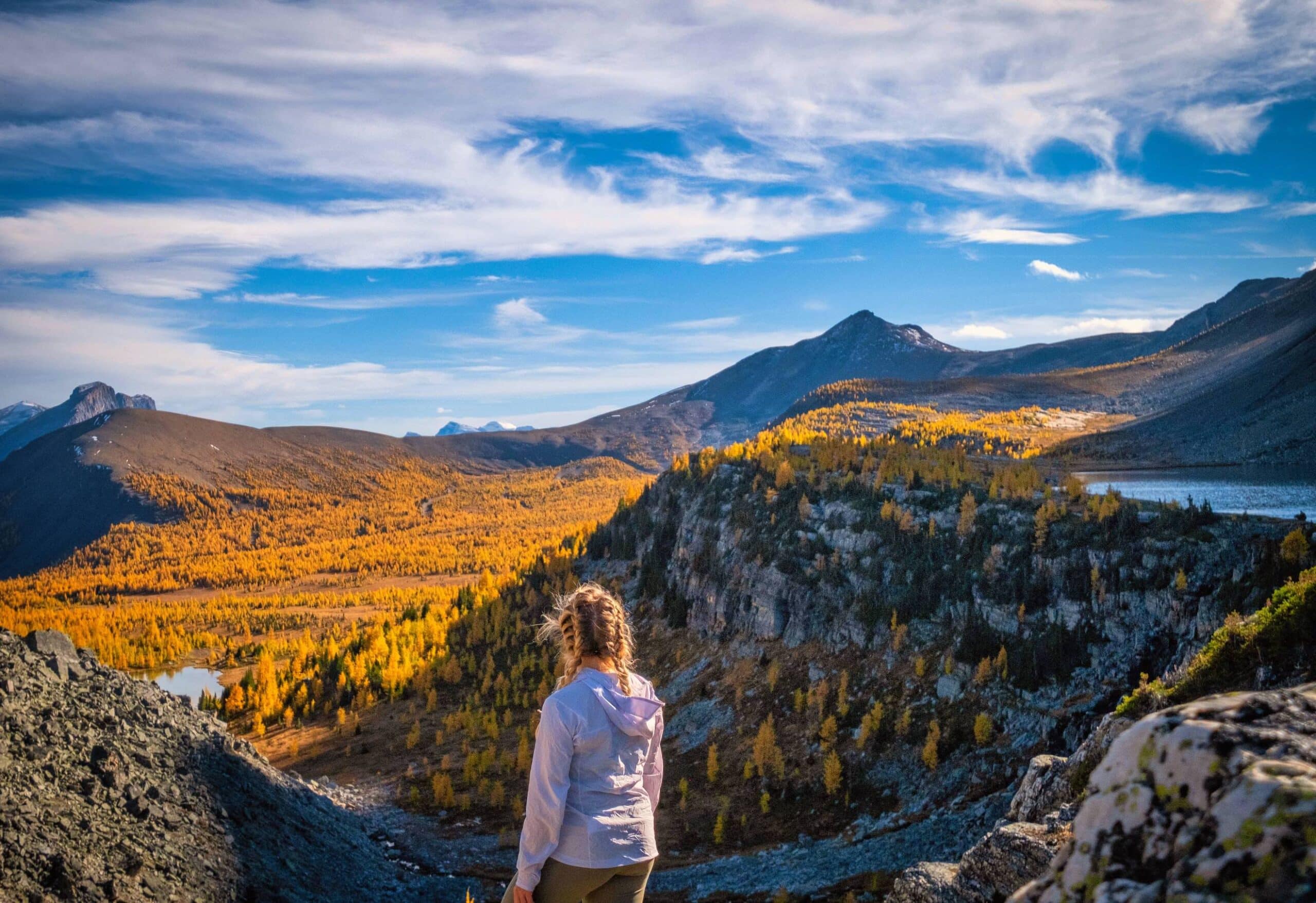
The larch season in Alberta is our favorite season to go hiking in the Canadian Rockies. While visitors flock to see the Canadian Rockies throughout the summer, the last few weeks provide cool weather, great light, and incredible landscapes with snow-capped peaks and fall colors.
The larch needles turn gold during the last few weeks of September, and the aspen trees’ fall colors last even longer. It’s a time when flannels, sweaters, and hot chocolate are all the rage. We share plenty of easy, moderate, and hard options if you’re wondering about some of the best larch hikes in the Canadian Rockies.
What is a Larch Tree?
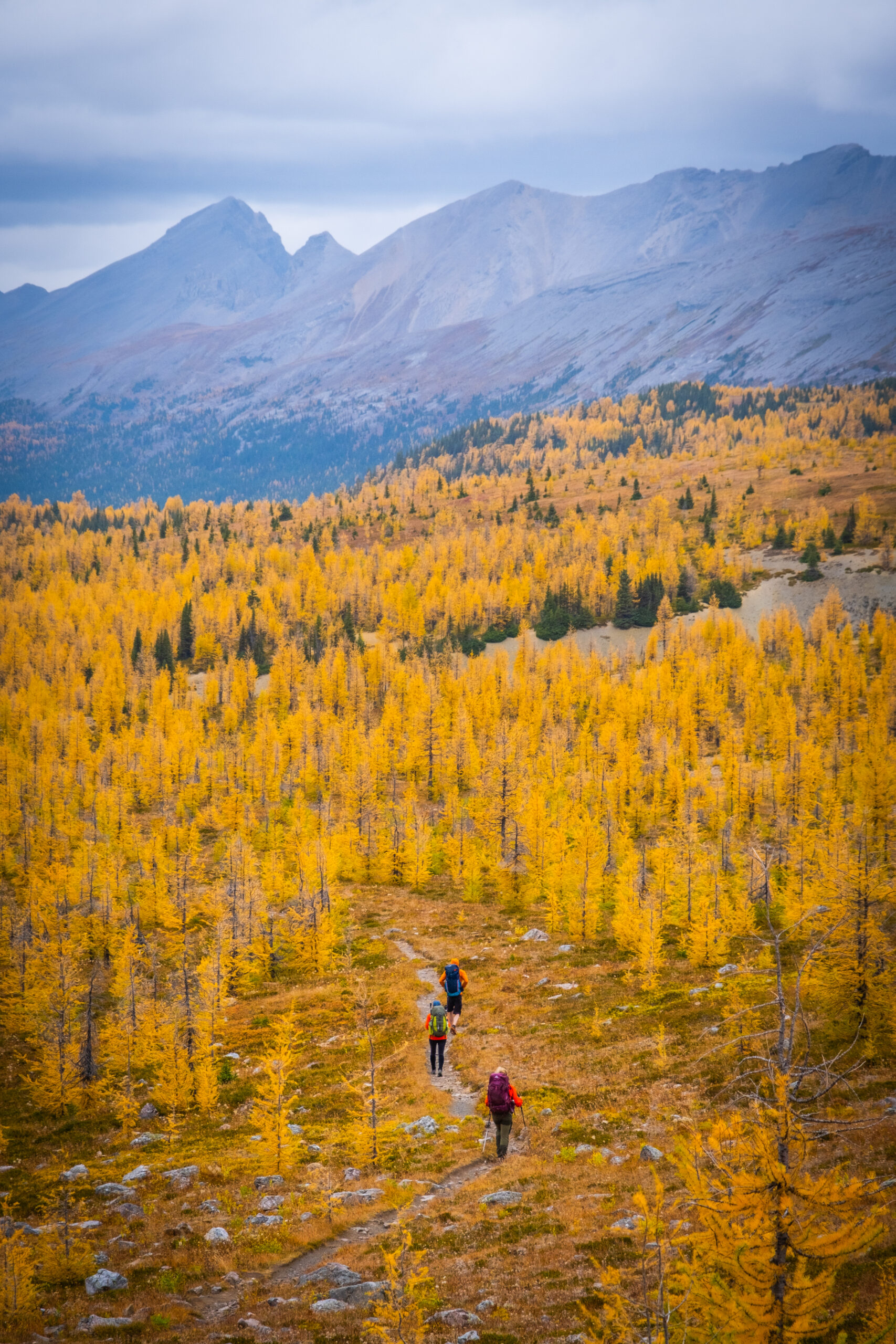
Larix lyallii, or alpine larches are conifers native to cooler temperatures. Although conifers, they are deciduous and lose their needles in the autumn. Right before they lose their needles, they turn a beautiful golden color for a few short weeks, creating a fantastic scenic landscape that people flock to see.
Identifying a larch tree in the summer season can be challenging among the other evergreen conifer trees, as everything is green! However, if you want to be on the lookout for larches, look at the needles. Their buds bear a cluster of needles, and an Alberta larch tree has soft, fragile needles to the touch. They look a lot different than other pine trees, and you can spot them easily over time.
When is the Best Time To See the Larches in Banff?
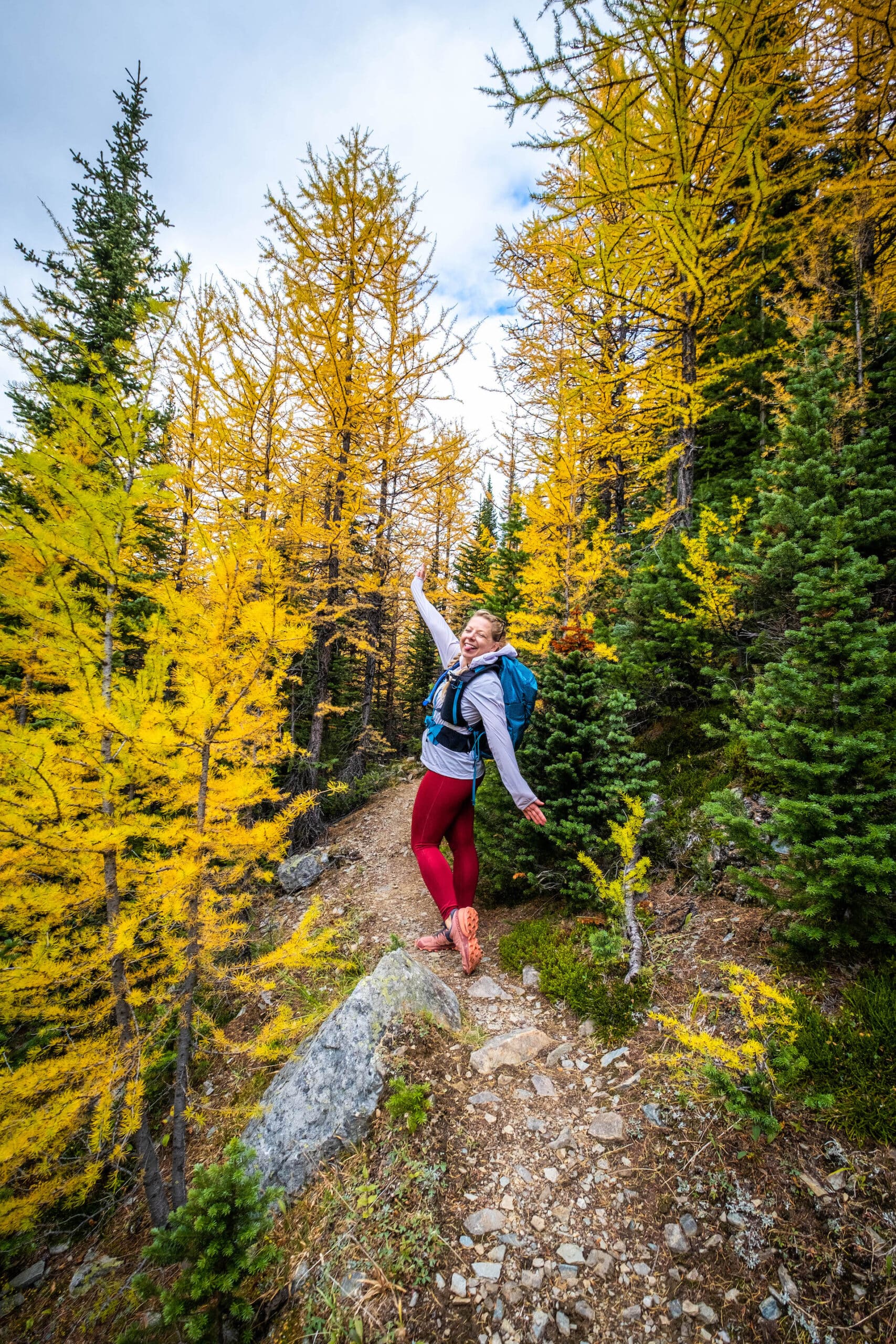
I should emphasize that every year is different in the Canadian Rockies, and the time the larch needles change from green to yellow depends on several factors, like the weather and temperatures.
However, you can typically count on frolicking through a sea of golden goodness by the third week of September every year. Most larch needles have dropped by the second week of October, and winter is approaching fast.
Fall in Banff is very short, but it is terrific. If you are basing a whole trip around seeing the larches, I suggest planning a trip between September 20th and October 5th—give or take a few days. Most of the photos here were taken during that period.
Best Larch Hikes in Banff National Park
Larch Valley and Sentinel Pass
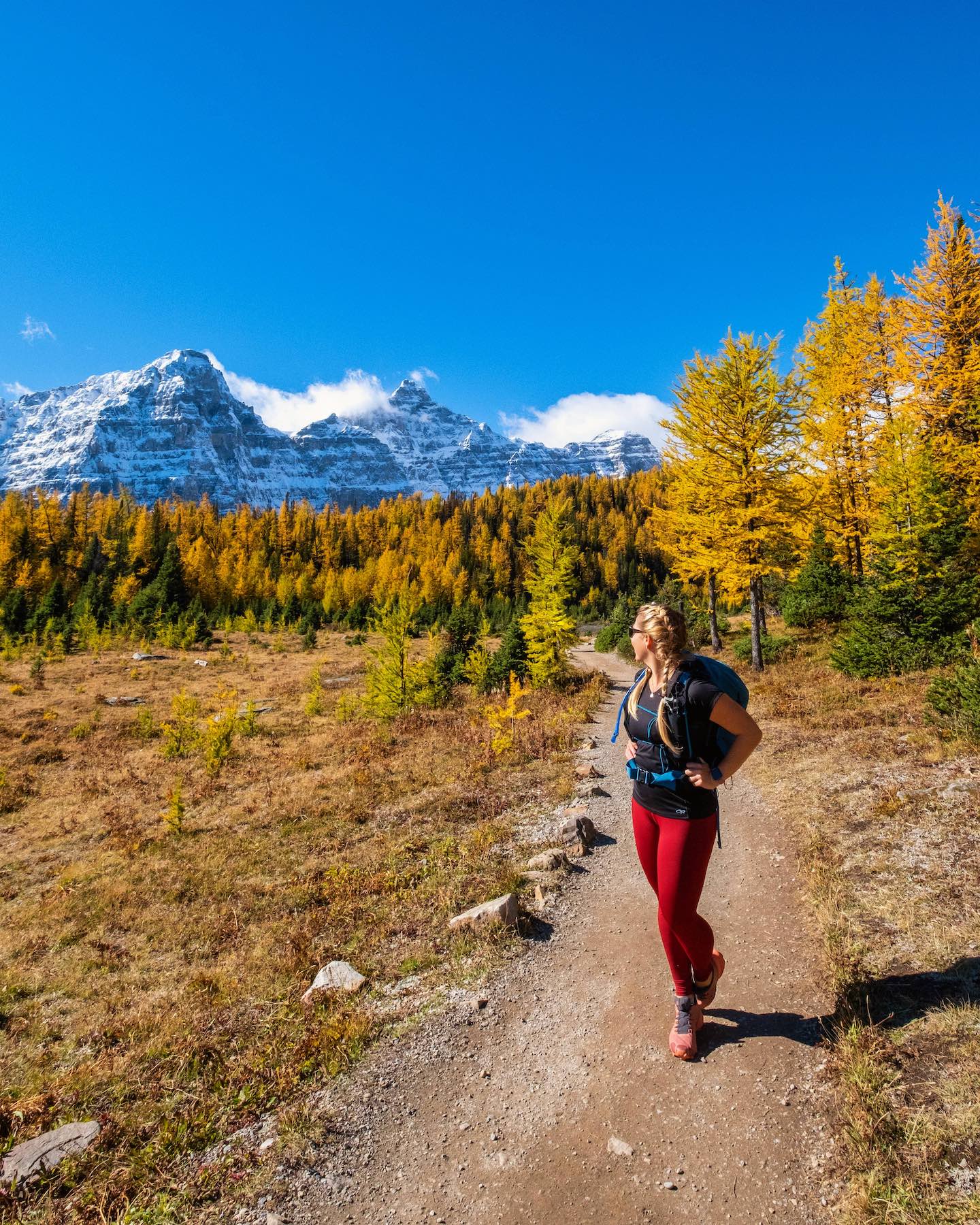
Sentinel Pass is relatively challenging, hugely popular, and offers some of Canada’s most stunning natural scenery. The hike through Larch Valley and up to Sentinel Pass is the quintessential Canadian Rockies hike and definitely one of the best larch hikes in Banff. However, it’s also easily the most crowded.
The route starts at Moraine Lake and follows a series of switchbacks as it climbs 350 meters until you reach Larch Valley. At the fork, you’ll follow the trail to the right towards Sentinel Pass and quickly be surrounded by a sea of larch trees.
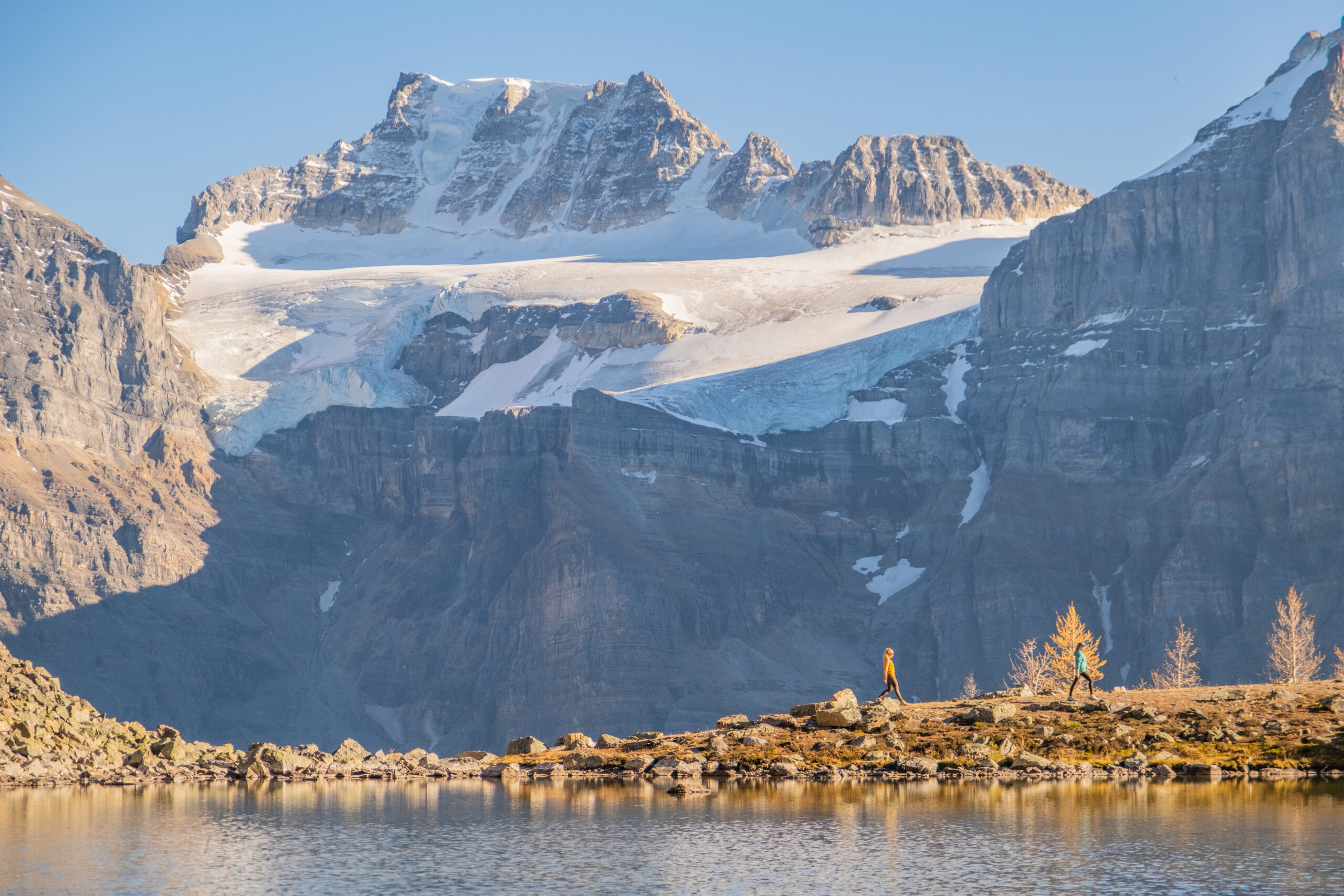
Take your time exploring Larch Valley and head to Minnestimma Lake for views of the Ten Peaks over the small pond. During this time, the peaks are often topped with fresh snow, and the golden larches create an incredible contrast for photographers.
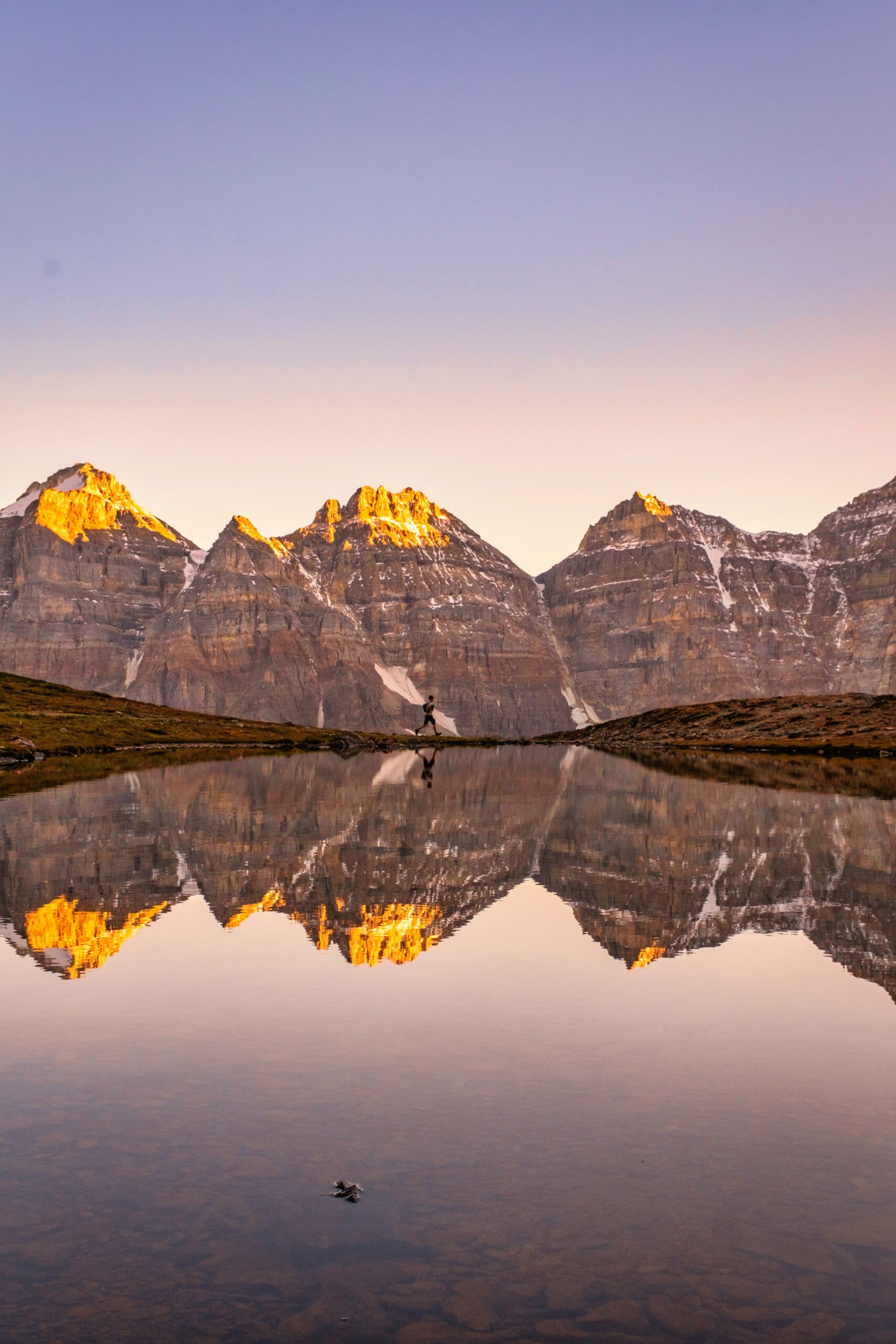
Those with the energy should continue up to the top of Sentinel Pass, which gains another 200 meters from Minnestimma Lake. The views from the top of the pass are spectacular in all directions, particularly down the backside towards Paradise Valley.
It’s a soul-stirring scene that can easily be considered one of the best day hikes in the world, especially in the larch season. To beat the crowds, we recommend catching a sunrise shuttle to Moraine Lake, either on the Moraine Lake Bus Company shuttle or the new Alpine Start shuttle.
Paradise Valley
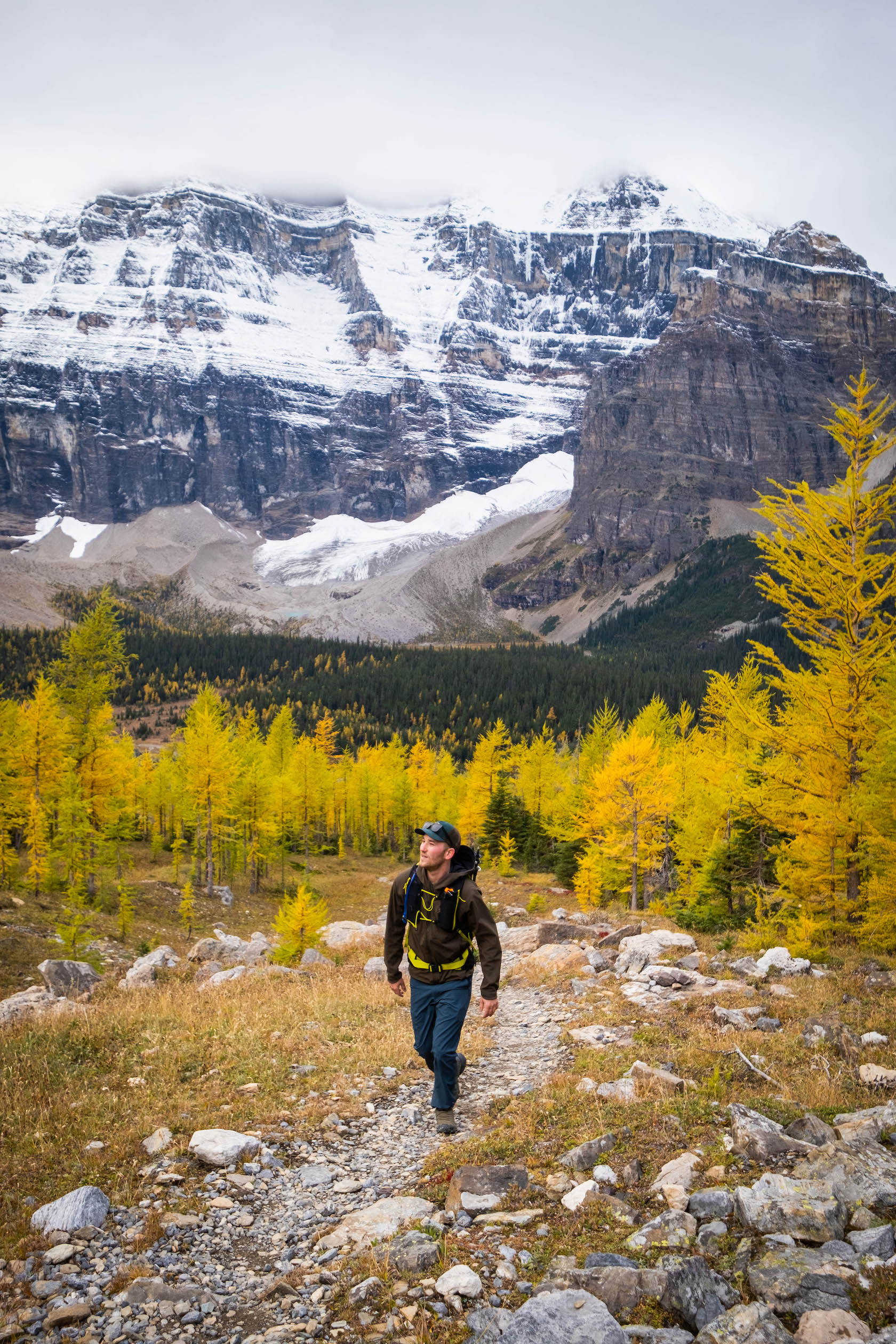
The Paradise Valley Trail runs the length of Paradise Valley and can be accessed from Sentinel Pass. It leads to Lake Annette and the Giant Steps, and sections of the valley are filled with larch trees. However, due to the closure of Moraine Lake Road, the trail has become more difficult to access.
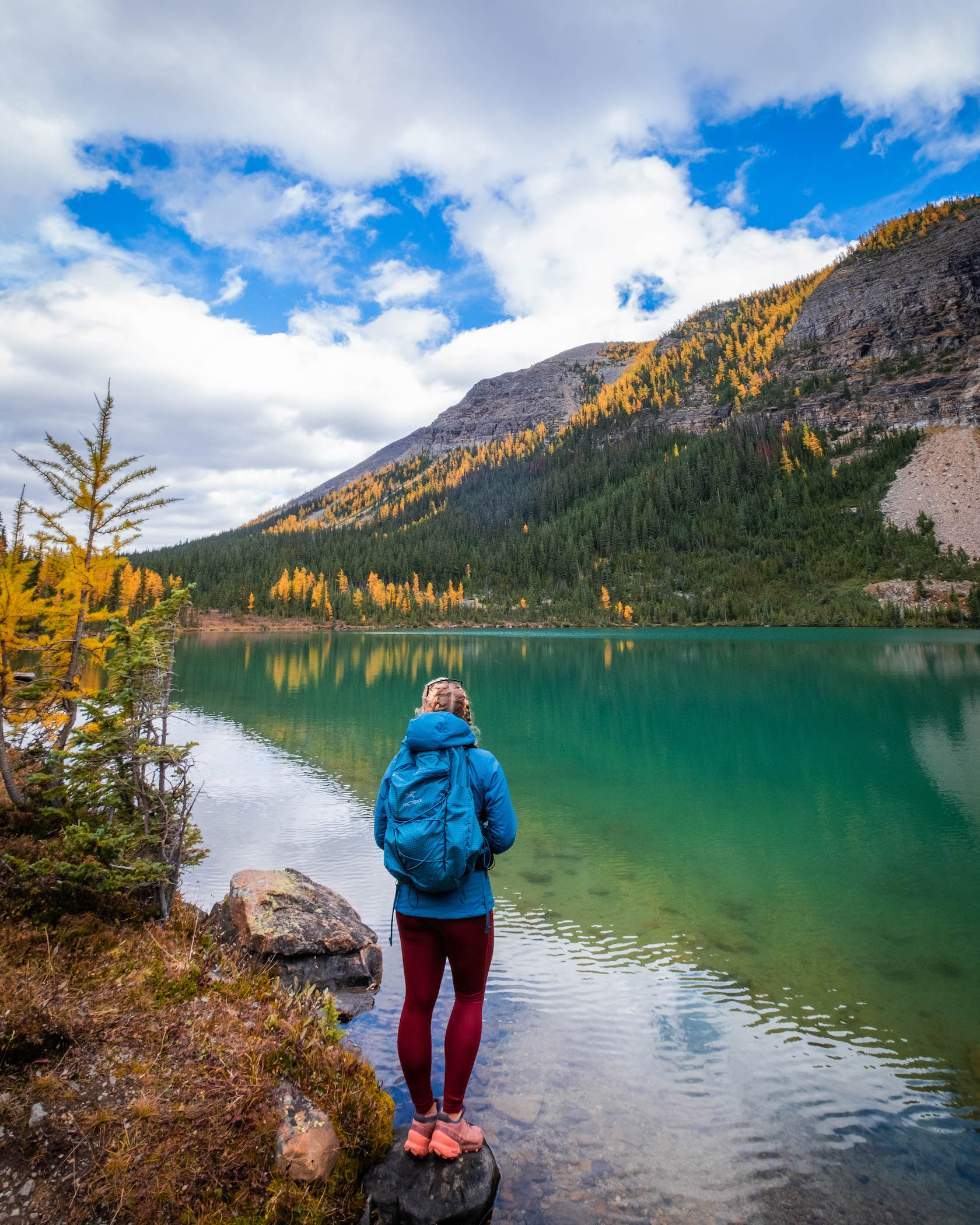
That’s why we recommend connecting it with Sentinel Pass and using it to hike from Moraine Lake to Lake Louise. It’s a longer day best suited for strong hikers, but it’s quite possibly our favorite hike we’ve done in the fall. The reward for hiking past Sentinel Pass and getting off the beaten path is a trail all to yourself.
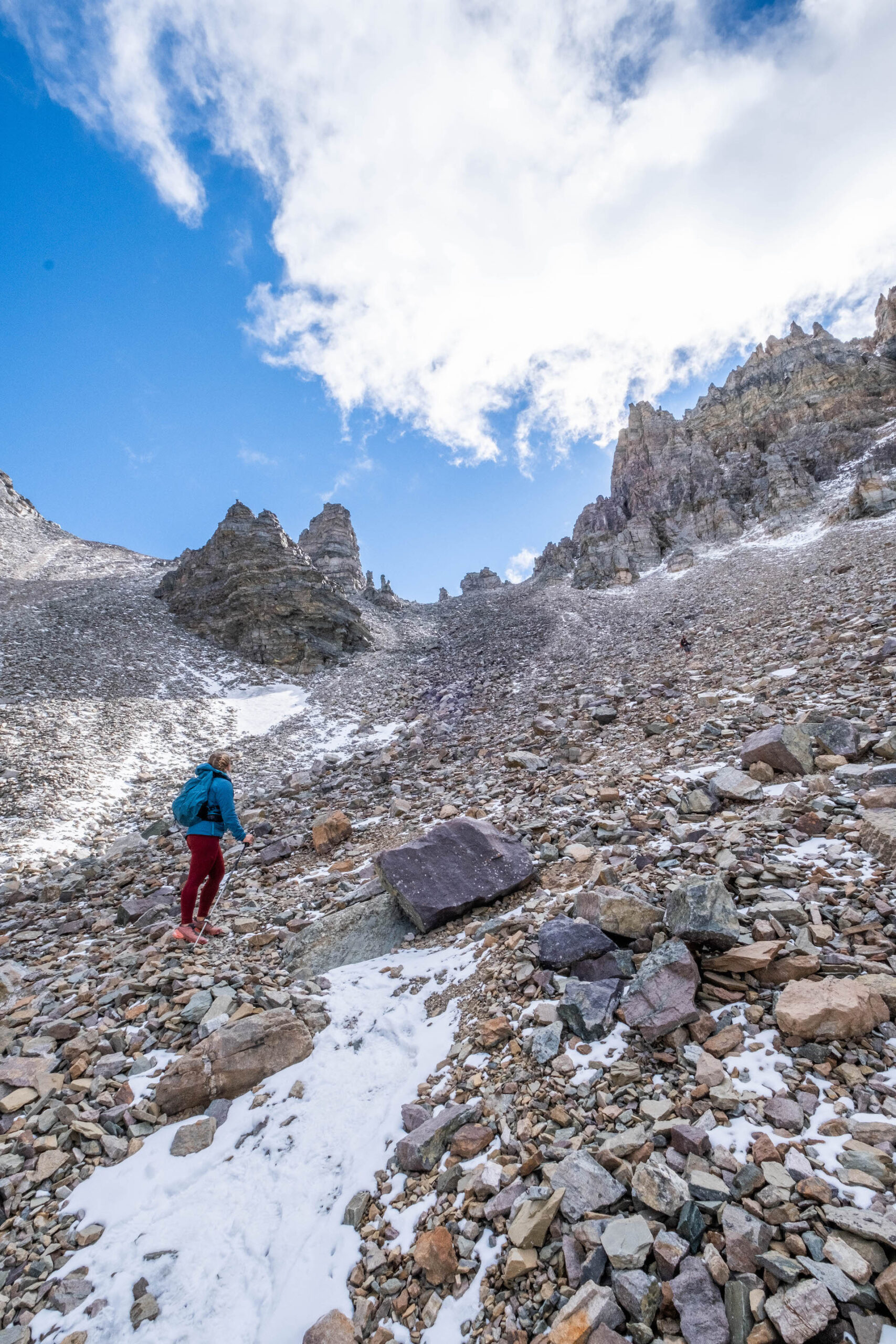
Although the hike can start at either Lake Louise or Moraine Lake, it is best to begin at Moraine Lake. Then, hike up to Sentinel Pass and drop down into Paradise Valley. This ensures hikers gain most of the elevation on a well-worn trail up to Sentinel Pass and descend on the rough scree trail to Paradise Valley rather than ascending up to it. (See the photo above for this section.)
Along the whole route, hikers pass through thousands of larches while hiking under Mount Temple. Head up to Saddleback Pass for even more beauty! We recommend studying a map before tackling this trail, as you can tackle many route options.
Saddleback Pass/Sheol Valley
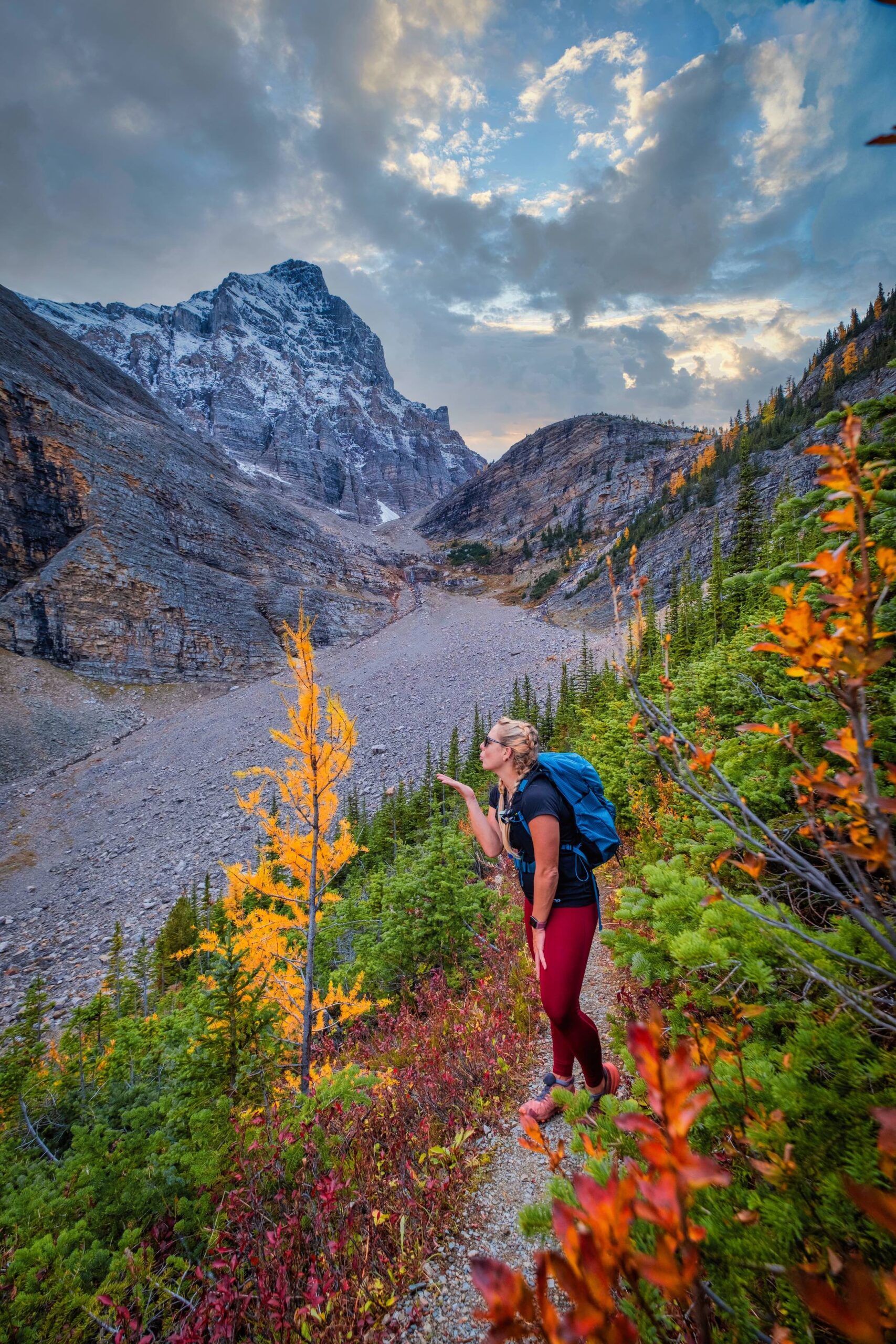
One of my favorite larch hikes that not many seem to talk about is the hike up to Saddleback Pass and through the Sheol Valley. If you want to escape the crowds at Lake Louise or Moraine Lake, this larch hike is for you. This hike is best done from Lake Louise, but we connected it with our long day on the Paradise Valley Trail, which is also possible.
From Lake Louise, you’ll start towards the trail to the Fairview Lookout and continue on the path up to the summit Fairview Mountain. You’ll enjoy Mount Temple, Haddo Peak, and Sheol Mountain views from the top of Saddleback Pass.
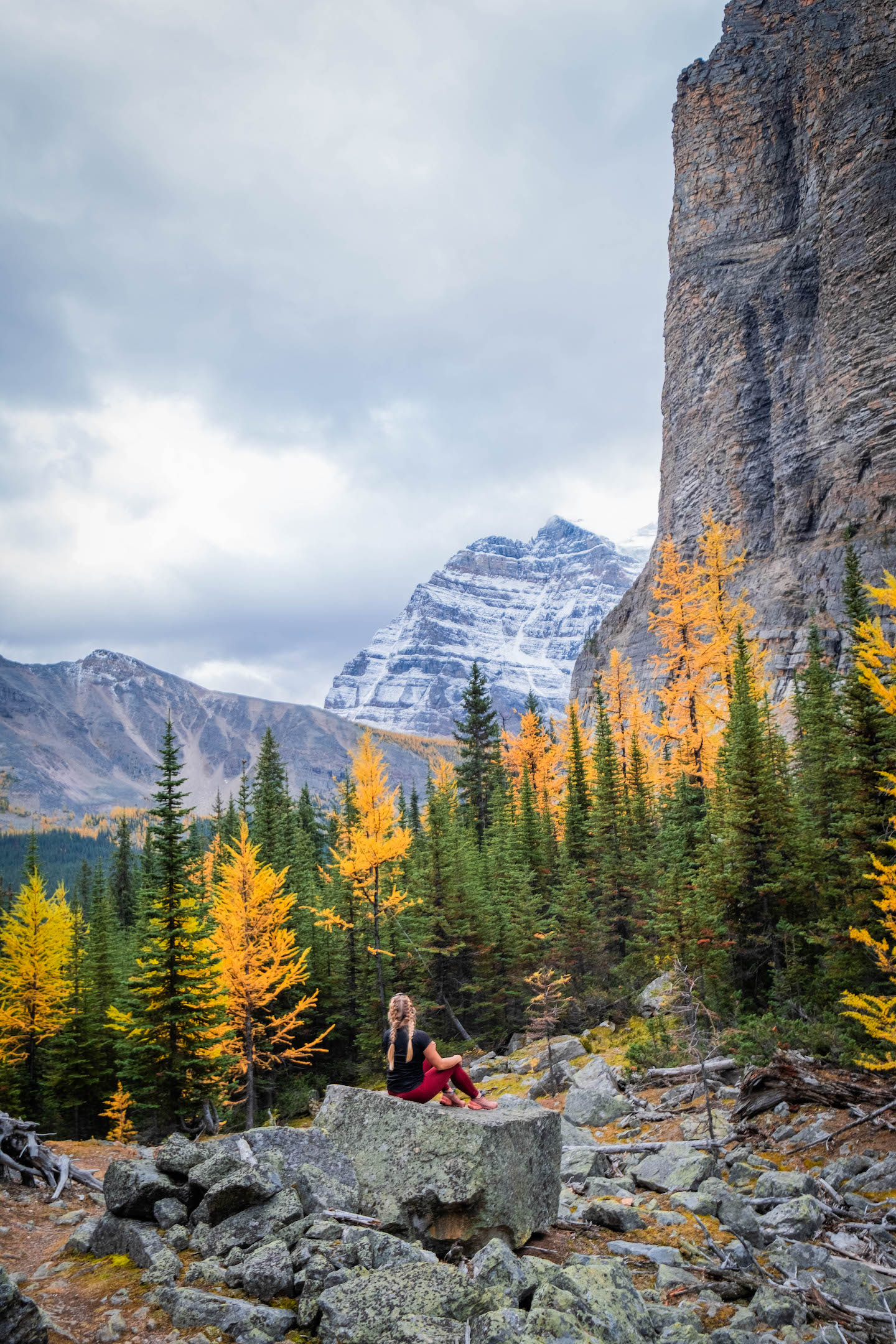
At the top of the pass, there is signage to continue through Saddleback Pass and to the Sheol Valley to loop back around to Lake Louise. Alternatively, you can continue up Saddle Mountain or Mount Fairview. All are great quiet options you could hit on a single day if you have the time and fitness. We highly recommend taking the Sheol Valley Trail, which loops around Saddle Mountain on a well-distinguished trail until you reach the lake connector trail.
As mentioned above, we had a 24 km day that allowed us to cross Saddleback Pass off the list. With a start at Moraine Lake, up to Sentinel Pass, down through the Paradise Valley Trail to Lake Annette, and onwards through the Sheol Valley to Saddleback Pass, up to summit Saddle Mountain, and down to the Lake Louise Chateau.
It made for very long, but utterly epic day in Banff that was absolutely full of wonderful golden larches nearly the whole time. We highly recommend looking at a map for reference if all these trail names are confusing.
Saddle Mountain
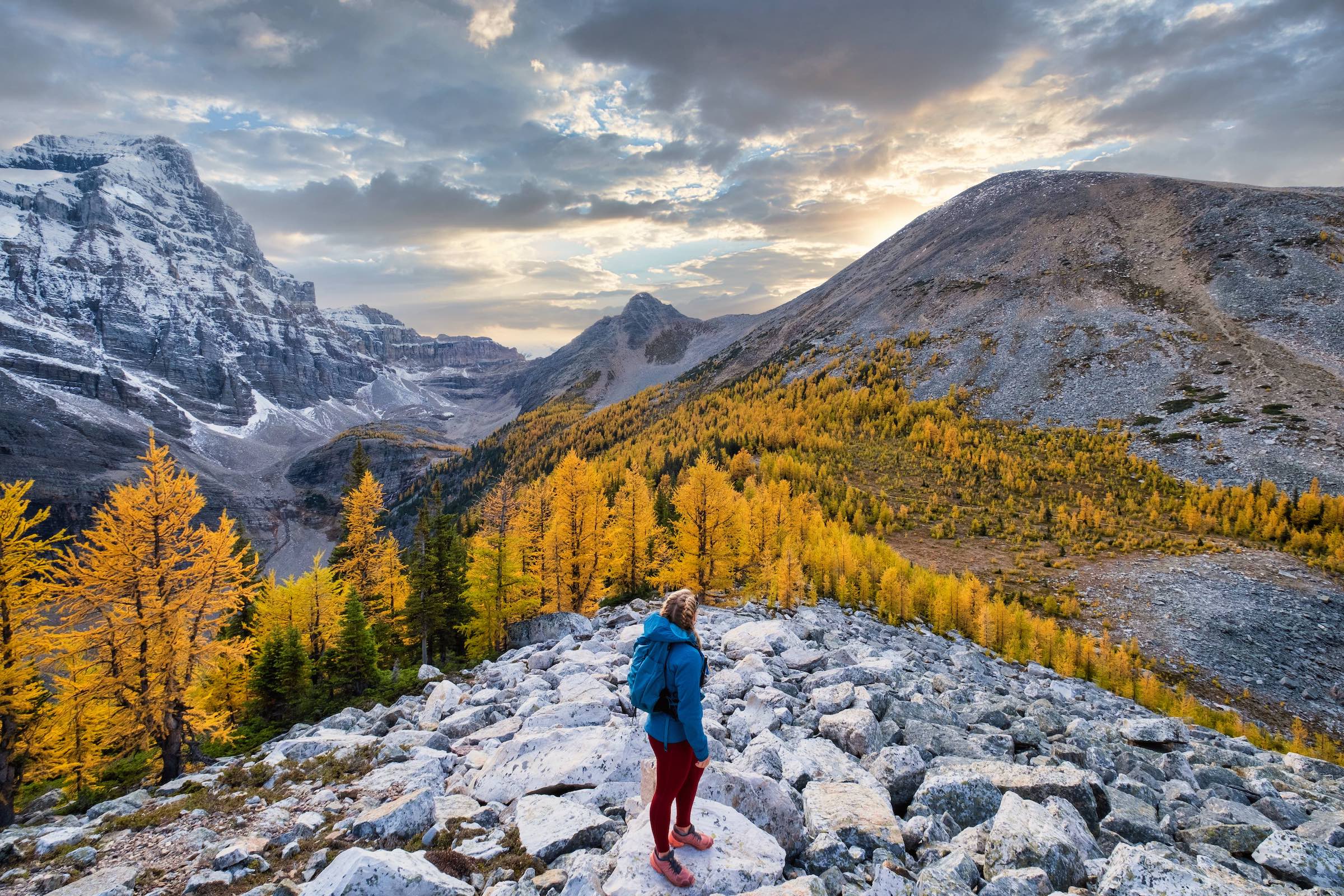
If you are looking for an accessible mountain summit to bag, Saddle Mountain is for you. I had Saddle Mountain on our list since we saw it from the summit of Mount Fairview a few years back. It looked like a simple and straightforward summit. However, I didn’t know how amazing the views would be from the top – especially when the larch trees turn golden in the autumn.
If you are already heading up Saddleback Pass anyway, taking the extra 30-60 minutes to ascend Saddle Mountain is well worth it. It took us about 15 minutes to climb around 100 meters to the summit from Saddleback Pass; however, there is no well-worn trail up here, and you’ll be hiking on a boulder field, so surefootedness is required.
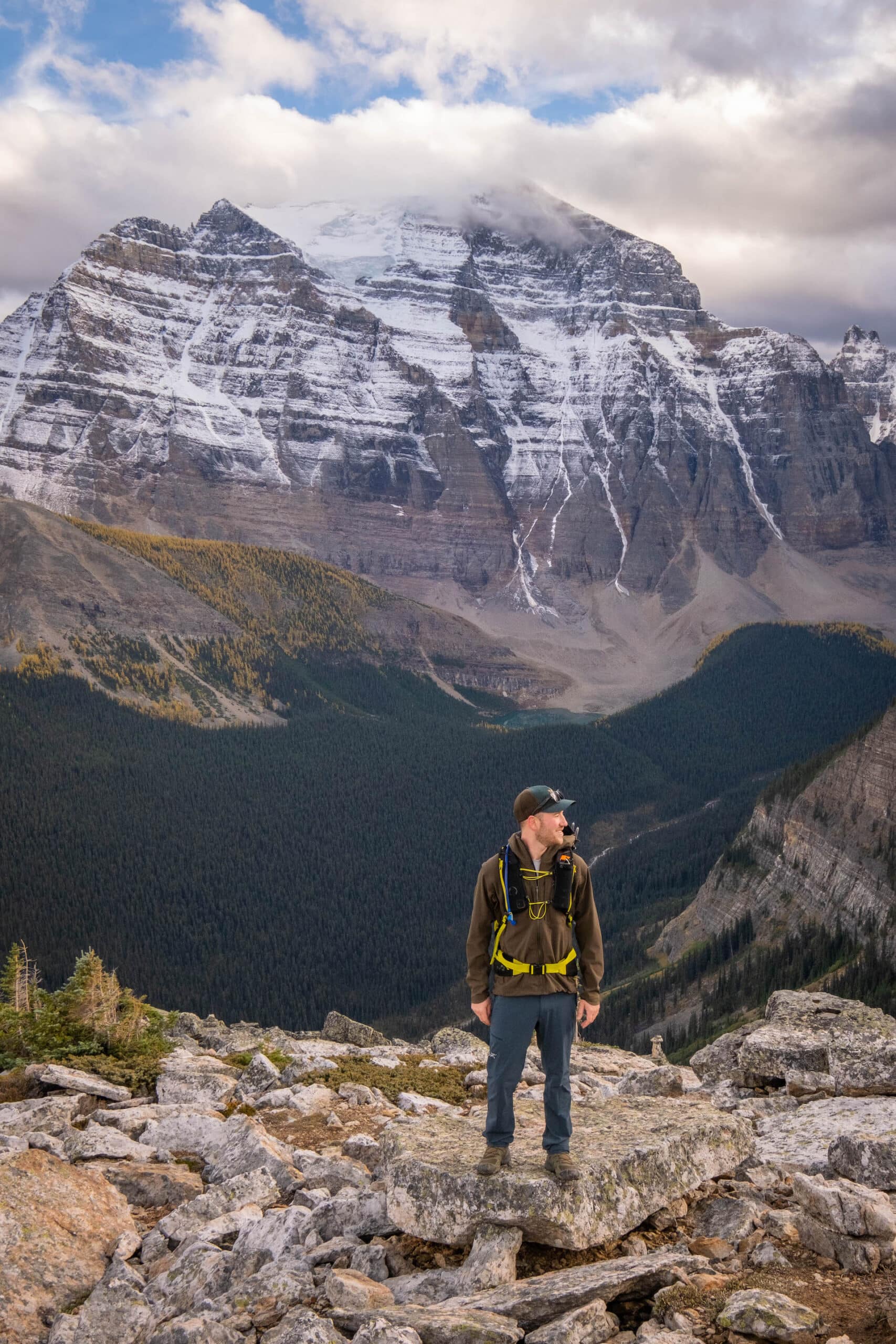
From the top of Saddle Mountain, you’ll get the most beautiful view I’ve seen yet of Mount Temple. On a clear day, you can even see all the way down the Bow Valley – we got a glimpse of Mount Assiniboine from here! Saddle Mountain was much more enjoyable to me than Mount Fairview across the way, which is a steep scree slog the entire way up (and not a great larch hike anyway!)
Lake Annette

I mentioned Lake Annette above, talking about the Paradise Valley Trail. That hike may be longer than most are seeking, so we recommend hiking the trail from Lake Louise to Lake Annette. Alternatively, hikers can head to the Paradise Valley trailhead on Moraine Lake Road.
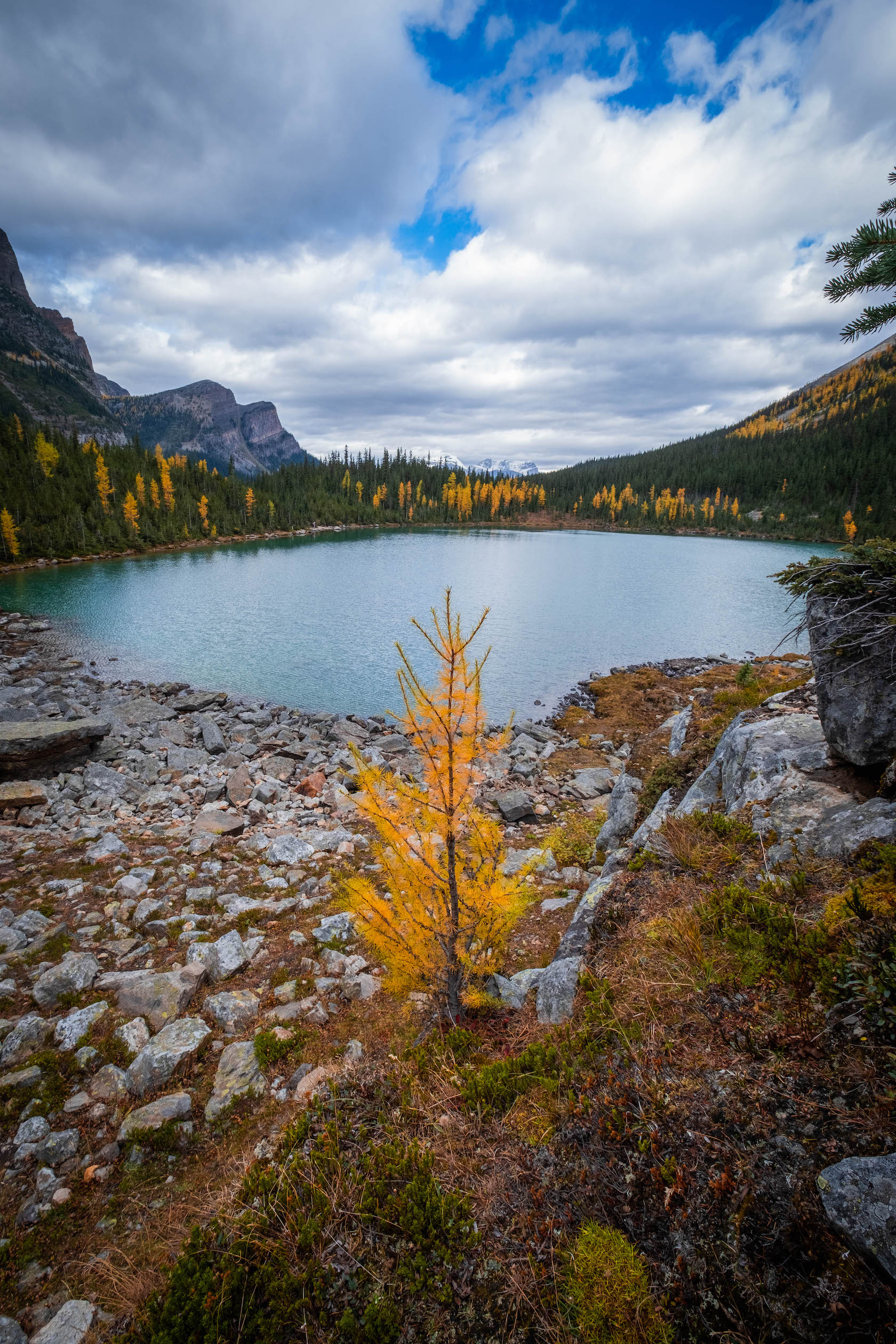
As hikers can no longer park at the trailhead, they must take the Moraine Lake Shuttle. They must tell the driver where they need to get off. The trail in Lake Annette is easy to moderate, with less than 400 meters of gradual elevation gain. For most of the trail, you’ll be in the forest, but you’ll get some stunning views of Mount Temple and hike through larch trees around the lake.
Rockbound Lake
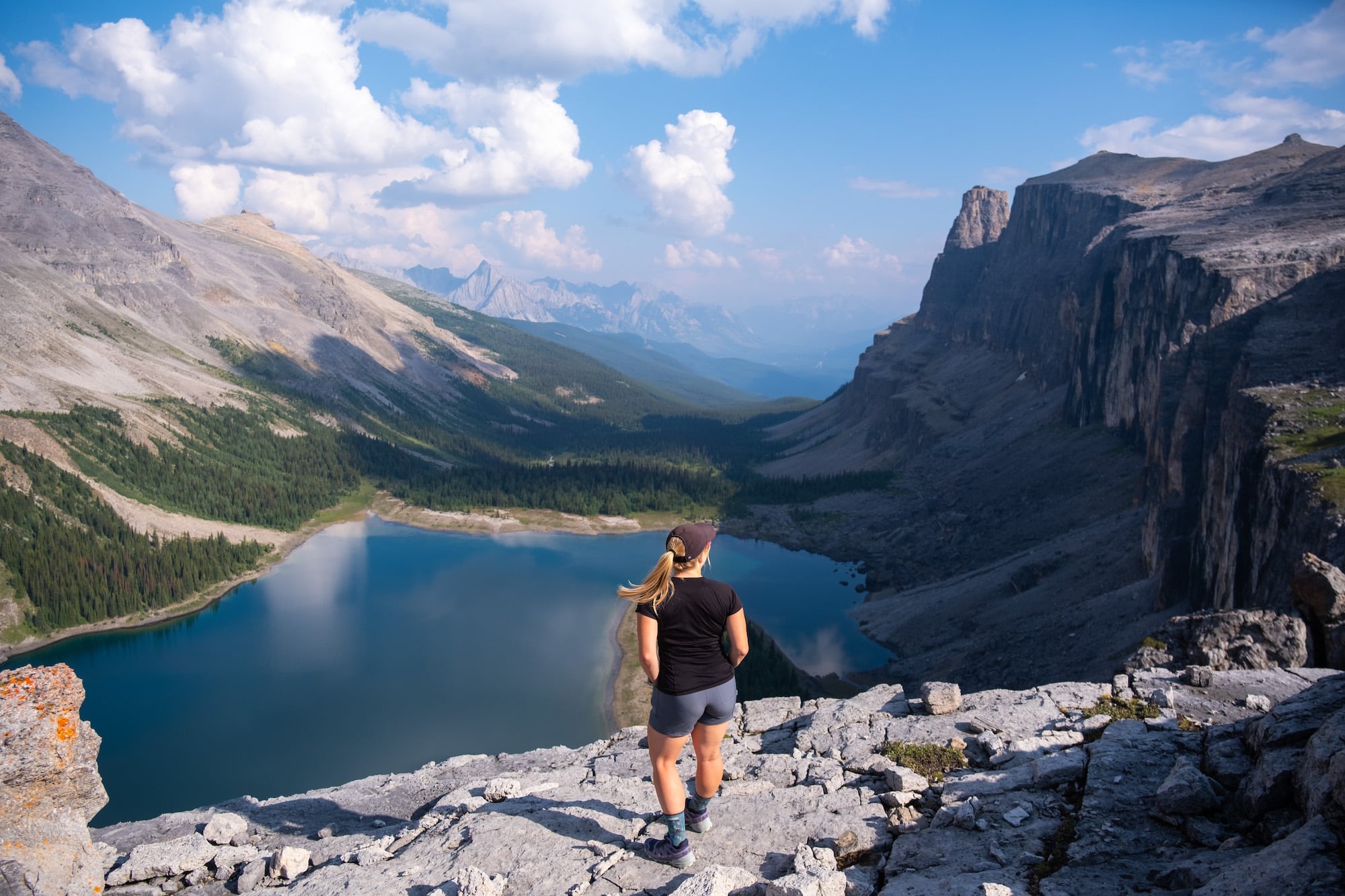
Rockbound Lake is a long and boring trail until you reach Tower Lake. However, if you decide to tackle the mundane trail, you’ll be rewarded with a stunning lake set in a large amphitheater surrounded by larches. It’s less frequented than most hikes on this list due in part to its length and elevation gain.
The larches around Rockbound Lake are phenomenal, and if you hike the steep trail above the you get a superb panorama of the lake below you. If you have the legs and stamina for a long day, we recommend continuing on to the summit of Castle Mountain.
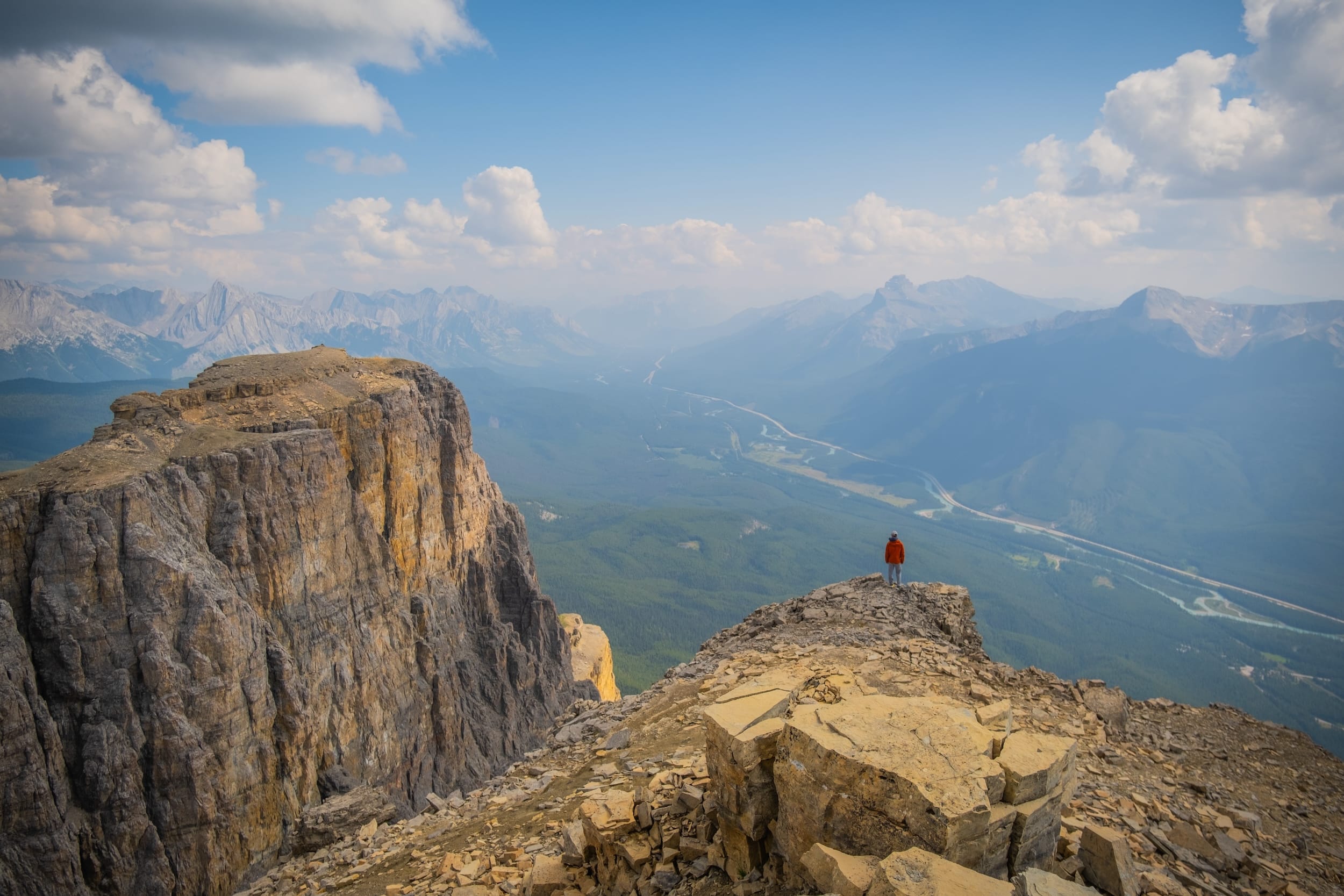
Though there are no extra larches on this route, you get to say you have bagged the summit, one of the most iconic peaks in the Rockies. Be forewarned that getting to the summit of Castle requires a 30km day with 1500 meters of elevation gain. Well worth it, though! Also, if we’re splitting hairs it’s not technically the true summit.
Arnica Lake/Twin Lakes/Gibbon Pass
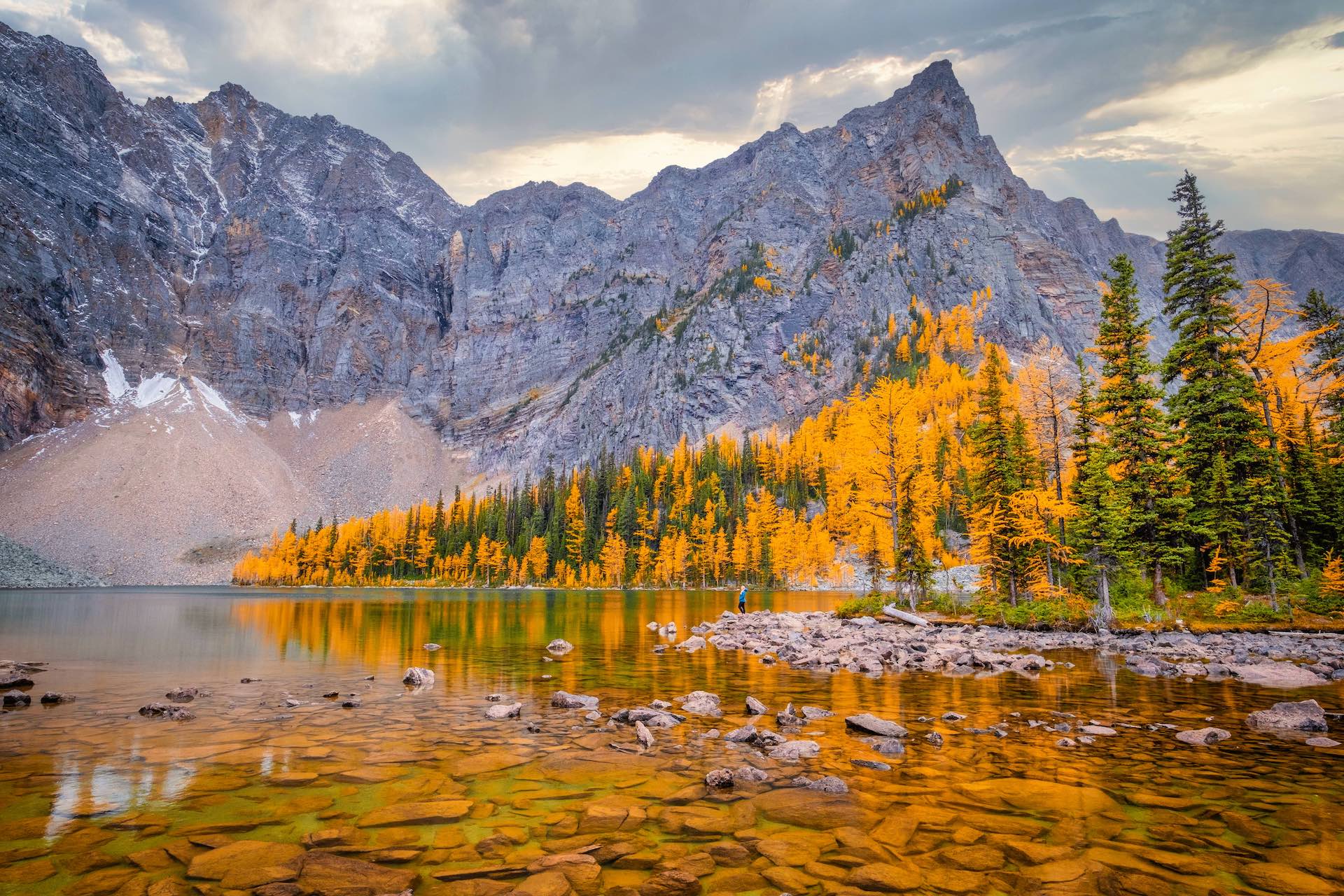
I had little idea that this area was known for larches until we pulled off to check out Vista Lake and saw all the larches surrounding Storm Mountain. The hike starts off with one of the favorite secret viewpoints of Vista Lake. From the trailhead and small parking lot, the trail descends to Vista Lake and continues to Arnica.
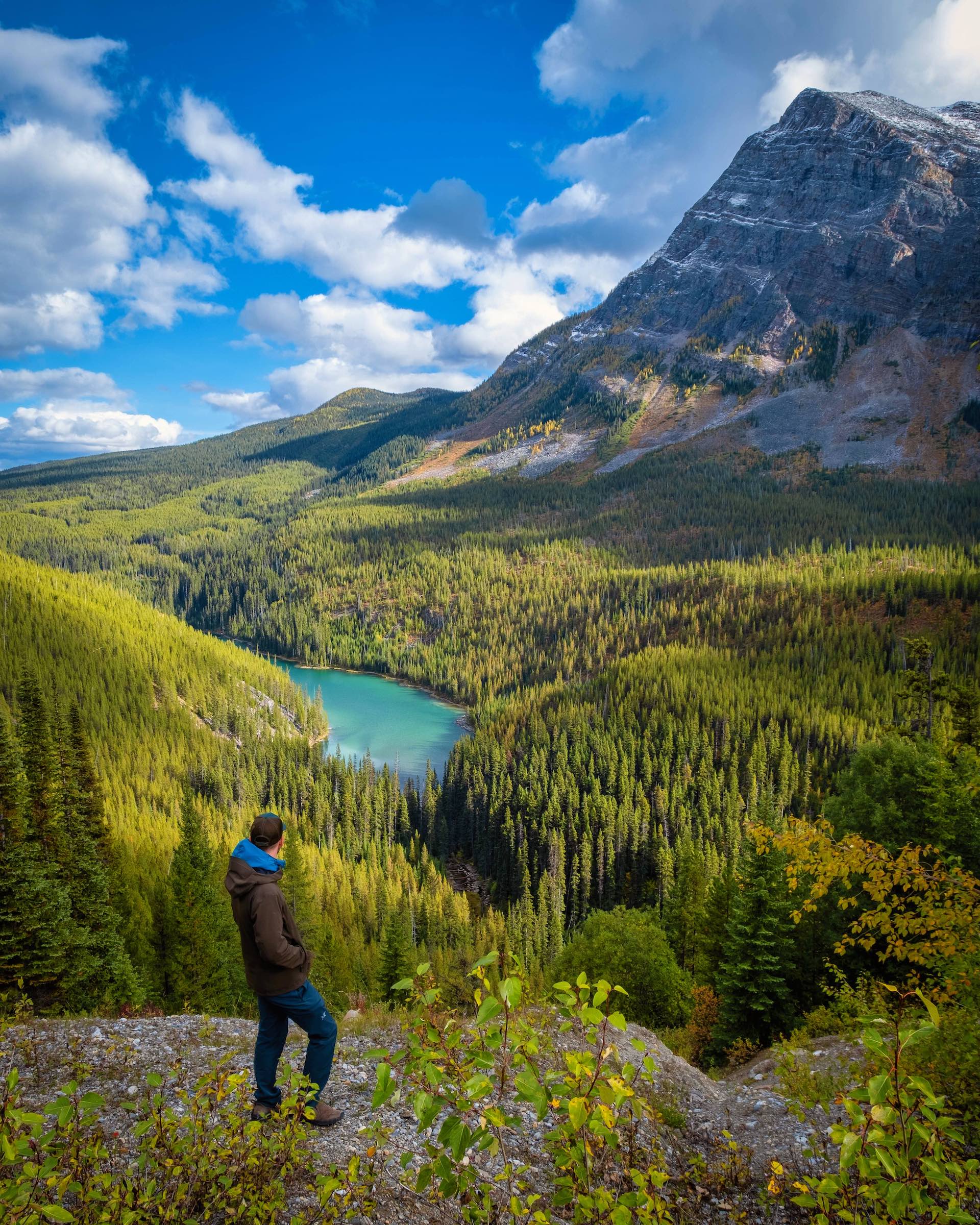
Once you pass Vista Lake, there are minimal views until you get to Arnica Lake. The trail is quite rooty and fairly steep, but it’s 750 meters spread over 5 km, so there are plenty of chances to take it slow and relax among the trees.
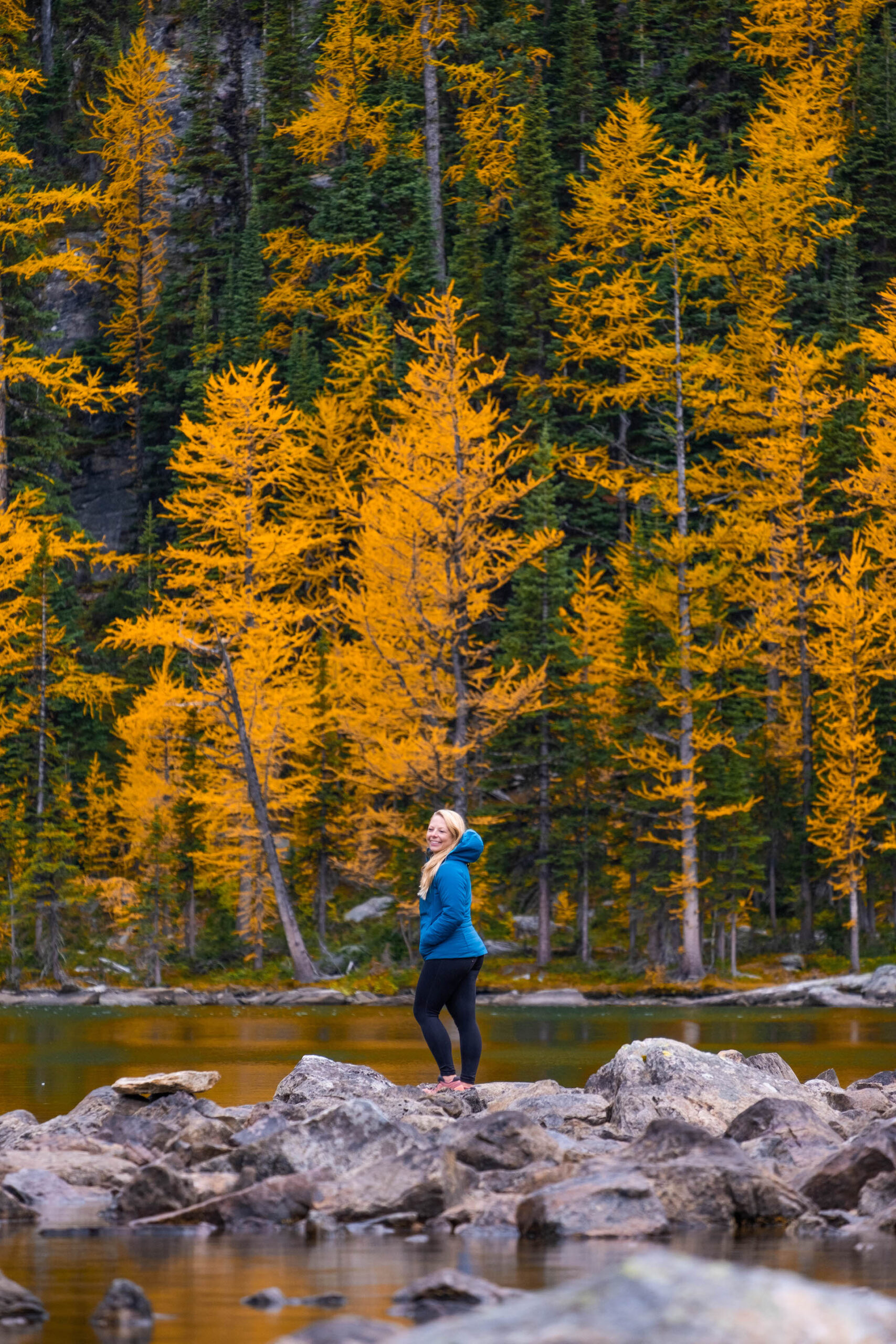
Once you get to Arnica Lake, you’ll be amazed by the views and the golden larch trees among the evergreens. If you want to hike further, you can continue to Twin Lakes, where you can camp at Twin Lakes Campground. For a truly epic circuit, you can hike up to Gibbon Pass.
This whole circuit makes for a great backcountry trip. You can hike 15 km to Shadow Lake and stay at the Shadow Lake Campground, or continue to Ball Pass Campground, then to Scarab and Mummy Lakes to end at the Sunshine Parking lot. There are so many great options in this area for a two, three, four, or five-day backcountry trip, so we recommend looking at a map if this is what you are seeking!
Healy Pass (+ Egypt Lake Extension)
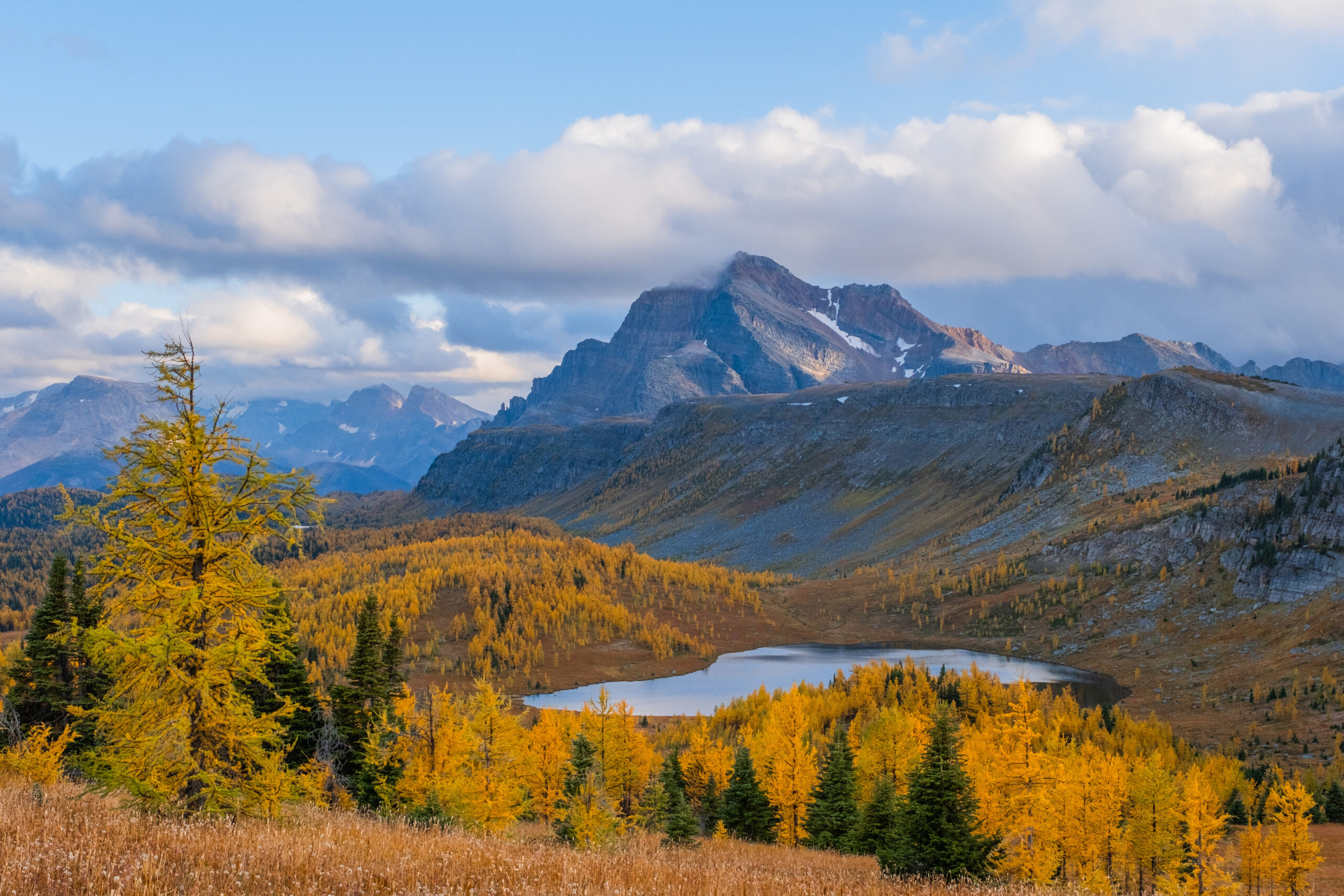
Healy Pass is one of our favorite hikes in Banff. It’s a great adventure in the summer for the wildflowers, but it’s even better in the fall for the larches. From the Sunshine Village parking lot, the trail gradually climbs through a lush, shaded forest. The accessible grade makes the longer hike much more approachable for novice and intermediate hikers.
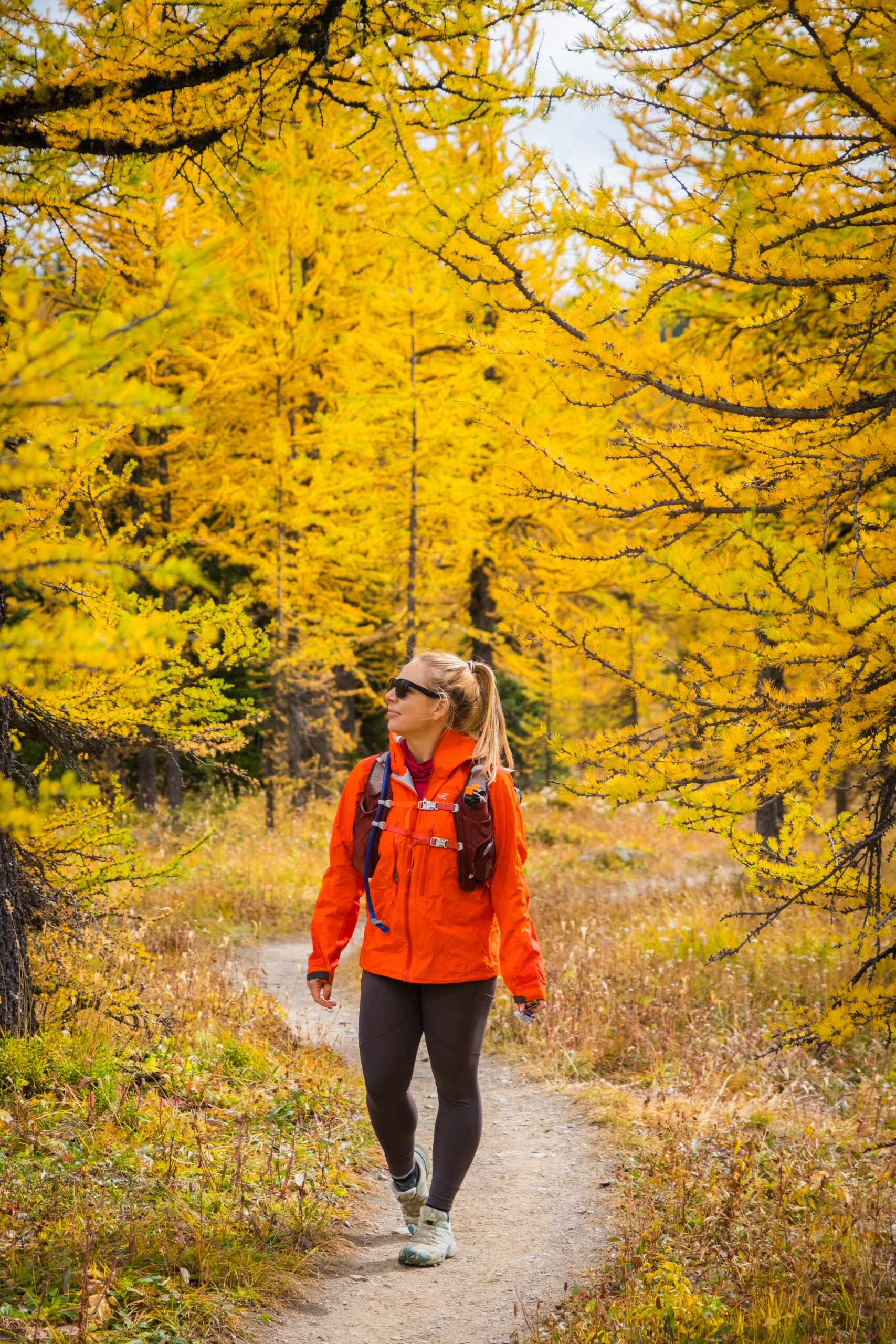
As hikers work through the woods, they cross bridges, creeks, avalanche paths, and one infrequently used backcountry campsite. Some complain about the monotony of a long approach through the trees, but we find it relaxing. After 7.5 km, the forest gives way to a sprawling alpine meadow dotted with patches of larch trees—it’s one of the best places to witness them in the park.
Once you’re in the meadow, the hike provides expansive views of lakes, rolling hills, and towering peaks in the distance. If you have the energy, you can summit Healy Pass Peak, the unofficial name for the high point north of Healy Pass. Or, for a very epic adventure, continue to Egypt Lakes or perhaps scramble up Pharoah Peak (over 2000 meters of gain!) for a massive day out!
Skoki Range
This is hands down my favorite area to see the larches and in general. I note this as one area rather than a particular trail because the options are endless. The only downside is that it requires some leg work to reach, which keeps the area quiet. We’ve traveled back here a few times in the larch season, and every time, we find new views we have never seen before. A sense of adventure and route-finding help us explore here!
Although the Skoki area is right next to Lake Louise Ski Resort and across the TransCanada from Lake Louise and Moraine Lake, it is far less frequented or even heard about. To access the area, start at the Skoki Lodge car park near Lake Louise Ski Resort. The start of the hike is incredibly dull, as it follows along a ski-out and maintenance road until you reach the Larch side of Lake Louise.
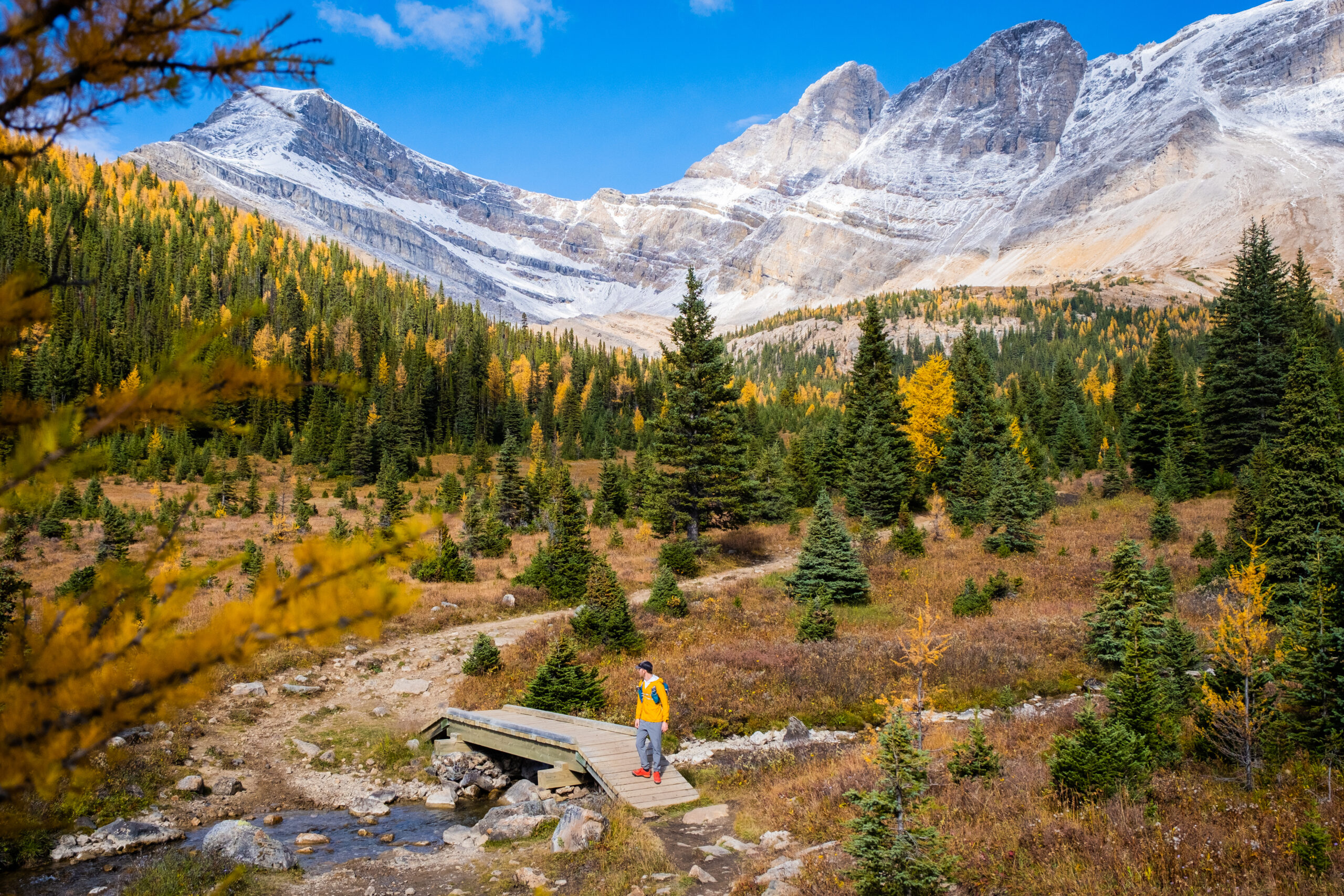
Once you reach the chairlift, you have a few more km of hiking before the fun and views begin. At about 7km, you’ll emerge from the trees into a stunning valley. Continue along the well-established trail as you encounter mind-blowing larches and impressive peaks. We saw our first wild lynx when hiking the area.
The first significant sense of accomplishment here is Ptarmigan Lake under the impressive Ptarmigan Peak. From here, you should have some understanding of where you are heading. We recommend looking at maps and planning your trip before hitting the trail.
There are many hiking trails and mountains to climb, including Mount Richardson and Brachiopod Mountain. You can also continue around Redoubt Mountain to see Redoubt Lake and possibly scramble up Unity Peak. Other options include hiking to Baker Lake and staying at Baker Lake Campground.
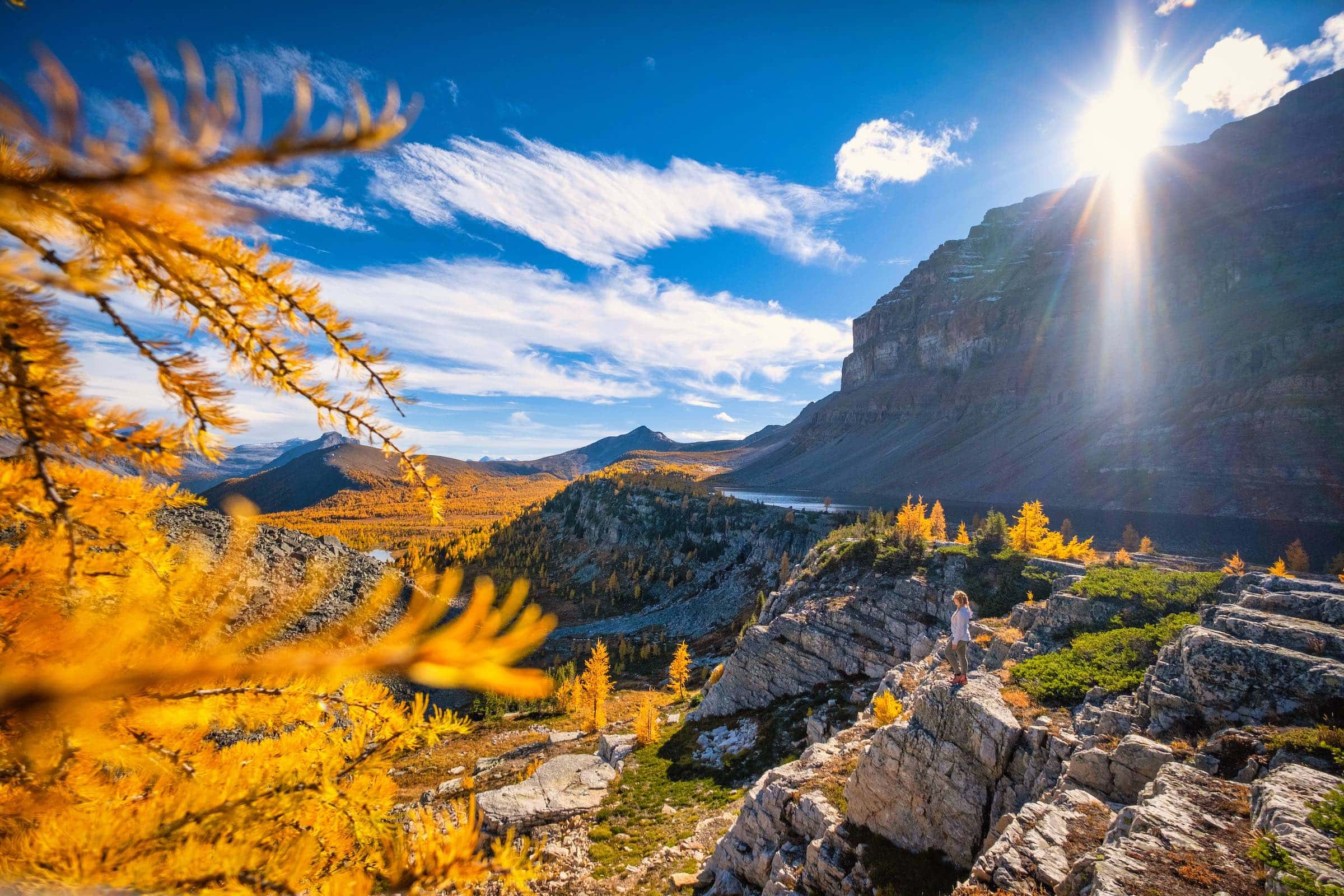
Many people hike up Deception Pass, where you can choose the trail to Myosotis Lake, Zigadenus Lake, or Skoki Lodge. Honestly, there are many options here, so you’ll have to grab a map, research, and find out which area is best for you.
Whatever you choose, be prepared for a very long day or to camp, as you will have to hike in and out for at least 18 km just to reach Ptarmigan Lake. The only way to cut out a bit of hiking is to book an overnight at Skoki Lodge, but it doesn’t come cheap and must be booked well in advance. Skoki Lodge will transfer overnighters from Lake Louise to Temple Lodge, where hikers can then start their hike – cutting out the boring access road.
Don’t want to hike back here on your own? Hop on this tour as they run guided backcountry hikes to Skoki!
Taylor Lake
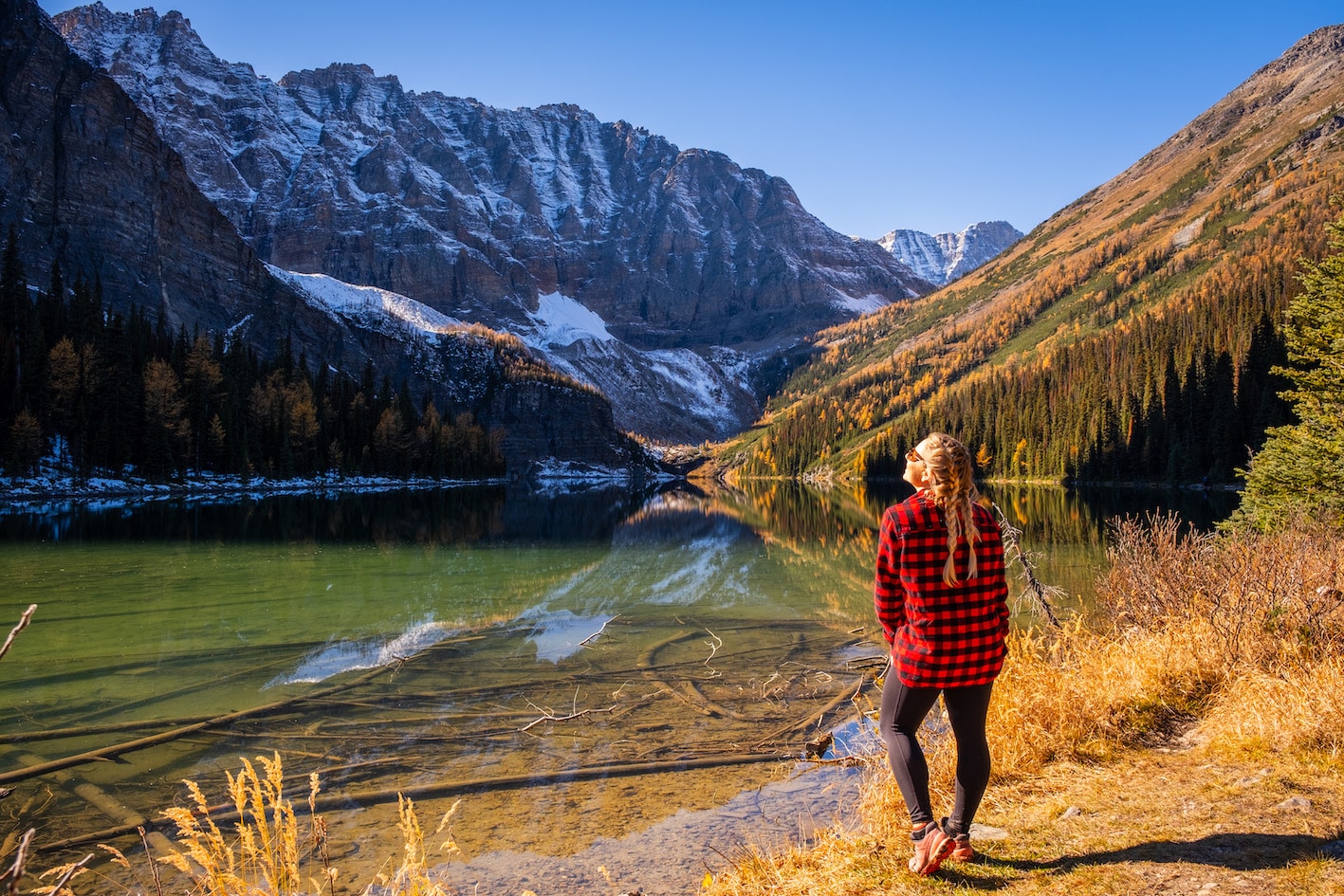
Taylor Lake sits at the base of Mt. Bell and offers spectacular views. It’s a serene place and a fantastic day out in the mountains. Honestly, it is a pretty boring hike until you reach the lake, but once you get there, you’ll be surrounded by so much yellow goodness that you’ll forget about the uneventful uphill walk in the woods to get there.
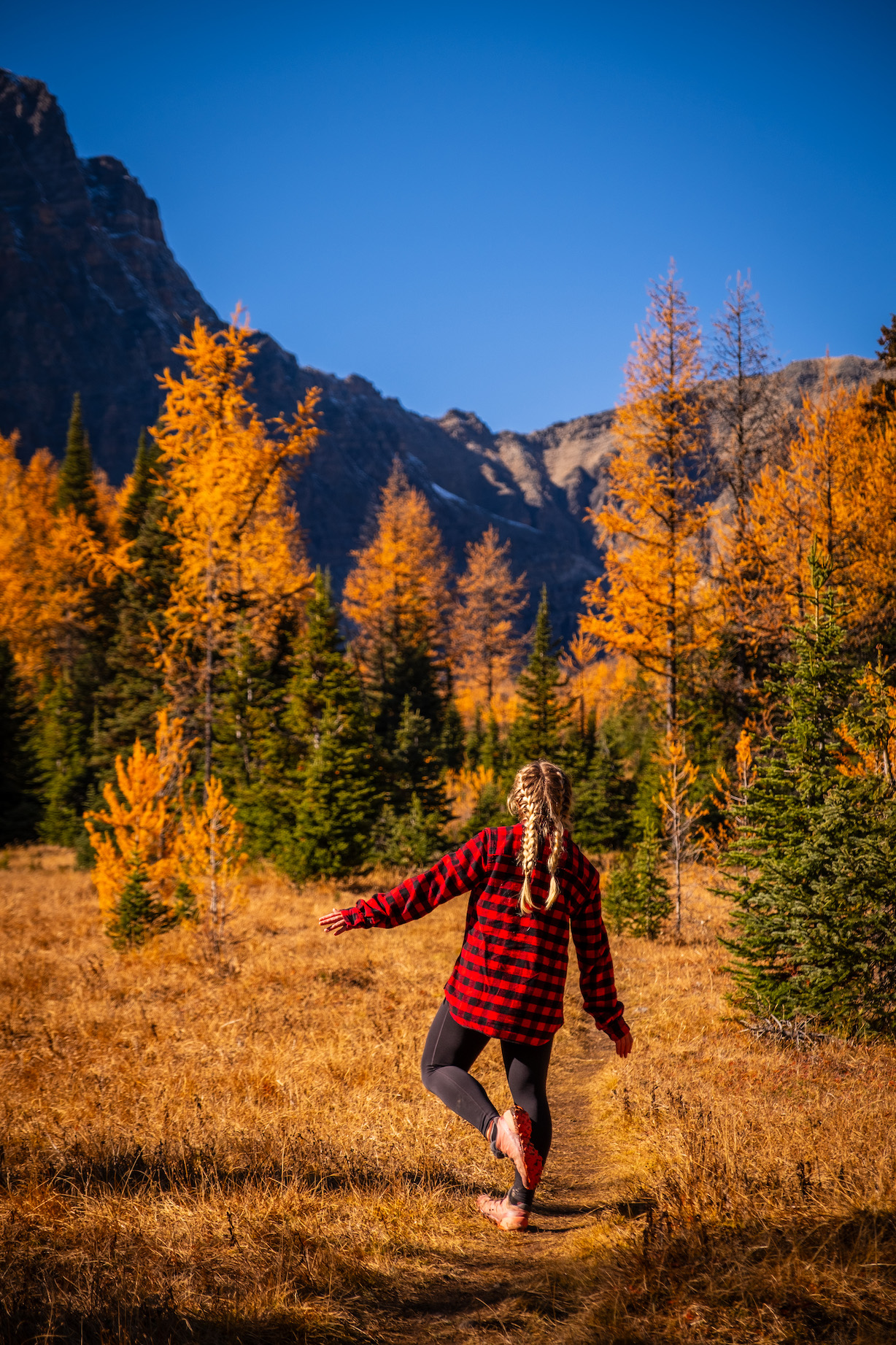
If you’re after larches, continuing on the trail after reaching Taylor Lake and enjoying the nearby Panorama Meadows is essential. This area has a well-defined hiking path and widely spaced trees, and mixed with the elevation, it provides some excellent views of the valley.
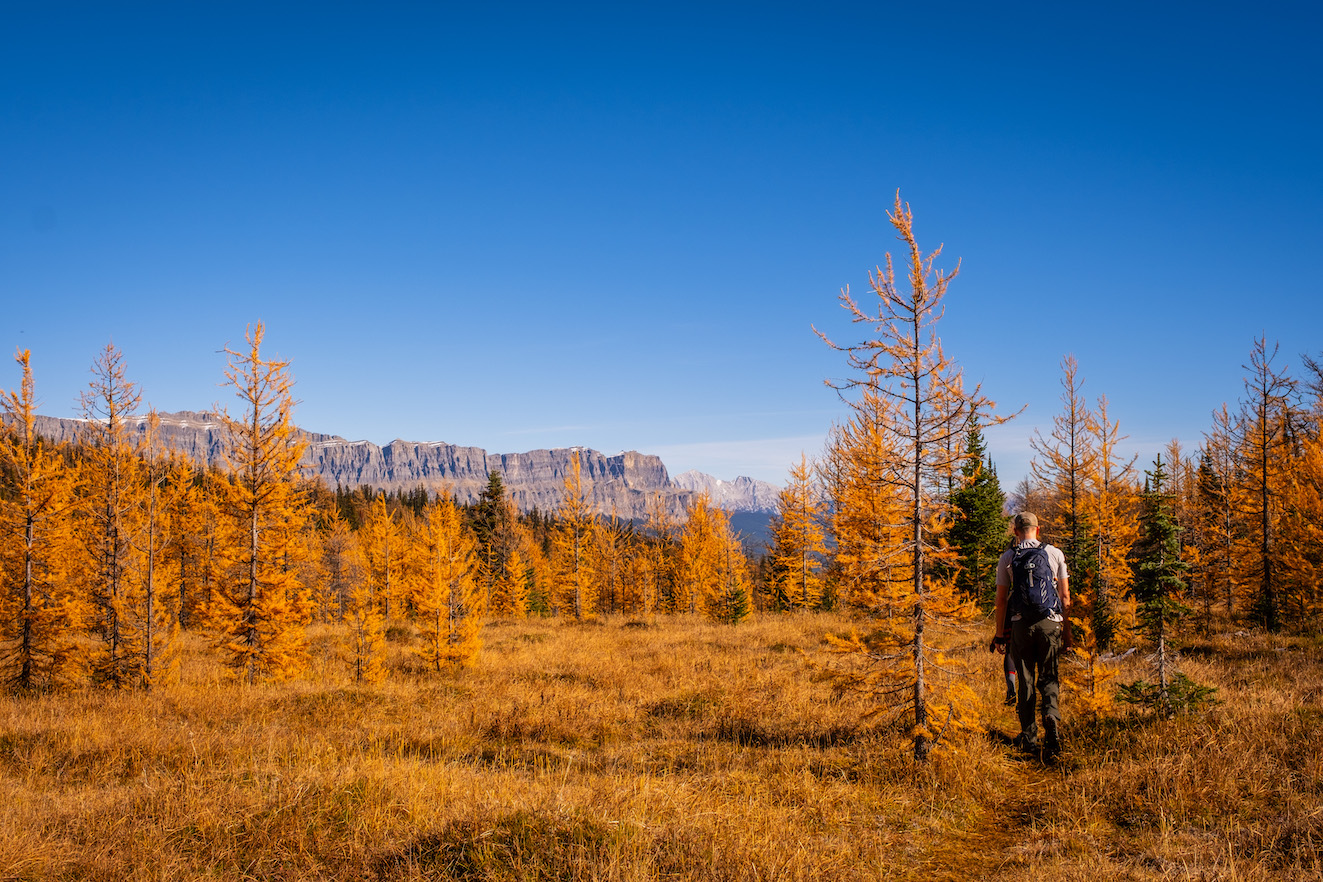
During the weekend in September, parking may be difficult as space is limited. Last year, cars were parked 1km each way on the Trans-Canada Highway, which didn’t seem exactly legal and would deter me from this trail.
However, the later on in the larch season, the quieter the trail gets. We enjoyed the hike to Taylor Lake on a Saturday in early October and only saw a few other groups on the trail! Since this is one of the more accessible Banff hikes here, it sees more people than other hikes mentioned. To avoid crowding, try to hike to Taylor Lake on a weekday.
Best Larch Hikes in Kananaskis
*Notice: Alberta Parks is asking hikers to avoid the Highwood Pass area of Kananaskis during the 2024 larch season. Ongoing construction there will result in very limited parking and intermittent closures. Roadside parking is not allowed. This includes the Highwoods Meadow Interpretive Trail, and the popular Pocaterra Cirque and Ridge Routes, Arethusa Cirque, and Ptarmigan Cirque.*
Pocaterra Ridge
Although not in Banff National Park, Pocaterra Ridge is easily one of the most popular and best larch hikes on this list and a great thing to do in Kananaskis in the autumn. Located near Highwood Pass in Kananaskis, Pocaterra Ridge is home to tons of larches. When the needles start to turn yellow, this is one of the first places you should head. Although if you can, try and avoid weekends – it’s a busy one with Calgarians!
Pocaterra Ridge is typically done as a point-to-point hike, so I would definitely recommend doing it this way if you can set up a car shuttle. Since we only had one car, we completed this as an out-and-back hike.
To do this, follow the trail network until you reach the open valley. Make sure to stay on the trail, though. Scores of people going off-trail have caused this trail to become extremely braided and confusing to navigate.
Once it opens up, you can continue along Pocaterra Cirque, which only takes you 430 m up and is easier than trying to summit the ridgeline. Alternatively, head for the ridge summit. Once you reach the summit of the ridge, about 600 meters up, you can either keep walking on the ridge with some easy scrambling or head back down!
Ptarmigan Cirque
Ptarmigan Cirque is a short and sweet larch hike in Kananaskis that the whole family can enjoy. Located just across Highway 40 from the Pocaterra Ridge Trailhead, you’ll have to get here early on weekends to find parking. This hike is only 4.2 km round trip and has an elevation gain of 271 meters—like I said, sweet and short. Cross Highway 40 from the car park, follow the well-trodden trail and walk until you get a stunning open vista of the larches.
Continue up to the valley, where the views will quickly open up. You’ll see the trail ahead of you. It’s a loop trail that goes by quickly, and I wouldn’t make the drive just for this hike. I think Arethusa Cirque (mentioned below) is comparable in difficulty but much more enjoyable. I would highly suggest combining Ptarmigan Cirque with Pocaterra Ridge or Arethusa Cirque for a full day, as chances are you have driven quite a way to get there.
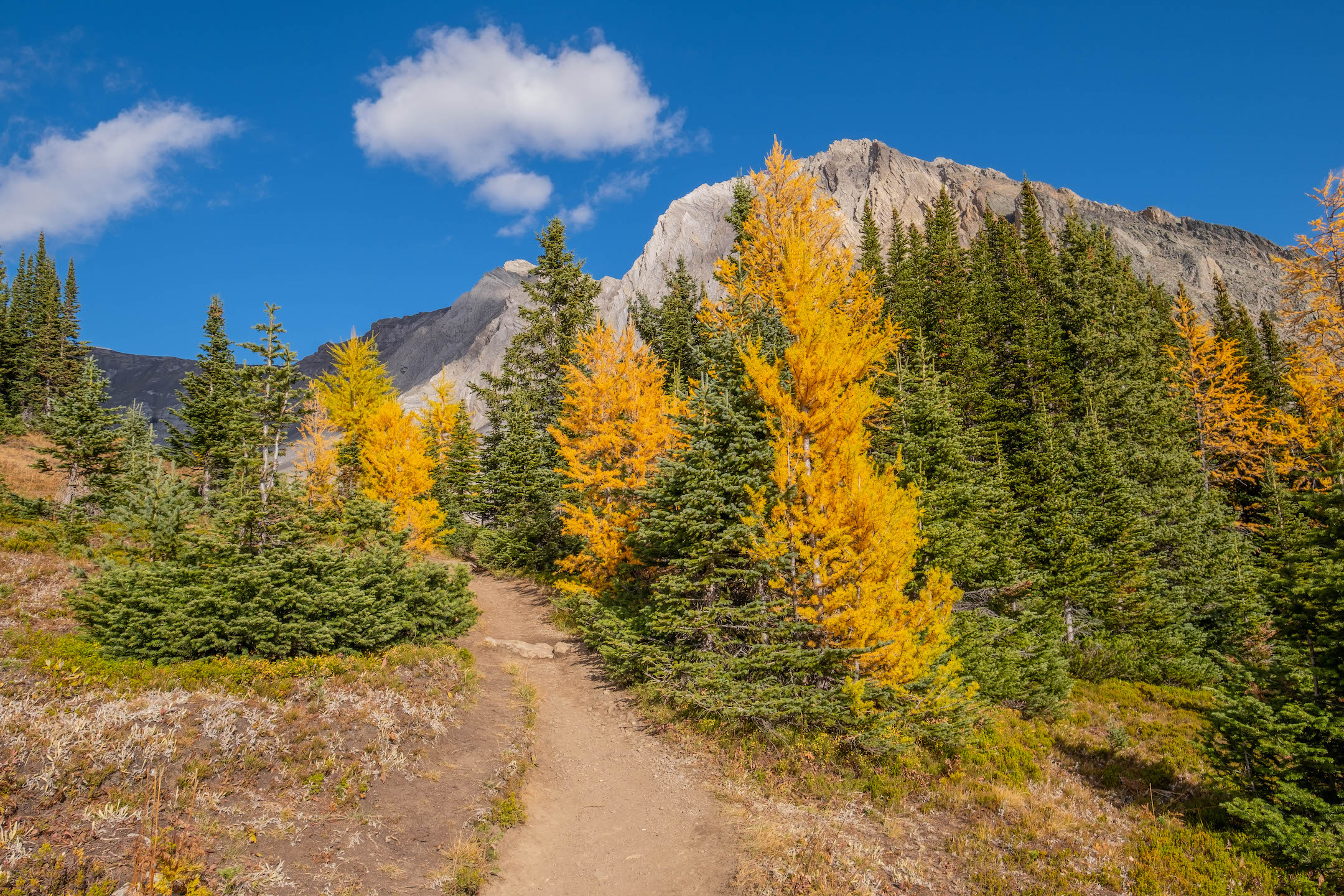
Nevertheless, Ptarmigan Cirque remains one of the busiest larch hikes in Alberta because of its ease and accessibility. During peak larch season, there have been parking and crowding issues here. If you arrive and find cars lined up down HWY 40, consider another hike nearby, as it’s best not to add to the congestion. Or, to mitigate this issue, get here early or in the evening, especially on weekends.
Arethusa Cirque
As a well-known, family-friendly hike in Kananaskis that’s not too far from Calgary, I wasn’t expecting much from Arethusa Cirque. We decided to do it with a 4-week old newborn since it looked simple for a new momma and the babes.
Boy, was I wrong about my perceptions of this hike. The views of Mount Arethusa, Mount Tyrwhitt, and Storm Mountain will amaze you. The views from the trail completely blew me away and were on par, if not better than Pocaterra Ridge.
If you are looking for an easy half-day larch hike, put Arethusa Cirque on your list. This is a loop trail that I suggest taking clockwise. There is one very steep and loose section that is better to ascend than descend, especially with children or older hikers with less mobility.
Chester Lake
Chester Lake in Kananaskis Country Provincial Park is a great hike for those who base themselves in Canmore over Banff. It’s well known for being a fantastic snowshoe and very popular in the winter, but it also has some larches around during the last few weeks of September. Ultimately, this is another short and sweet hike on this list that is great for beginner hikers or families with children or grandparents in town.
Most of the trail is pretty boring, but eventually, it will open up as it takes you to Chester Lake, where you get great views of Mount Chester and Fortress Mountain. It’s certainly not the most thrilling hike on this list, and there aren’t as many larches here as on the other hikes, but it’s still a nice short-day hike out in the Rockies!
Smutwood Peak
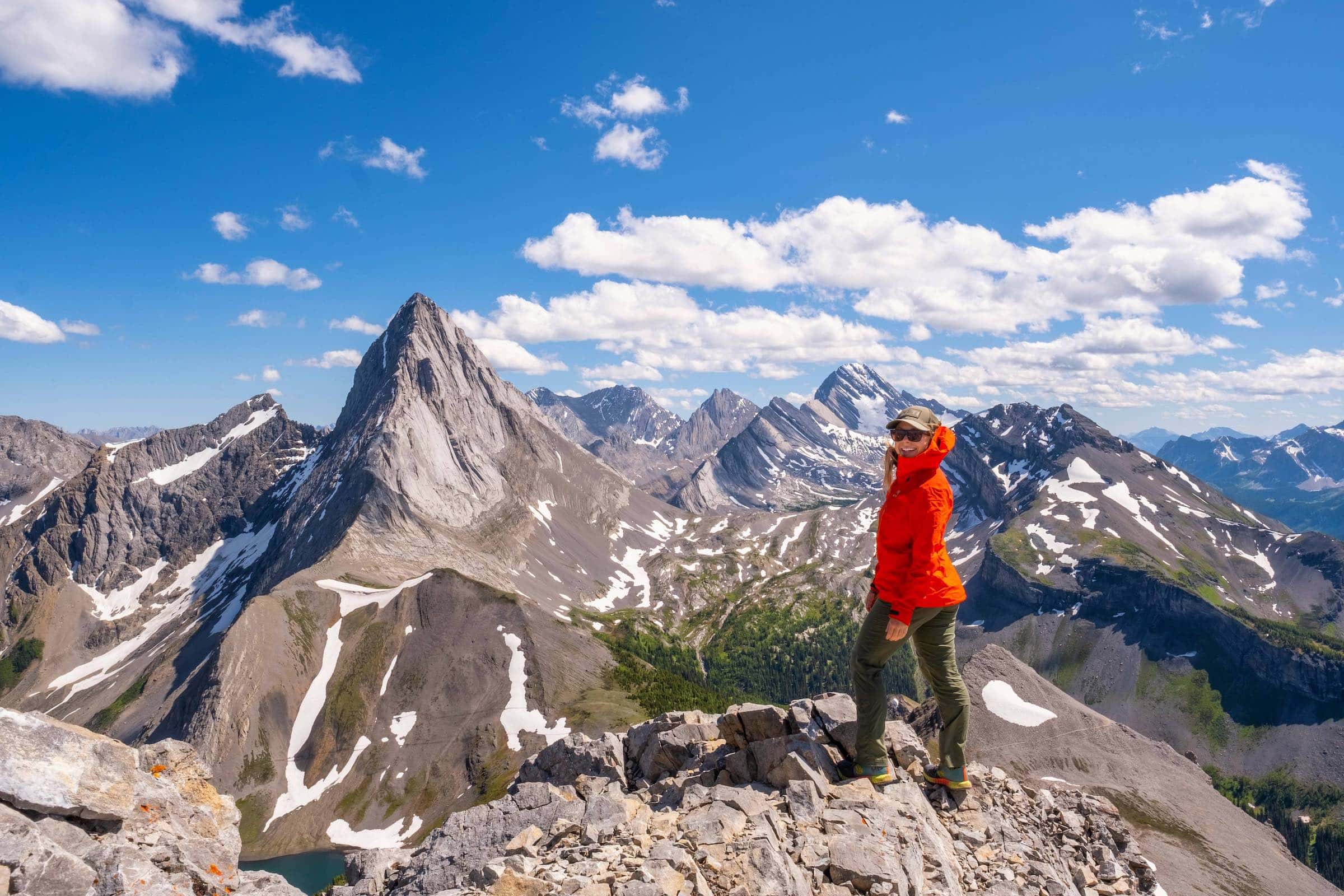
Smutwood Peak is one of our favorite Kananaskis hikes and possibly one of Alberta’s best hikes. The views almost the entire way are absolutely stunning, and from the top of Smutwood Peak you’ll get some amazing larch tree views.
The first hour or so of this Kananaskis hike is straightforward, with no elevation gain. You’ll pass an incredible waterfall, and once you get into the alpine meadow, the views are amazing. You could even make a detour to Tryst Lake, one of the easier larch hikes in Kananaskis, if you have the time and energy.
Your first taste of steepness is going into Smuts Pass, where it’s relentless uphill for 2 km or so but then lightens up again as you first lay your eyes on Mount Birdwood. The route from the saddle up to the top of Smutwood Peak looks long and steep, but it’s easier and shorter than it seems.
Tent Ridge
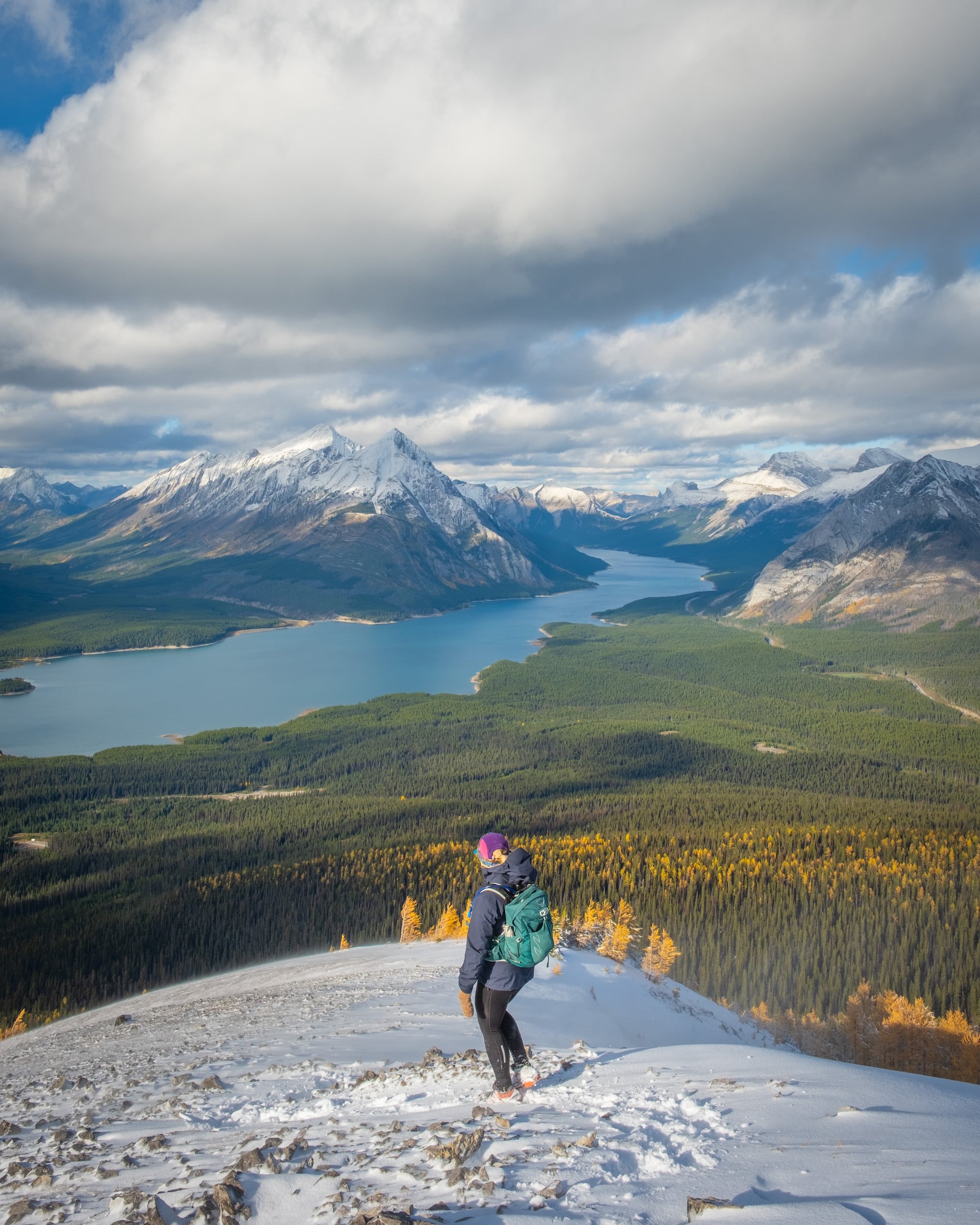
Tent Horseshoe Ridge is another one of my favorite hikes in Alberta. This beautiful loop trail is just an hour’s drive from Canmore in the Spray Valley. If you’re looking for a half-day moderate larch hike, Tent Ridge is a must-do. Tent Ridge Horseshoe is a 10-kilometer loop trail, and although AllTrails rates this as hard, I would put it more at a moderate.
A few steep pitches will have you panting, but I believe the real reason it’s rated as hard is because of the small scramble up (or down, depending on which way you go) from the ridge. We recommend doing a clockwise loop so you are scrambling up, which is significantly easier than scrambling down. Once you get to the viewpoint over Spray Lakes, you’ll see plenty of golden larch trees below you.
Burstall Pass
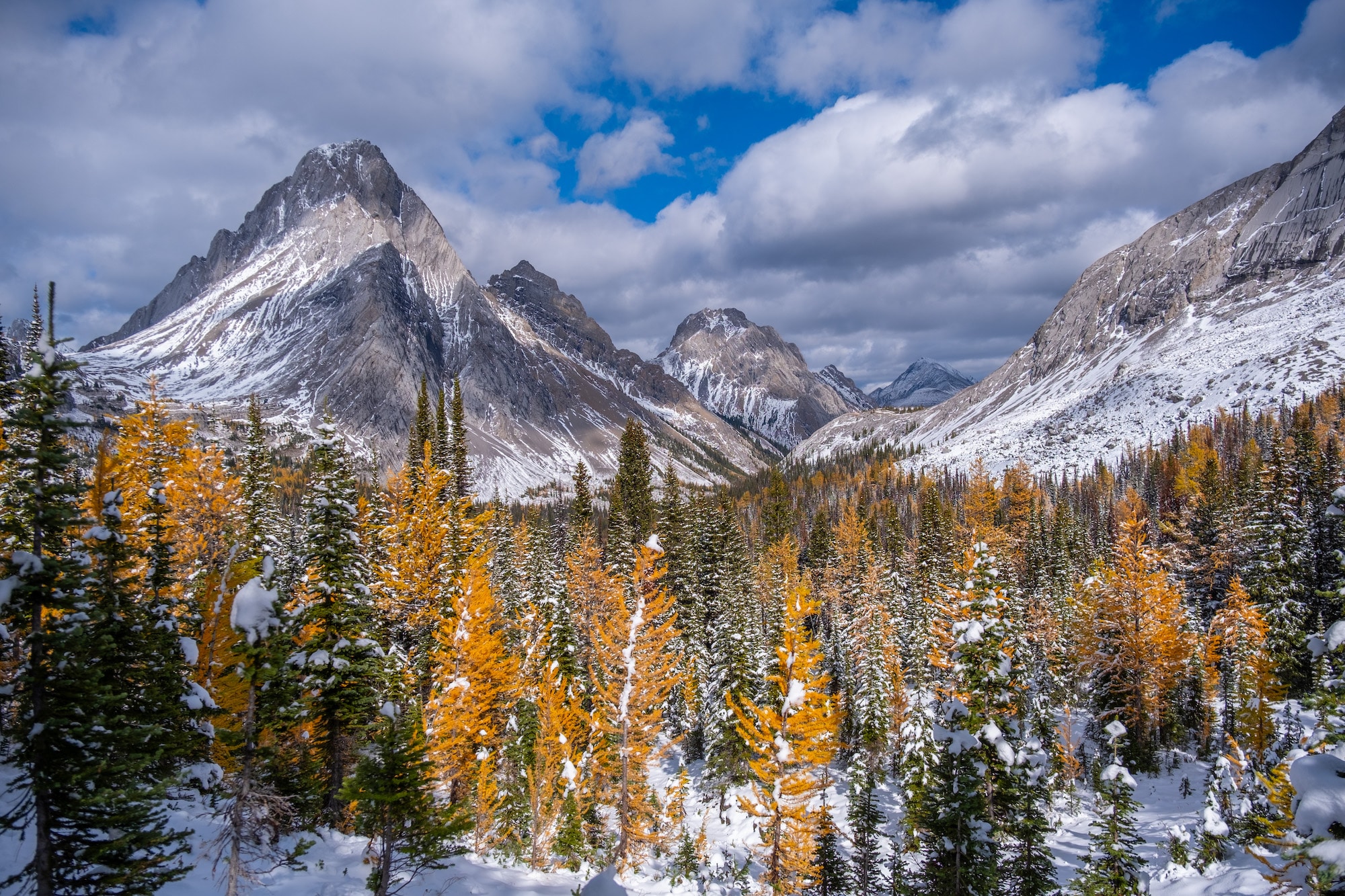
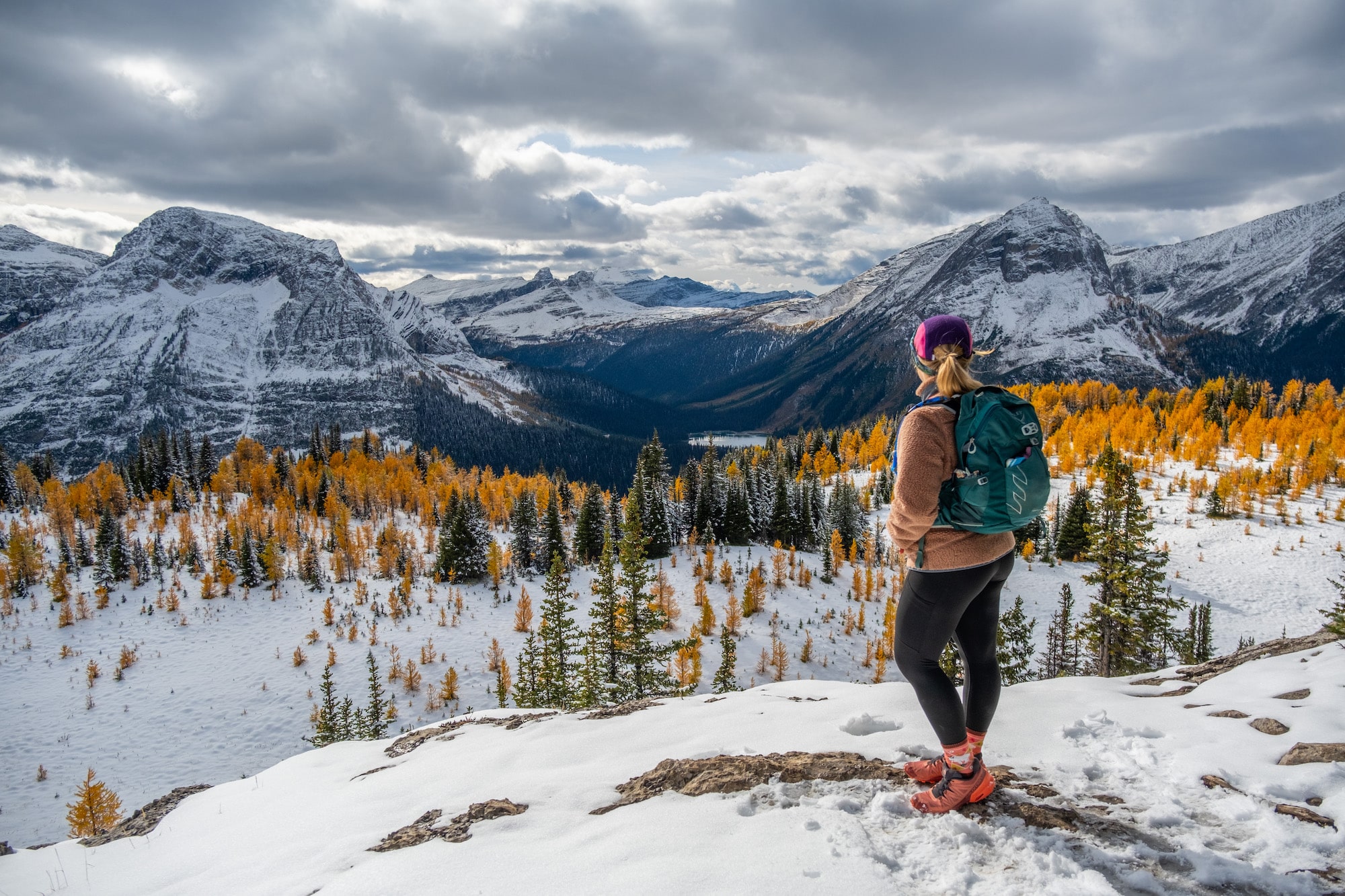
Burstall Pass is a classic hike in Kananaskis near the trail for Chester Lake mentioned above. Park near Mud Lake to begin this epic day out. The hike starts off rather boring on a relatively flat road. At about 5km, you’ll reach an open valley with expansive views of the Robertson Glacier and Commonwealth Peak. Make your way to the trees and work your way up the steep ascent, leading into another open valley. This is where the larch trees really start to show off.
Continue working your way up the high mountain pass until you hit the top, which will be noted by a sign allowing you to cross into Banff National Park. On a clear day, you can even see Mount Assiniboine. You can stop and turn back whenever you please, but we recommend continuing to the view over Leman Lake for superb larch viewing.
Though Burstall Pass is a long hike, 16 to 18 km, depending on how far you go, it’s a long yet easy larch hike. Elevation is gradually gained throughout most of the hike except for a few sections. If you want to shave some time off, you can bike the first 4km of the road, which can cut off more than an hour of hiking between the in and out!
Mount Assiniboine Provincial Park
While Mount Assiniboine is not in Banff or, technically in Alberta for that matter, it deserves a special mention on this list as it is just incredible for larch viewing. If you can get back here during the fall in the Rockies, consider yourself extremely lucky!
First, to hike back around Mount Assiniboine, you will need campsite reservations or a reservation at Assiniboine Lodge. Both should be booked well in advance. Spaces are limited and book up fast due to the beauty of this area, especially in the fall.
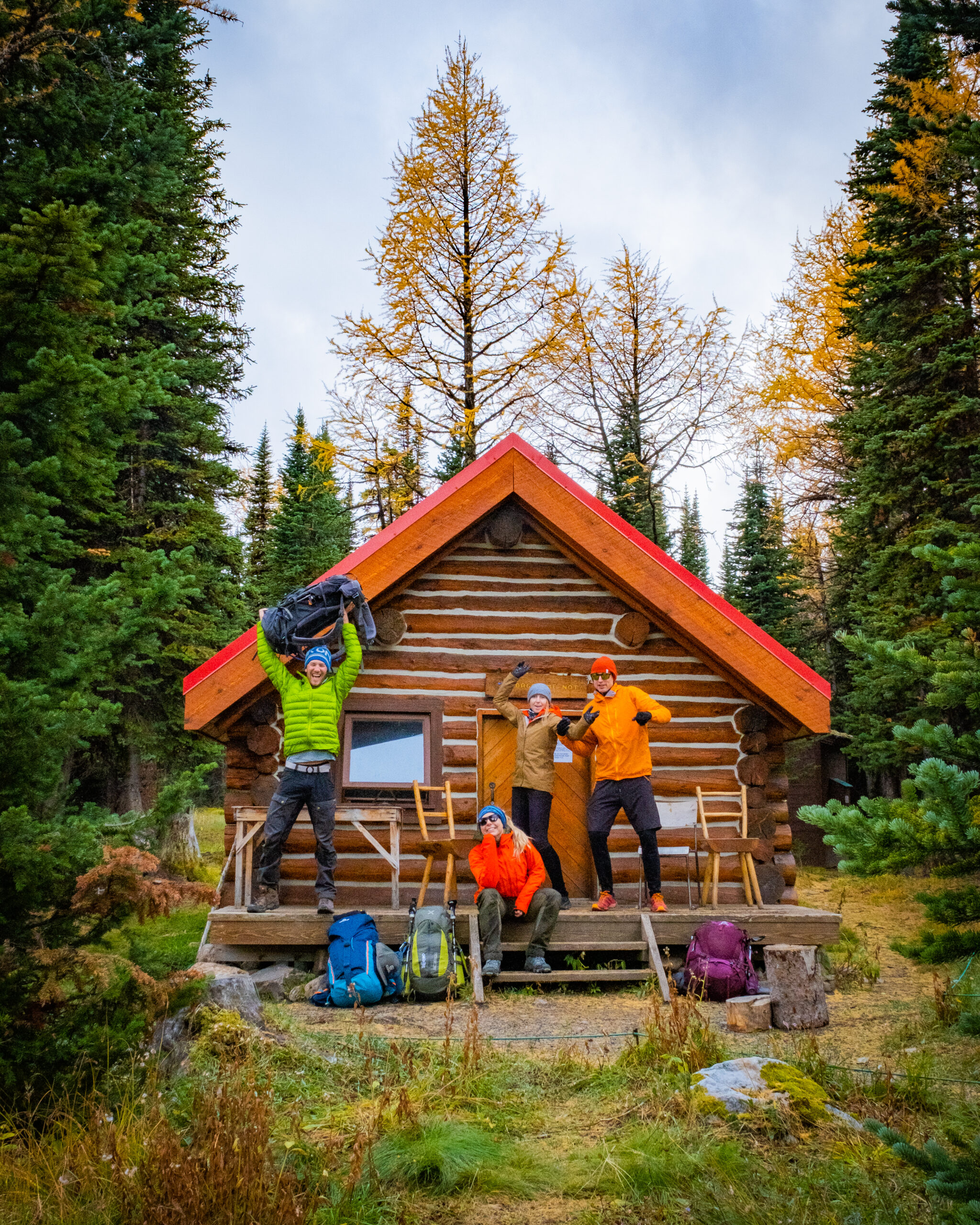
Mount Assiniboine is far back there and not a day hike unless you are a capable trail runner. To get back to Lake Magog (the lake that sits under Assiniboine and where the campsite is), you’ll need to be able to hike over 25 km from the Mount Shark parking lot, which will take quite a bit of time with a heavy backpack on your back. This can be split up into multiple days if you want to stay overnight at the Marvel Lake campground.
Or the other option is to hop on a helicopter operated by Assiniboine Lodge to take you into the park. Once in, you can hike around The Niblet, Nublet, and Nub Peak. You can choose to either hike out with a lighter pack or heli out!
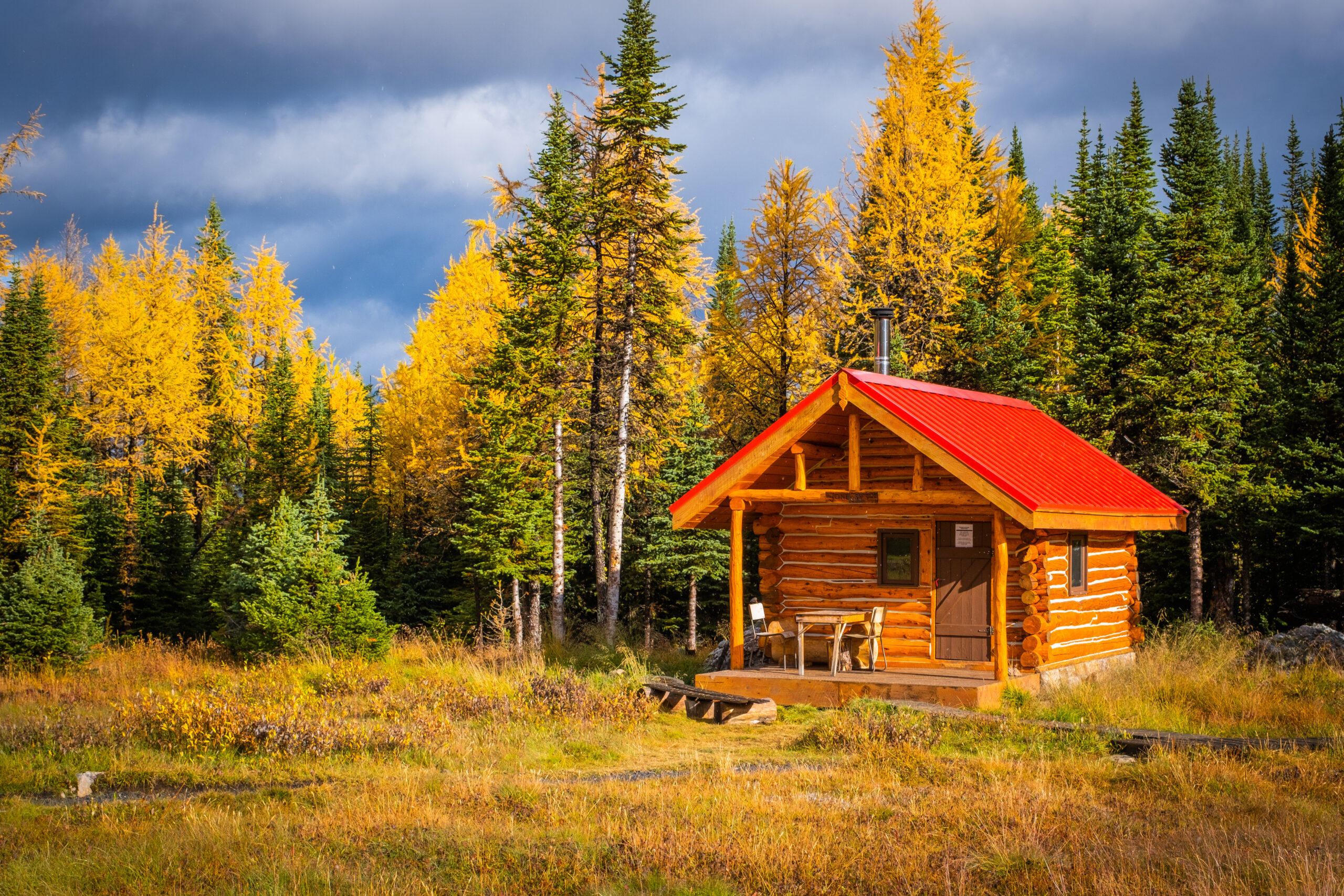
We did this hike during larch season and started at the Mount Shark Trailhead, and hiked to the Naiset Huts in one day. It took us about 6 hours to reach the huts, about 25 km in, at a fast pace. The hike is pretty boring until you get to Marvel Lake and skirt the lake, then the fun begins. The next exciting part is Wonder Pass, which is essentially an endless meadow of larches.
You can either hike out the same way, or if you have a car stationed at Sunshine Village, you can hike out. The Assiniboine Pass is a point-to-point hike, though it’s less scenic than Wonder Pass. The good news about Mount Assiniboine is that it is relevantly inaccessible and sees almost no crowds.
Yoho National Park
Lake O Hara
Although Lake O’ Hara in Yoho National Park is technically in British Columbia, it’s close enough that it also deserves to be included in the best Alberta larch hikes post, as it’s just over the Alberta/BC border.
This whole area is teeming with endless larches. Though for the best views of larches you’ll have to do a little hiking. Head up to the Opabin Plateau for a view of O Hara and Mary Lake. You can also hike the famous All Souls Prospect Route and detour to Lake Oesa. Or opt to go to Schaffer Lake and McArthur Lake. There’s a lot of hiking options here!
If you can score camping reservations or bus tickets back here in the larch season, scoop them up immediately. Otherwise, to see the larches surrounding the entire area will require you to hike in on a very boring 11 km access road and possibly out if you can’t get on a bus back.
We’ve hiked to Lake O Hara twice now, and I can confirm that the 11km road sucks, but you’ll forget all about it once you are at Lake O Hara.
Like the Skoki and Lake Louise areas, there are many hiking route options here, so you’ll have to research and choose which ones are right for you. My best advice would be to camp at Lake O Hara for three nights and choose a different trail to hike every day – that’s if you can get the reservations of course!
Kootenay National Park
Floe Lake
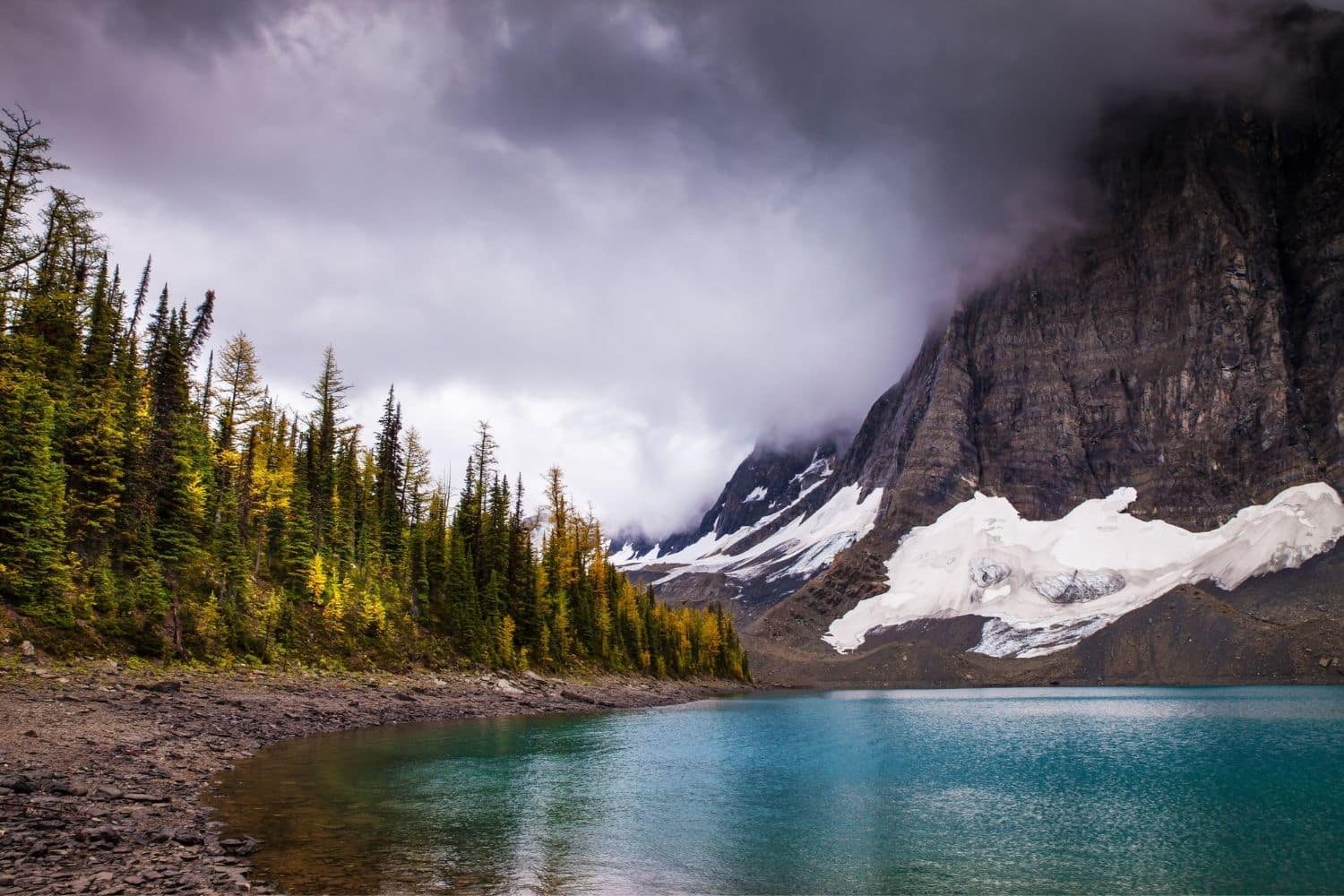
Surprise! Another amazing larch hike that isn’t actually in Alberta, but plenty of Albertans will drive the extra distance to cross this one off their fall bucket list.
Floe Lake is a fantastic backcountry destination and is a well-known Instagram spot thanks to the beauty of Floe Lake under the impressively shaped Floe Peak. Plenty of larch trees surround the lake, making it a great fall hike. If you get a clear morning here, you’re in for a treat as the sun lights up the whole lake quite peacefully.
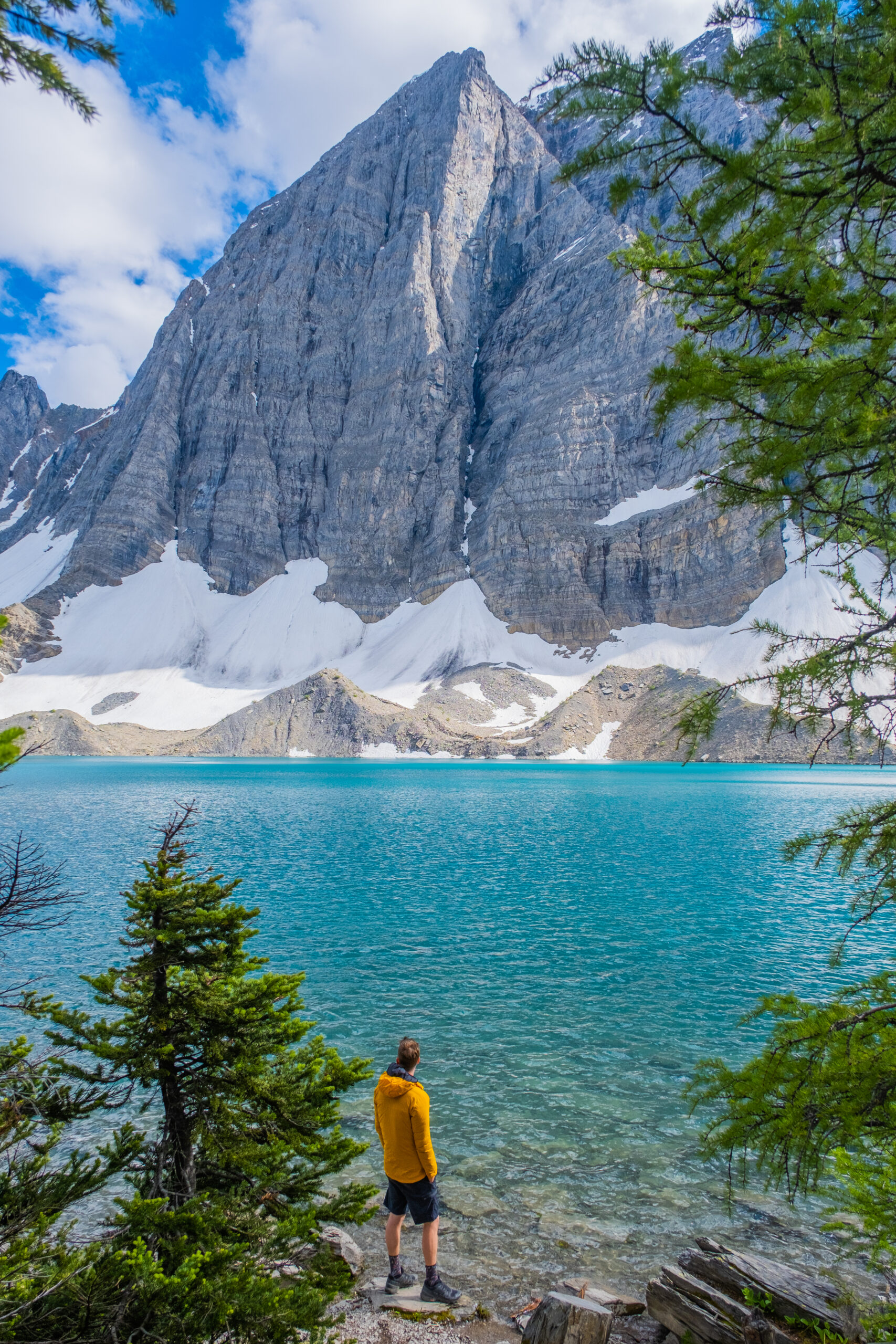
You’ll have to hike 10km to reach the lake, with just about 1000 meters of elevation gain, which you can do as a day hike. Though to get the most out of the area we recommend camping. Here is one of the prettiest campsites in the area, so don’t hesitate if you can book a spot here. Once at Floe Lake, you can turn back, making for a 20km hike, or continue along the Rockwall Trail for an incredible backcountry experience.
Alberta Larch Hikes That Will Give You a Taste of Golden Goodness
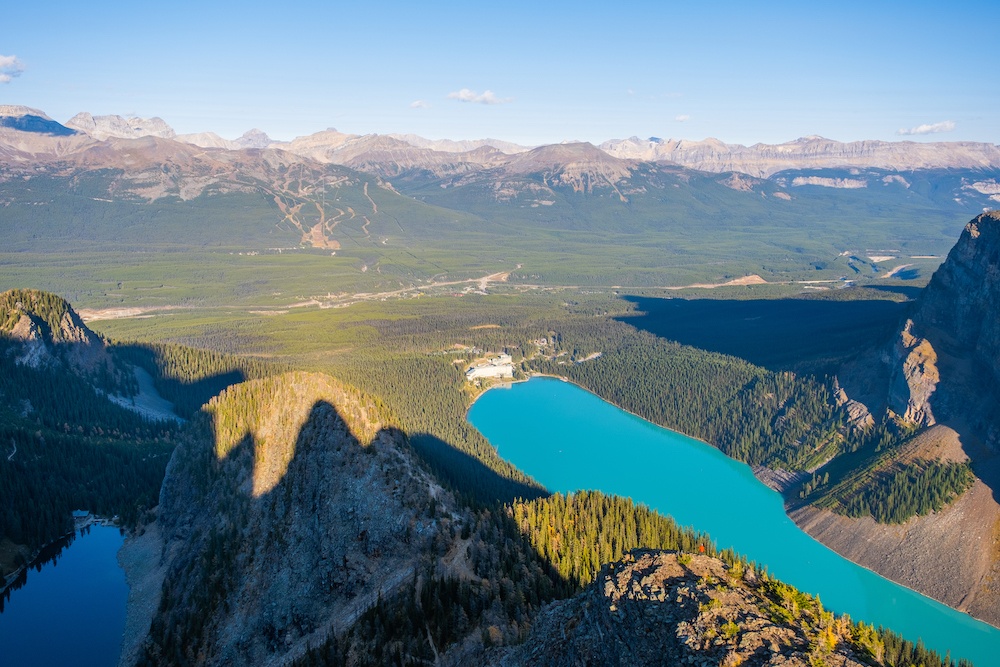
The following aren’t what I would typically describe as a solid larch hike in the Rockies, however there are larches scattered about the area and embarking on any of these hikes will give you a little taste of yellow larches.
- Beehive Circuit: There are plenty of larches scattered about Lake Louise, and you can see them below Fairview Mountain from the Little Beehive or Big Beehive trail.
- Devil’s Thumb: From the top of the Devil’s Thumb scramble you will be able to see a few golden larches around Lake Louise.
- Plain of Six Glaciers: You see plenty of fall color and a few larch trees if you complete the Plain of Six Glaciers trail.
Hike Gear We Recommend
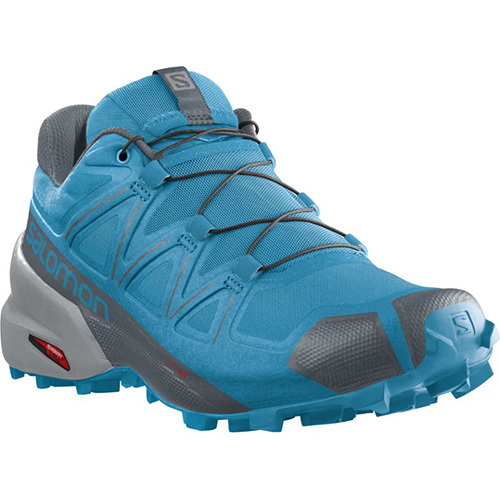
The vast majority of hikes and easy scrambles in the Rockies, you’ll find us in our trusty Salomon Speedcross.
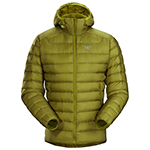
Arc’teryx Cerium is our pick for the best down jacket. It’s incredibly light, and we bring it on almost every hike in the Rockies.

This nifty clip from Peak Design secures a camera to my backpack strap for easy reach. No more digging in the backpack!
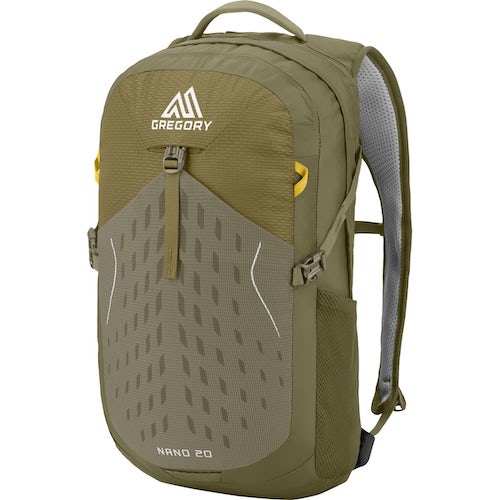
20L feels like the ideal size for quick hikes and scrambles. We love the Nano from Gregory with a hydration reservoir.

There is not much cell service in the Canadian Rockies. In case of emergencies, we carry an emergency beacon with GPS.
Our Tips for Seeing the Golden Larches in Alberta
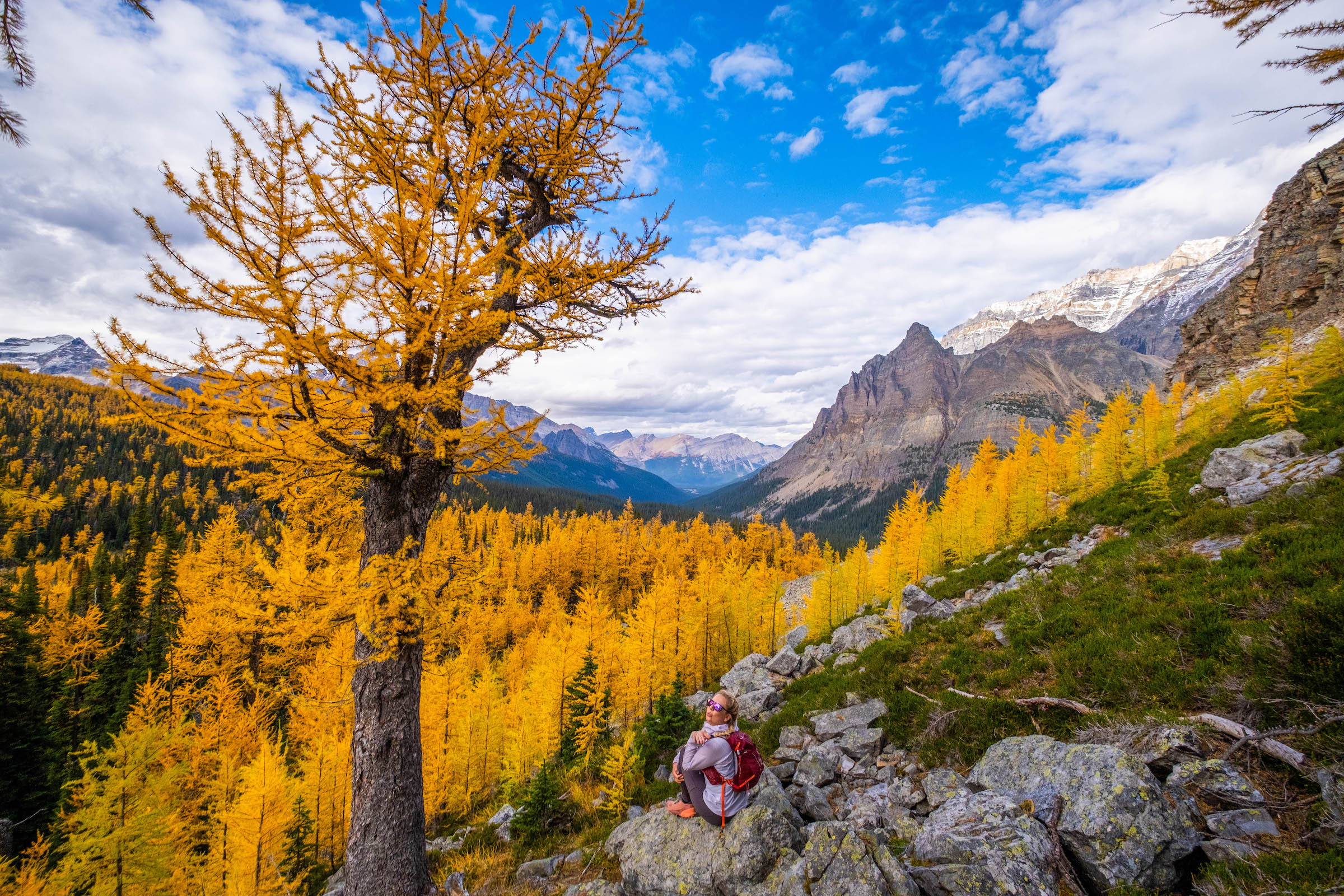
- Weekdays are best. Just because it’s fall in Alberta doesn’t mean the crowds have subsided. People flock from around Canada and the rest of the world to see the golden larches in the Rockies. To avoid the crowds hike on weekdays if possible.
- Early starts on weekends. Obviously, weekdays are not possible for everyone. So if you’re heading to the mountains to see the larches on a weekday it’s best to either start before the sun rises, or go for an afternoon start. Keep in mind the sun sets around 7:30-8pm during this time period so plan your day accordingly. We aren’t morning people, and often start our hikes in the afternoons or evenings when others are on the trail or finishing up. However, we are pretty fast hikers so we can time our late starts and know our timing with the sunset.
- Utilize the shuttle system. The Lake Louise and Moraine Lake area get extremely busy during this season. It’s best to utilize the Parks Canada shuttle system or book a service like the Moraine Lake Bus Company for an early start.
- Layers, layers, layers. It’s fall in one of the coldest areas in Canada. The day can start off warm, and end with freezing hands. Pack layers. I always have a down jacket, windbreaker, gloves, and a hat or buff in my bag so that I can adjust my body to the temperature.
- Get a map: I just threw a lot of hiking options at you, and it’s easy to feel overwhelmed. Many of these hikes have so many offshoots you can explore, and if you’re not from here or know the area, you probably feel like you’ve just read a bunch of words with no meaning. It’s critical to get a topo map of the Rockies so you can visualize everything I am talking about on paper and properly plan your route! You can pick these up at outdoor stores in town or order online before. We like to use Gemtreks.
Do You Have to Hike to See the Golden Larches?
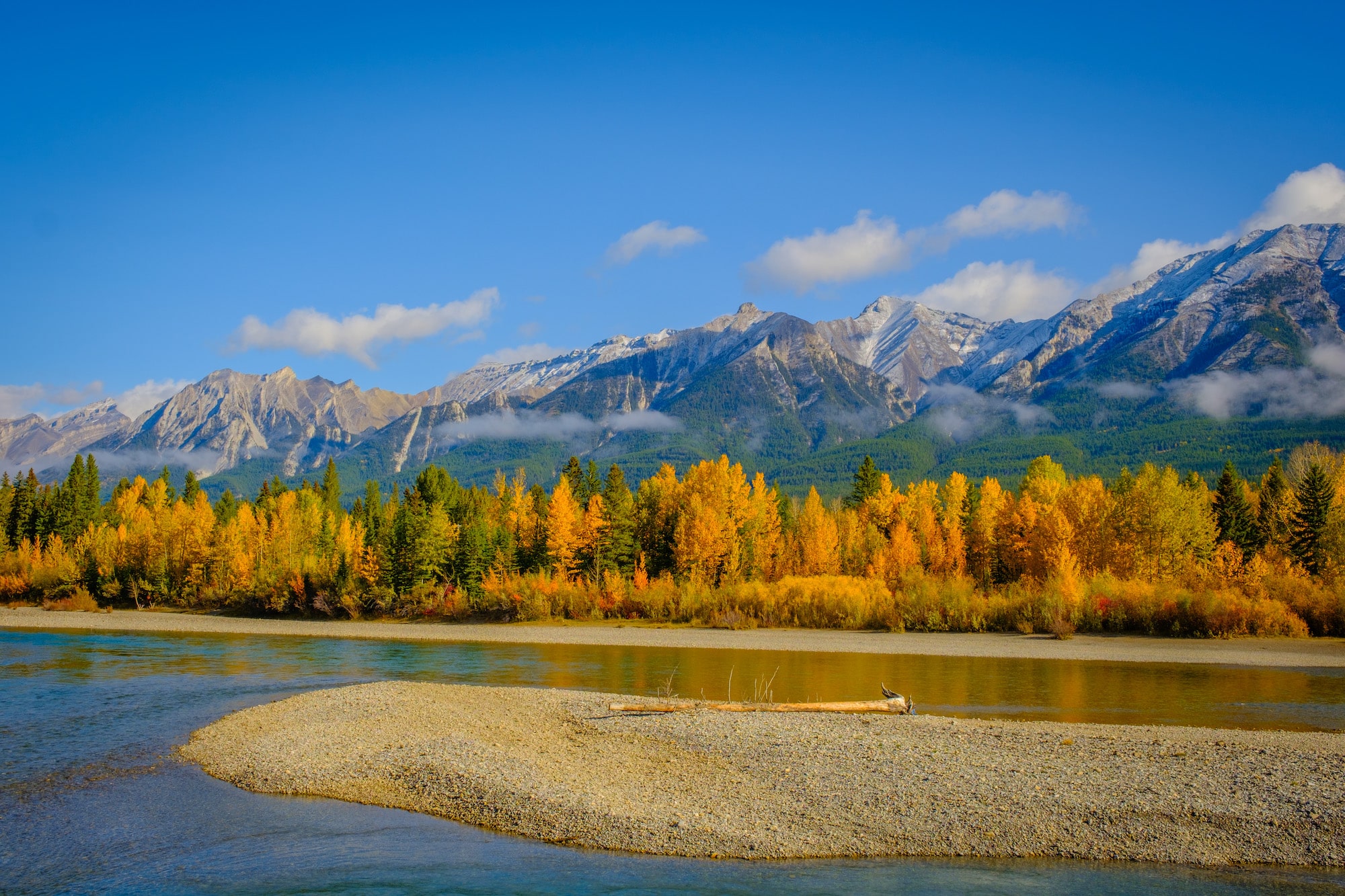
You don’t have to hike for hours to get a glimpse of larchy goodness. There are alternative ways to see the beauty of the Canadian Rockies in the fall.
By Car
Just taking a drive down Highway 40 will let you view plenty of fall colors from the window. We often see many yellow trees from Barrier Lake and up over Highwood Pass.
You can also see plenty of larch trees from the car driving down the Trans Canada. We keep our eyes especially peeled when driving past Mount Temple and the Lake Louise exit.
By Horse
Timberline Tours Ltd. and Brewster Adventures offer various day trips to areas around Lake Louise. The Lake Agnes Trail and Little Beehive offer great views in a half day. There are also tours that go back to Skoki Lodge.
Heli Tour
Rockies Heli Tours Canada, Alpine Helicopters, and CMH all offer helicopter tours which will give an incredibly unique perspective of the fall colors.
Gondola Tour
Take the Lake Louise Gondola, which runs until early October, and walk onto the Lake Louise viewing platform to get a great view of the larches. From here, you’ll also get views across the valley of Little Temple, Mount Fairview, and the larches along Saddleback Pass. There are also a few hiking trails from the gondola, like the Pika to Ptarmigan Viewpoint Trail.
Which Larch Hike is Our Favorite?
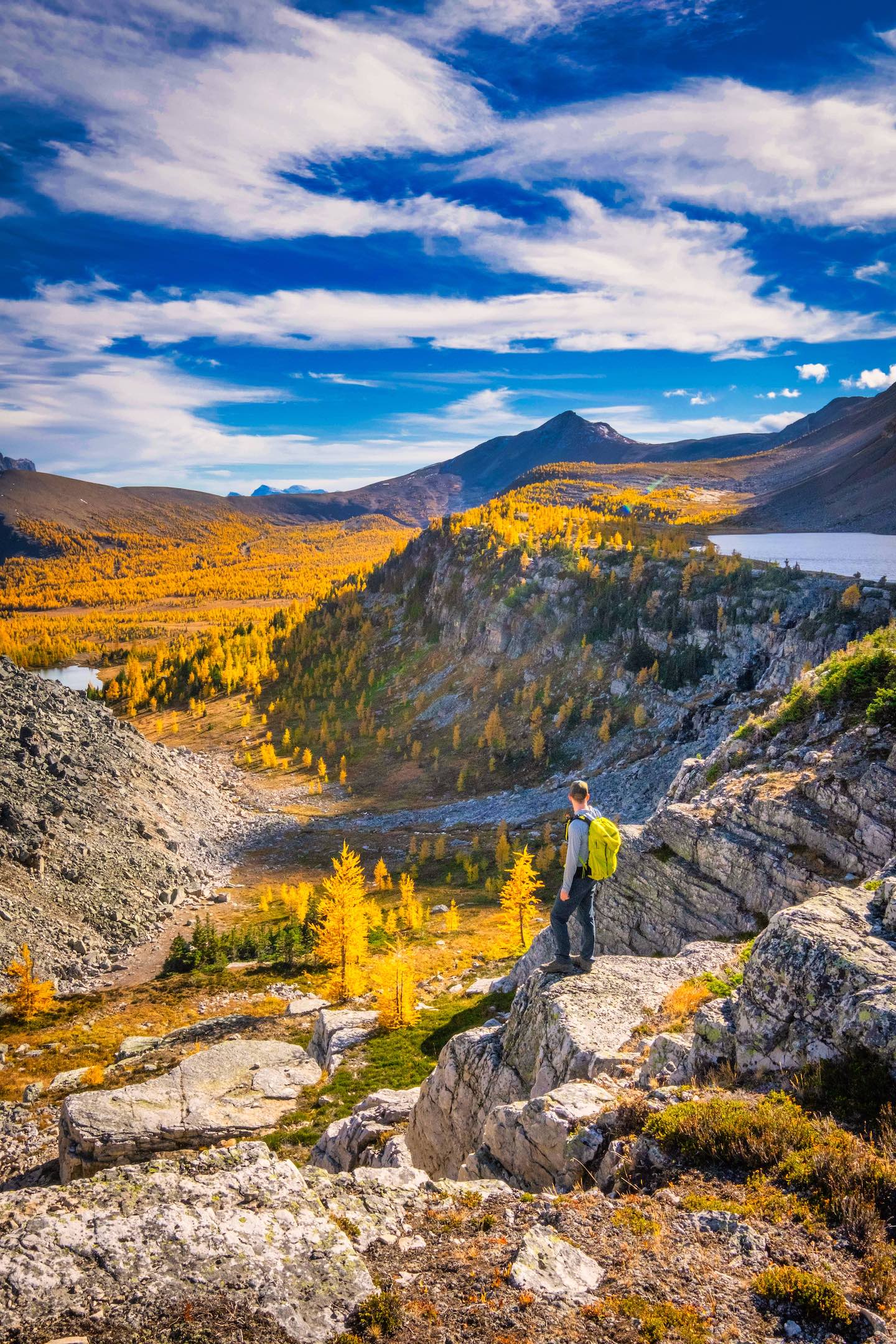
I don’t have one set favorite larch hike. But instead, I have favorite areas that consistently deliver on larch goodness. Skoki, Mount Assiniboine, Sunshine Valley, and Lake O Hara are those areas. If I had endless amounts of time I would get back to each of these spots every fall.
Other popular areas are around Highwood Pass in Kananaskis and, of course, Moraine Lake and Lake Louise. However, the busyness detracts me a bit, and I prefer the areas requiring longer approaches as it keeps the crowds down.
Stay Near the Larches!
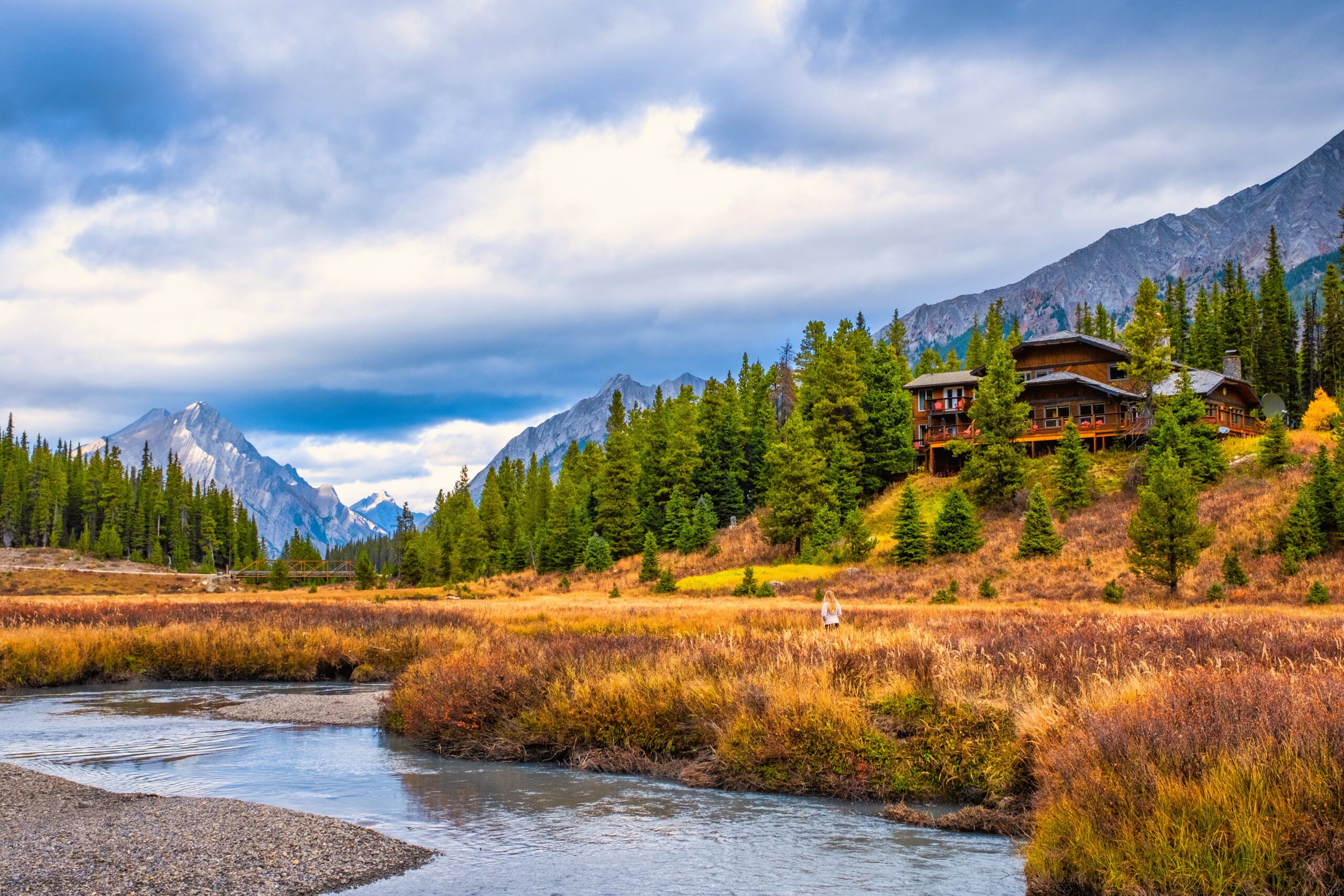
If you want to get out on a sunrise hike during larch season, it’s best to stay near the action. Driving to Banff from Calgary is no fun at 5am.
The best area to stay near the action in Banff is at Lake Louise. Our favorite hotels here are Baker Creek, the Fairmont Chateau Lake Louise, and Paradise Lodge and Bungalows. If you want to stay right next to the Sentinel Pass trailhead, you’ll have to stay at Moraine Lake Lodge, though it’s important to keep in mind that they close at the end of September.
The other option is to stay in Kananaskis Country! Our favorite place to stay in Kananaskis is Mount Engadine, though this cabin is closer to hikes like Tent Ridge, Chester Lake, and Read’s Tower than Hwy 40. Still a memorable place to stay in the fall! If you want to stay closer to hikes like Pocaterra Ridge and Arethusa Cirque book a night at Kananaskis Mountain Lodge.

New in 2025! We just released our local guide to the Canadian Rockies! Discover 300+ hidden gems, hikes, and cabins not found in your typical guidebook. We’re offering a 10% off intro offer using code BLOG10 at checkout!
Plan Your Trip to the Canadian Rockies
- We now have an interactive map! With over 350 stops and pre built itineraries around the Canadian Rockies, our personal map and guide is your one stop shop to an epic trip here.
- Recommended Experiences: There are many things to do in the Rockies, but our top recommendation is the Banff Gondola – a must do experience! Want to get up close and personal with a glacier? We cannot recommend this Icewalks tour enough!
- Planning your visit to Moraine Lake and don’t want to deal with the Parks shuttles? We recommend using Moraine Lake Bus Company, Fairview Limo (leaves from Lake Louise Village) or booking with ViaVia (these leave from Banff/Canmore).
- Hotels in the Rockies: There are many places to stay, from luxury hotels to wilderness cabins. See all our favorites here.
- Get Around: We suggest renting a car to get around. You can search for rental cars on Discover Car. For a campervan trip, you can check prices and compare on Outdoorsy.
- We can help you plan your 2025 trip to Western Canada! If you’re feeling overwhelmed by planning we can assist! We’ll hop on a 1 on 1 phone call, and PERSONALLY go over your itinerary, and will save you previous time and money with our personal recommendations. Calls are followed up with detailed trip notes afterward that I write myself. See our services here.

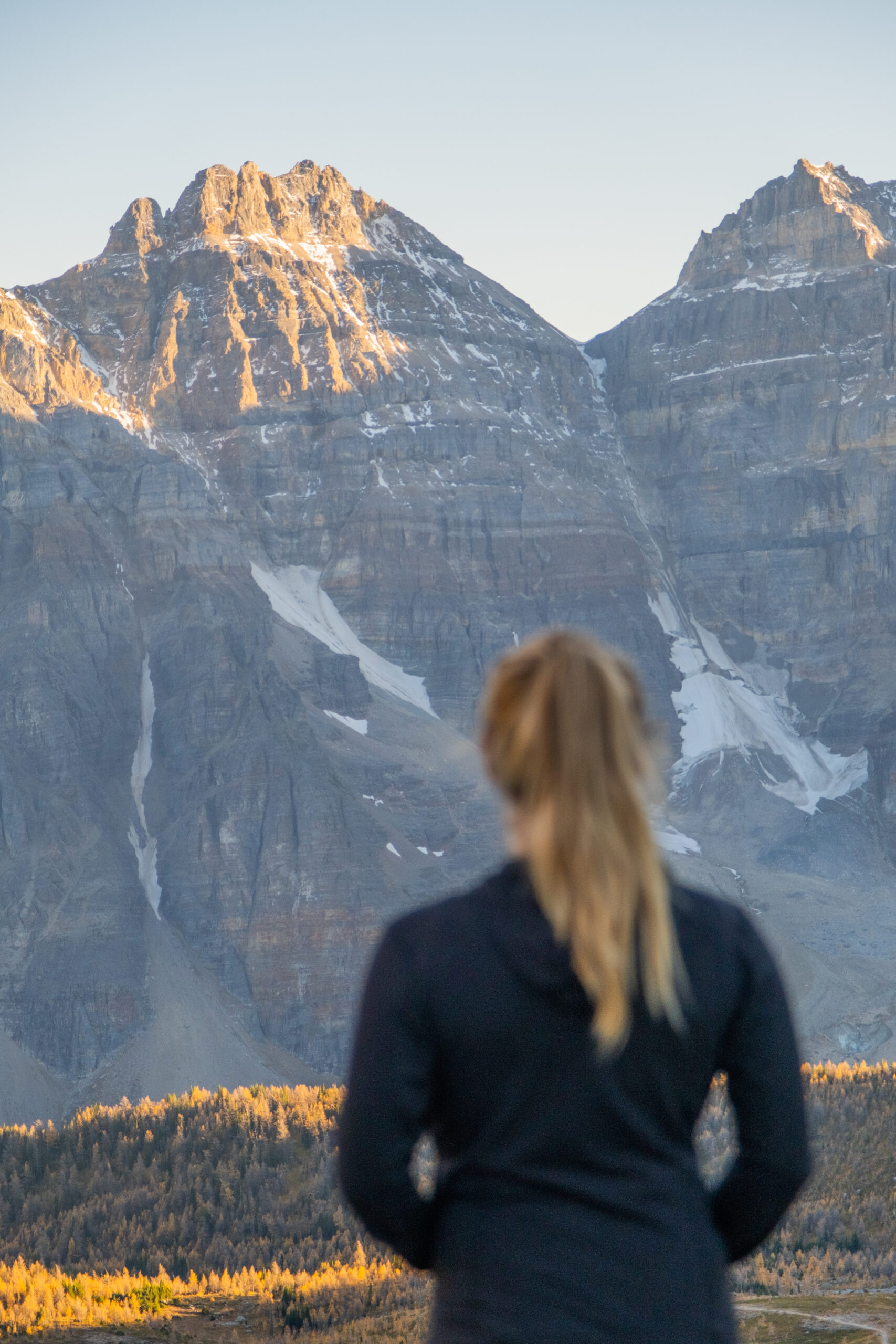
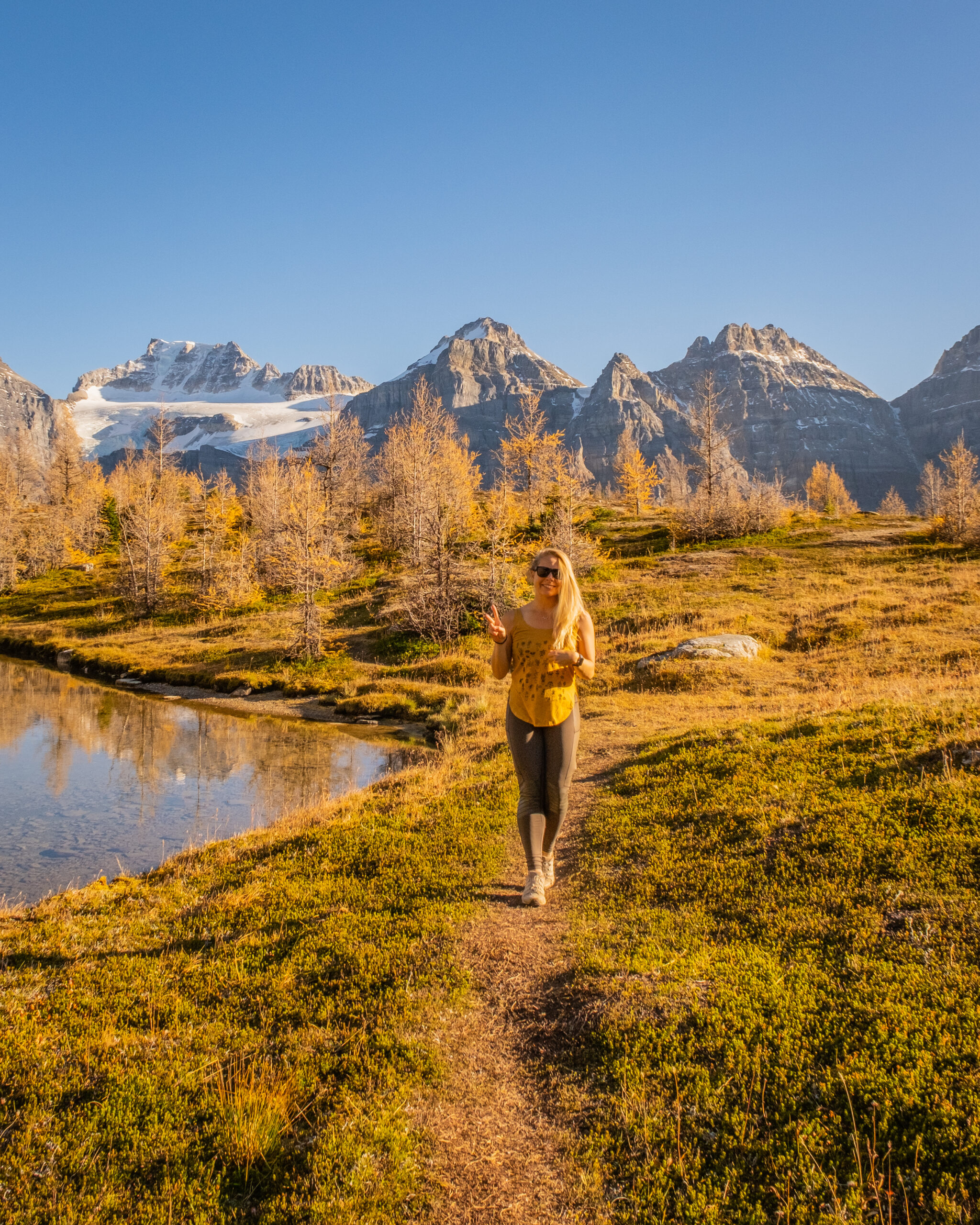
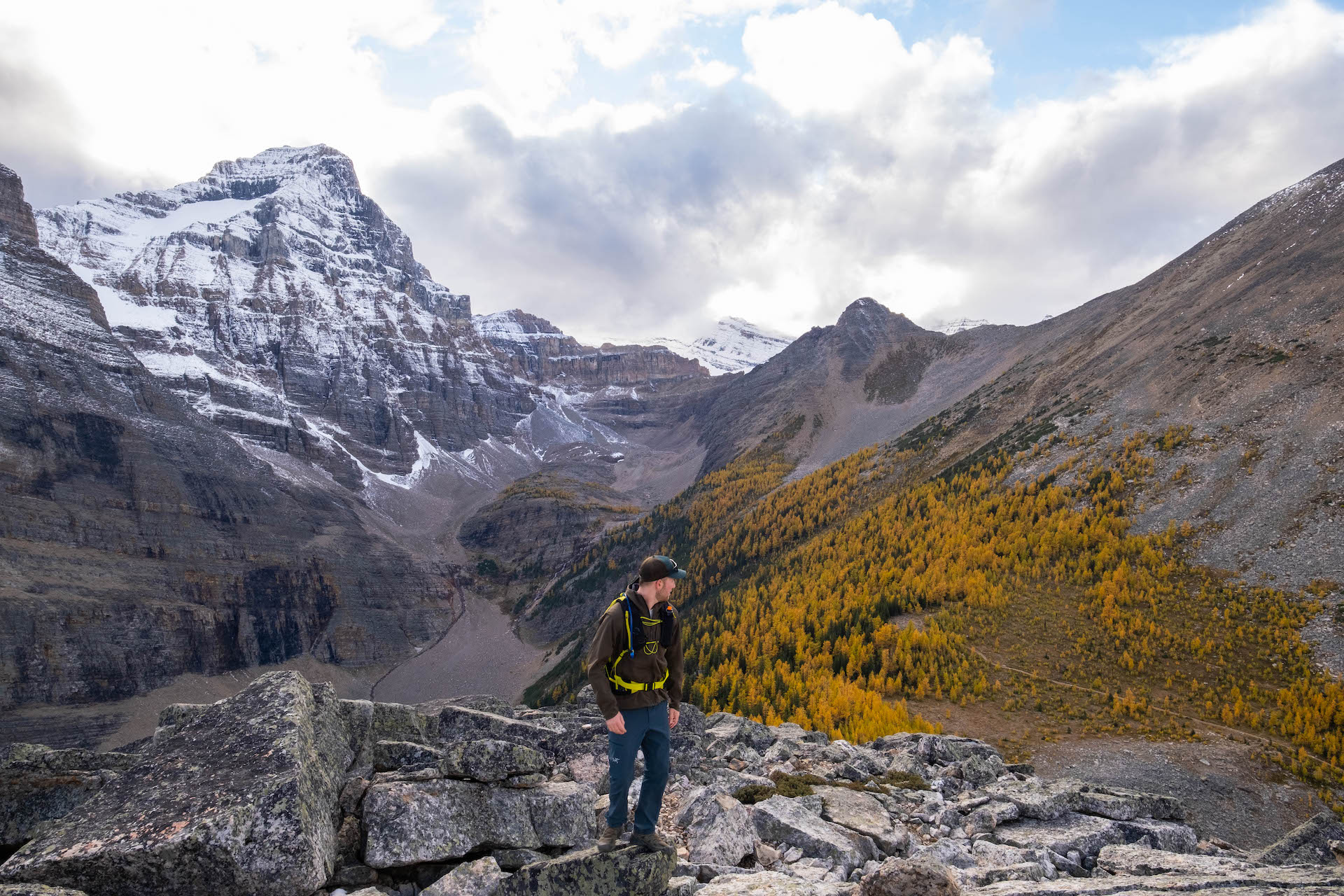
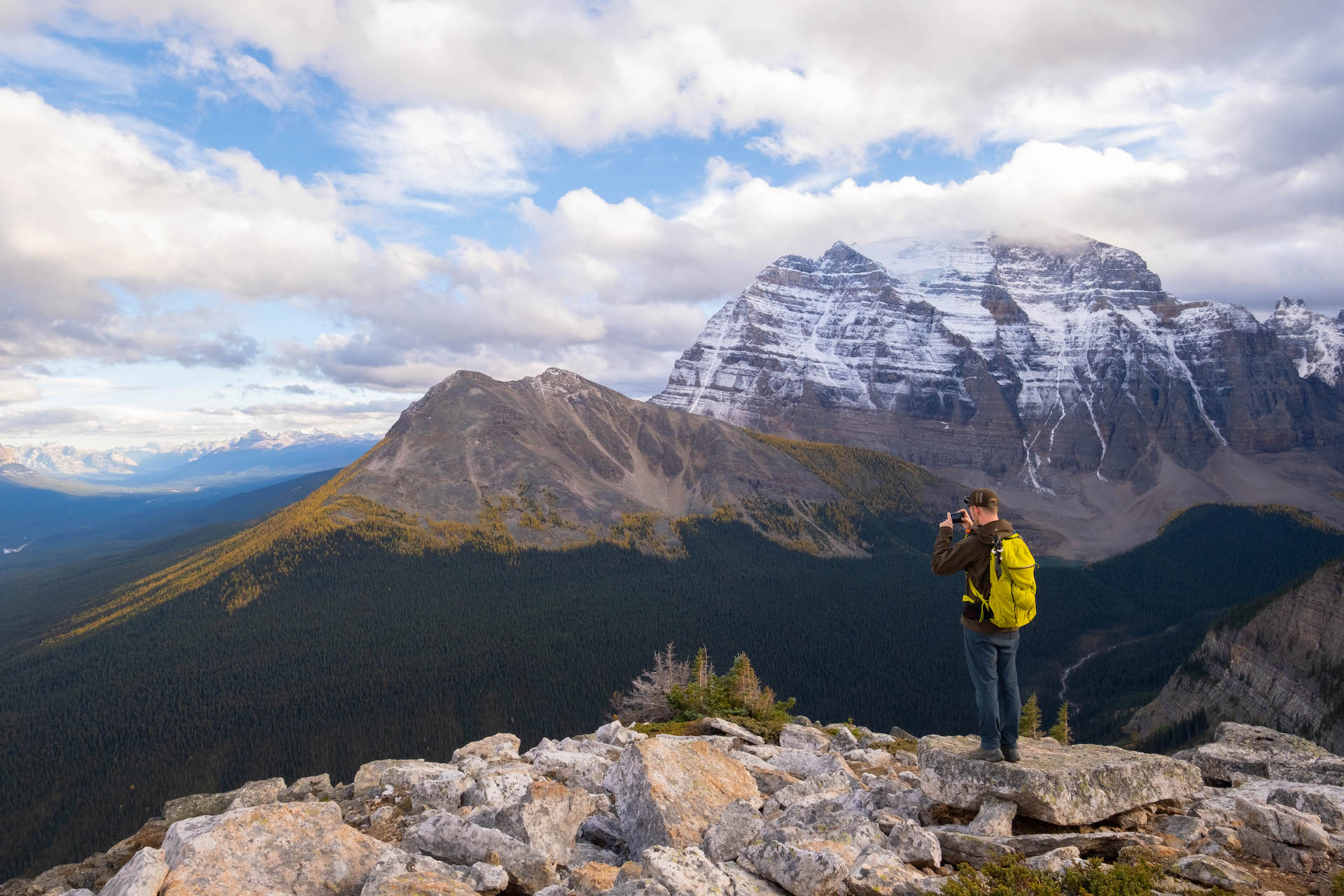
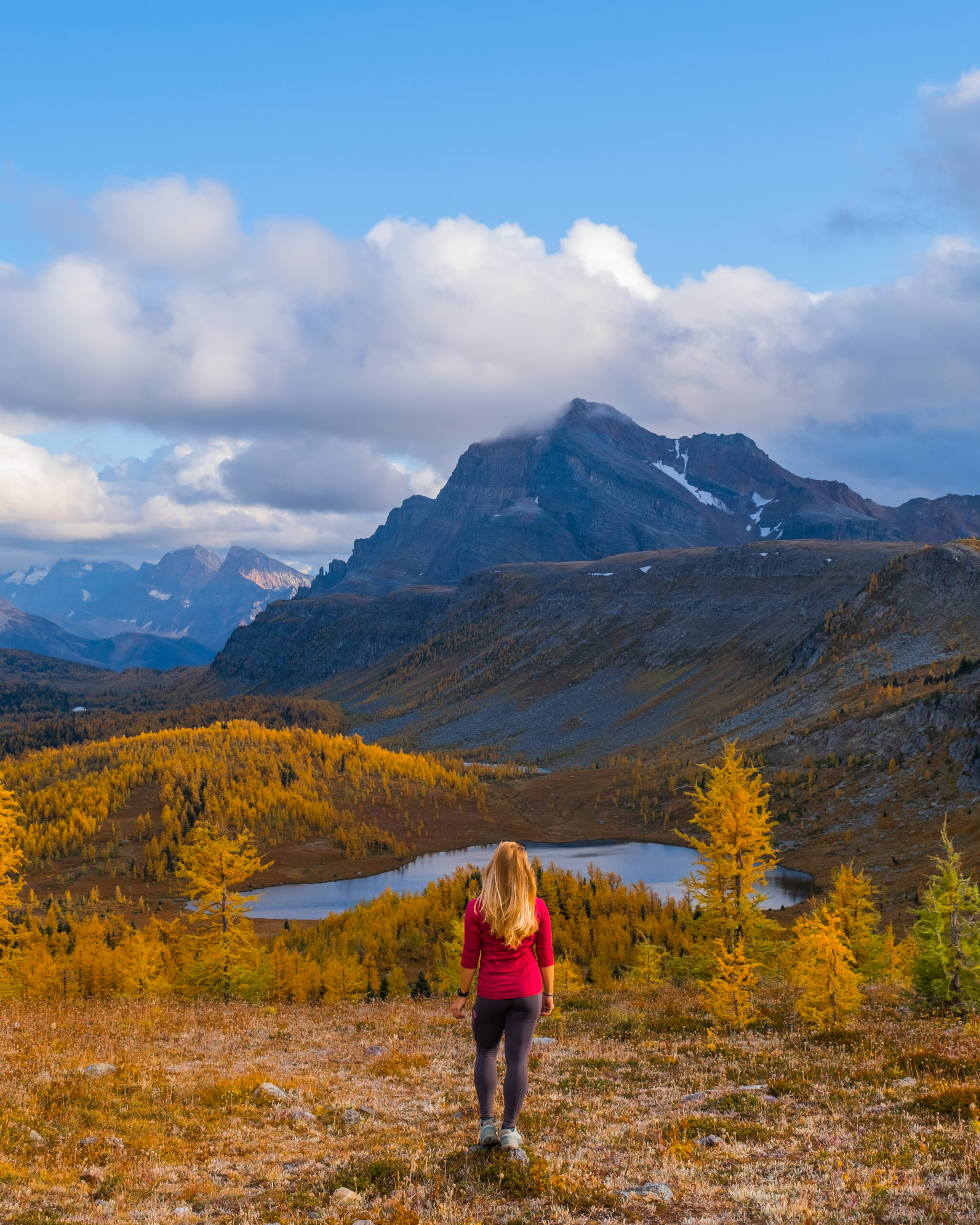
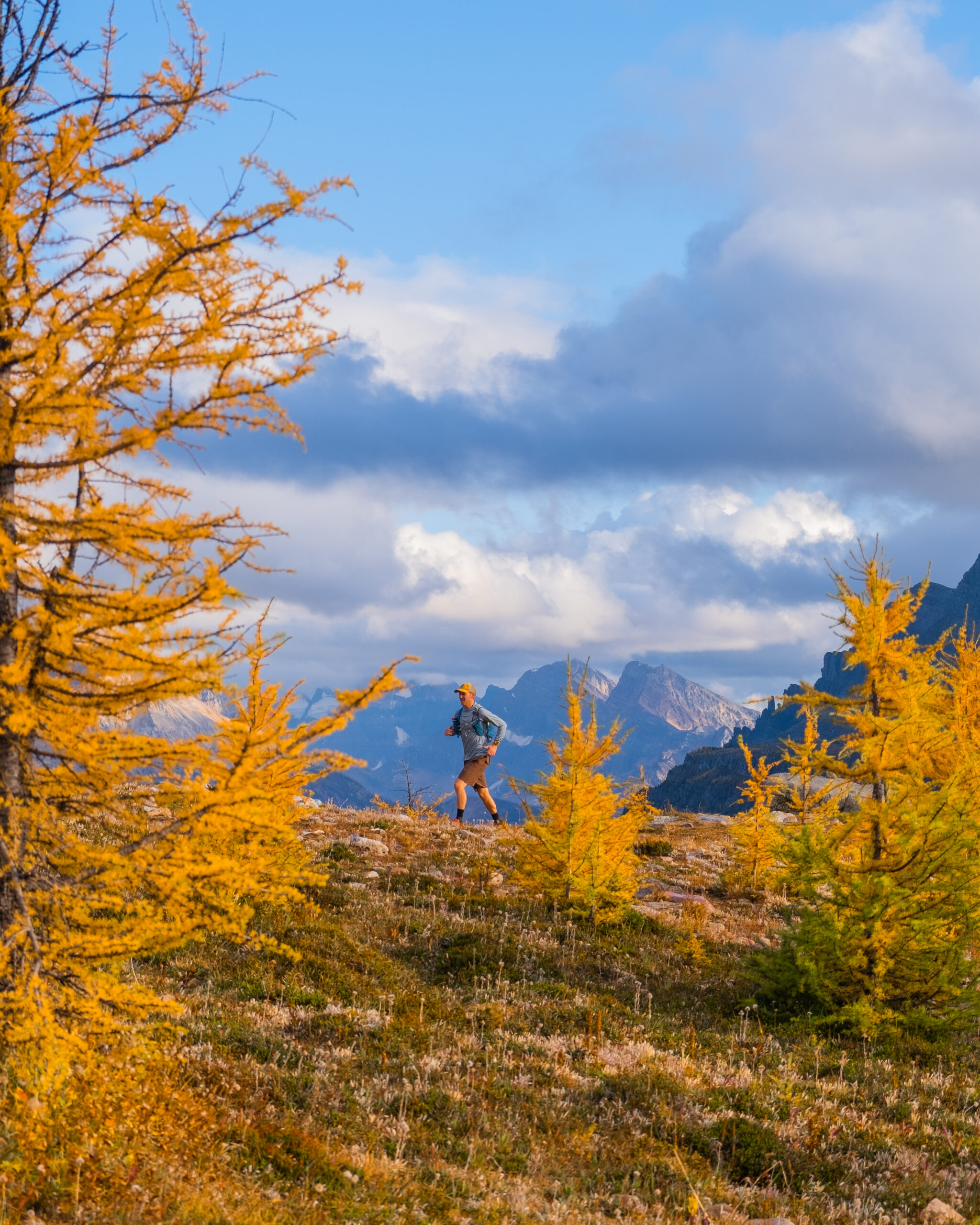
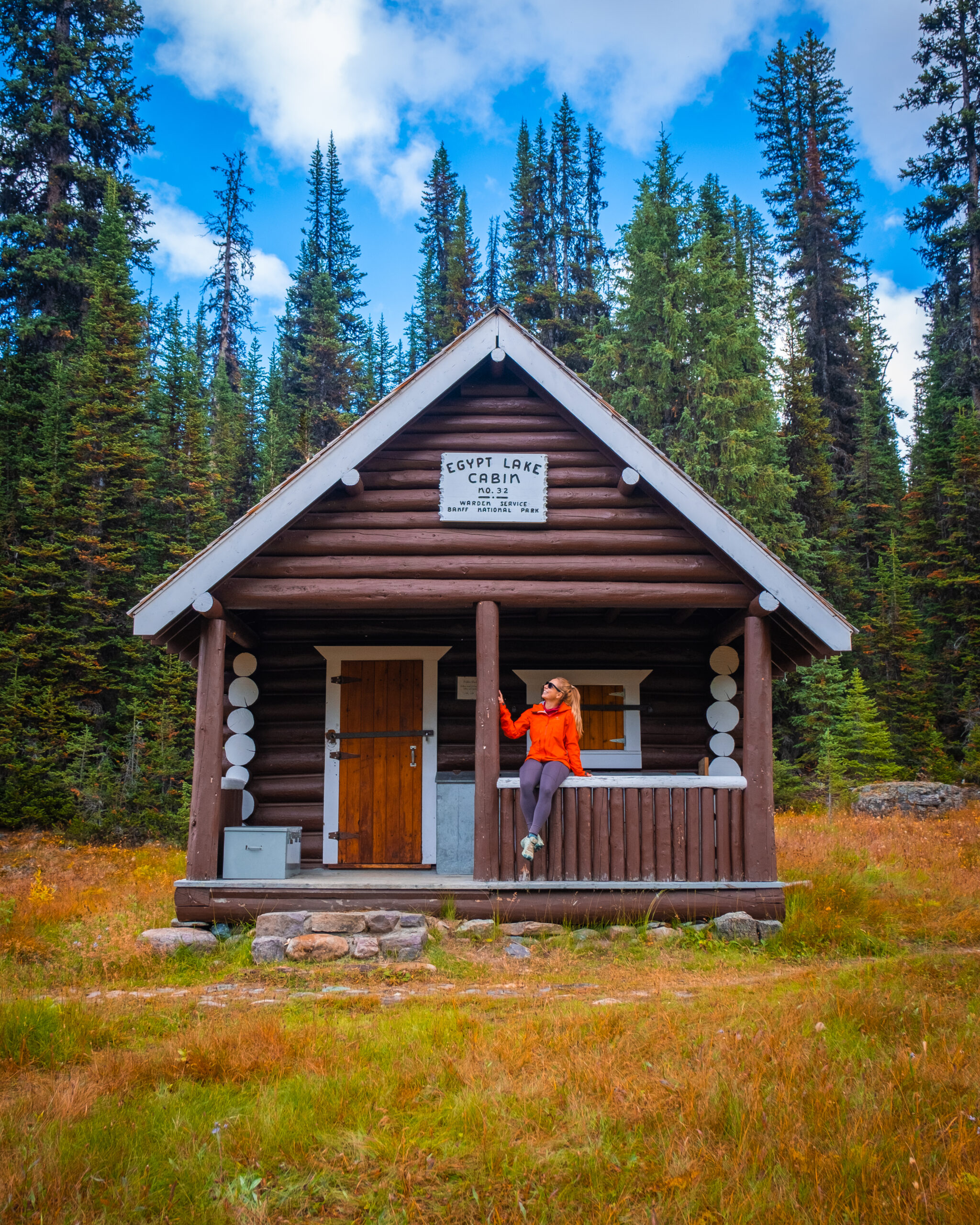
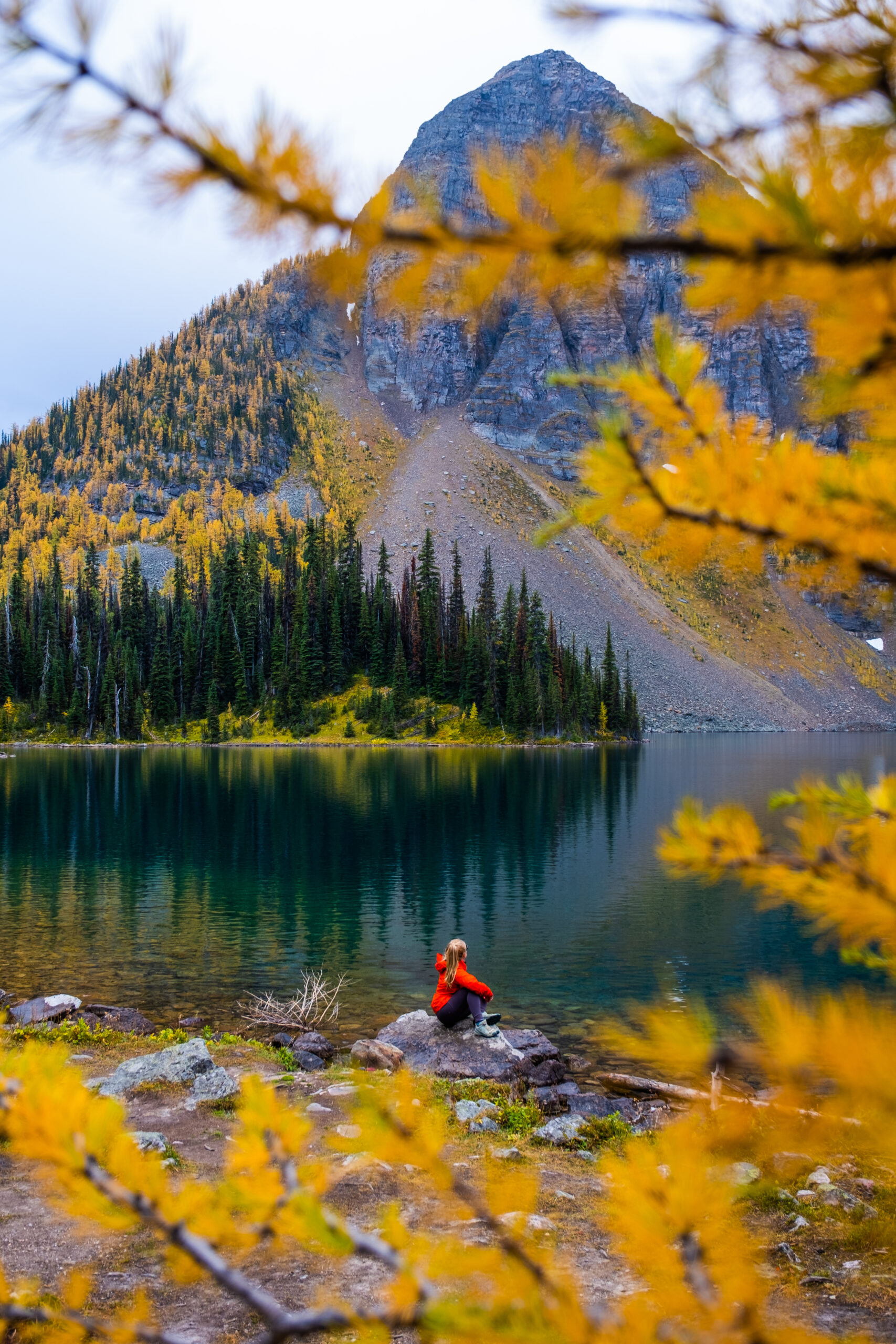
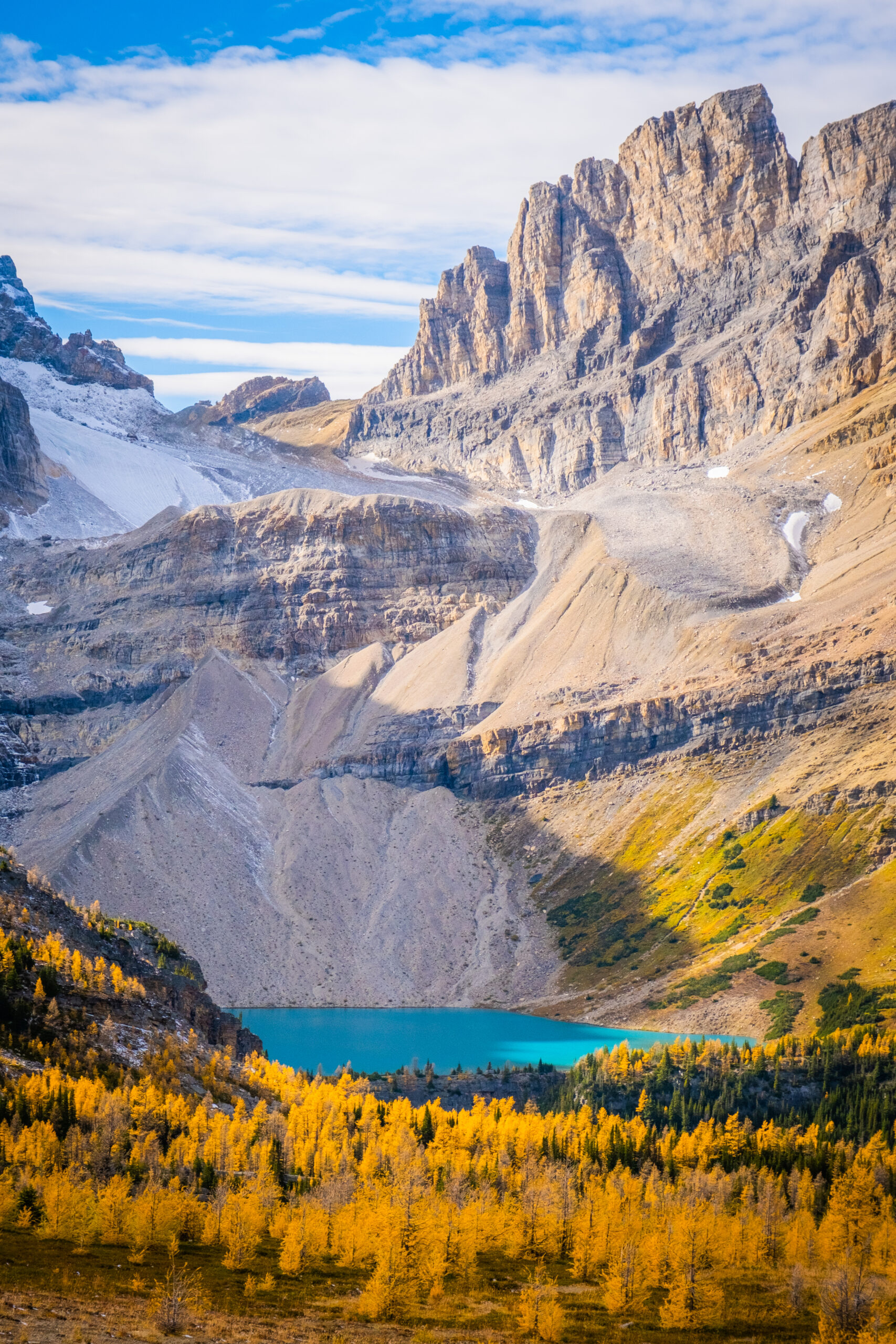
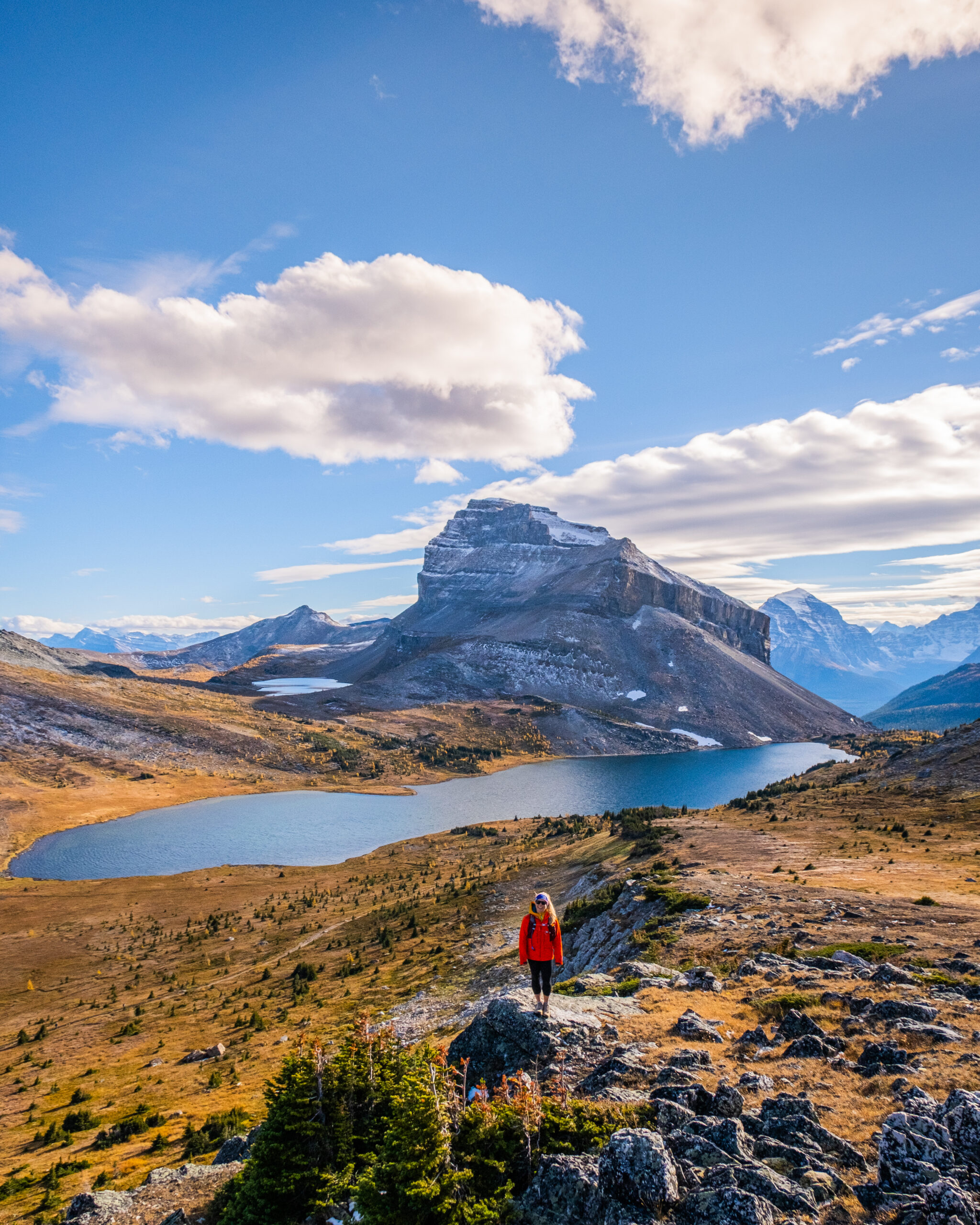
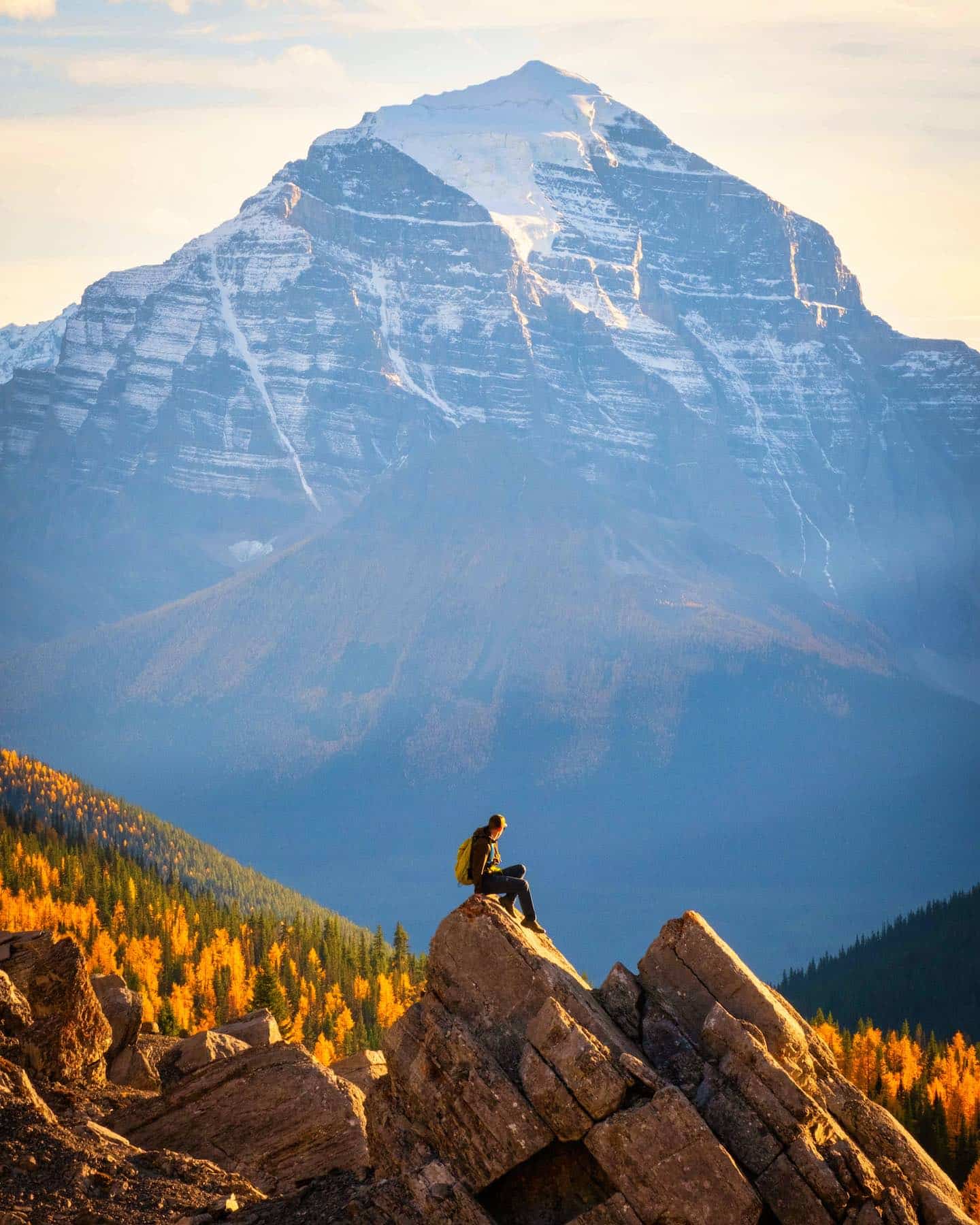
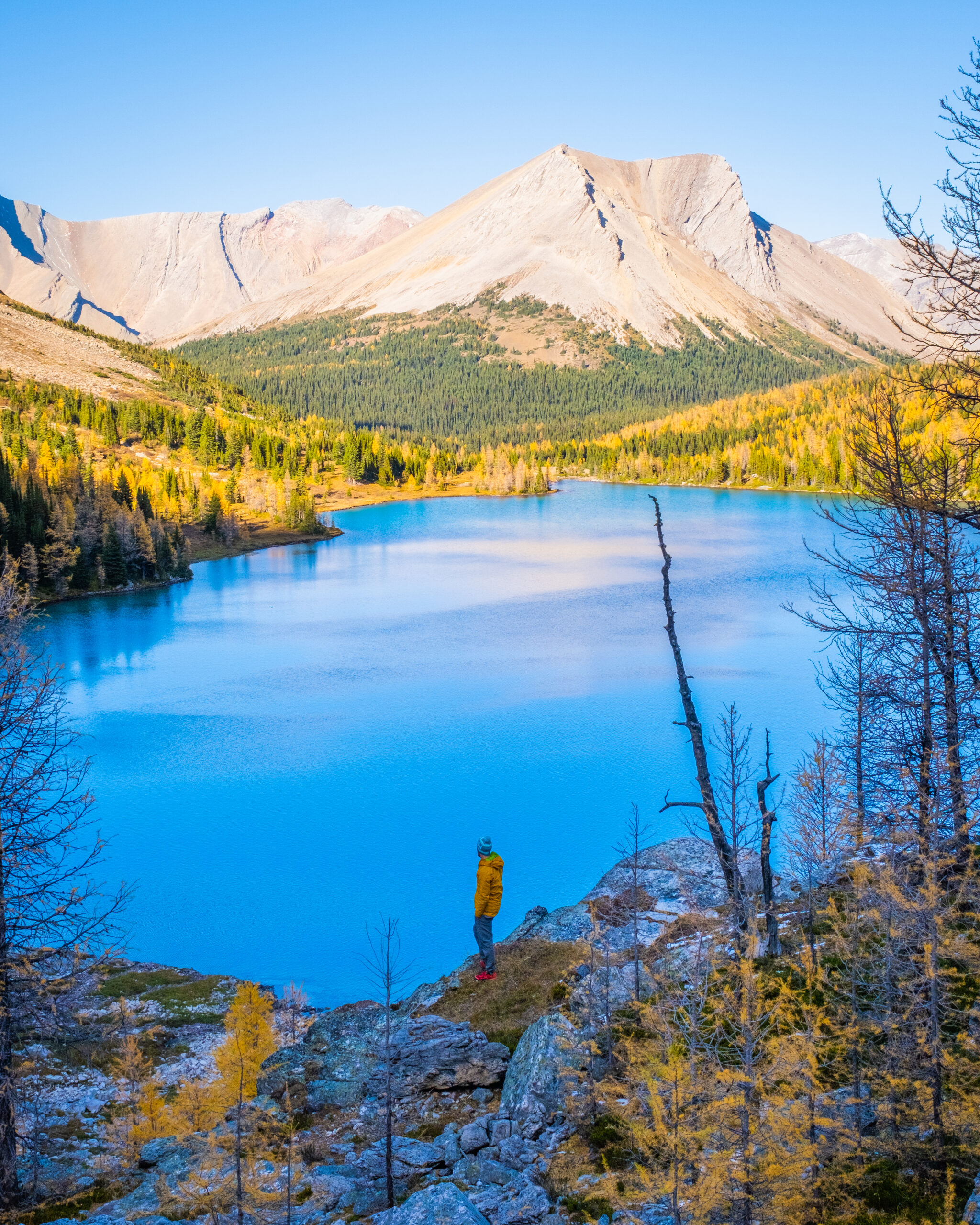
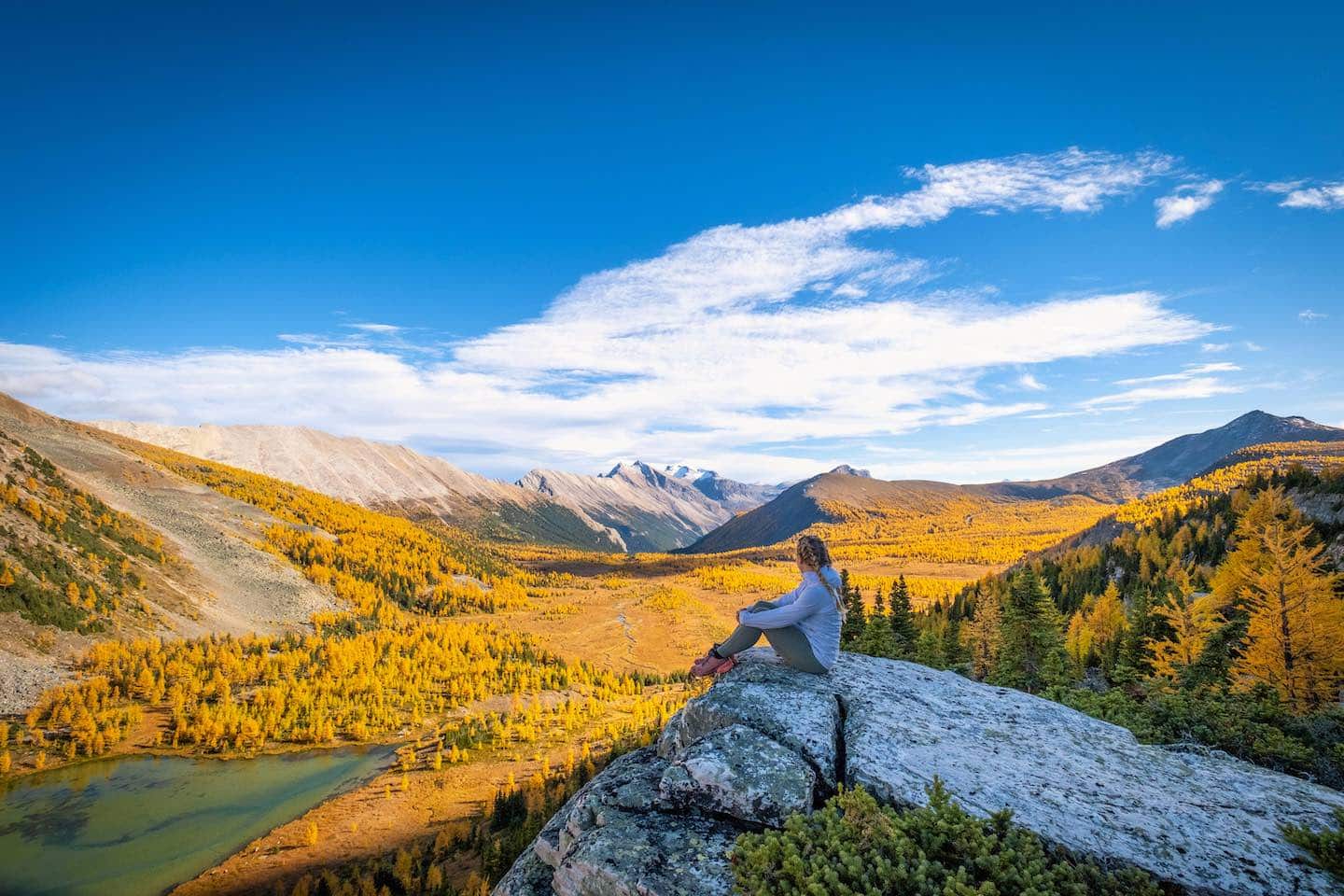
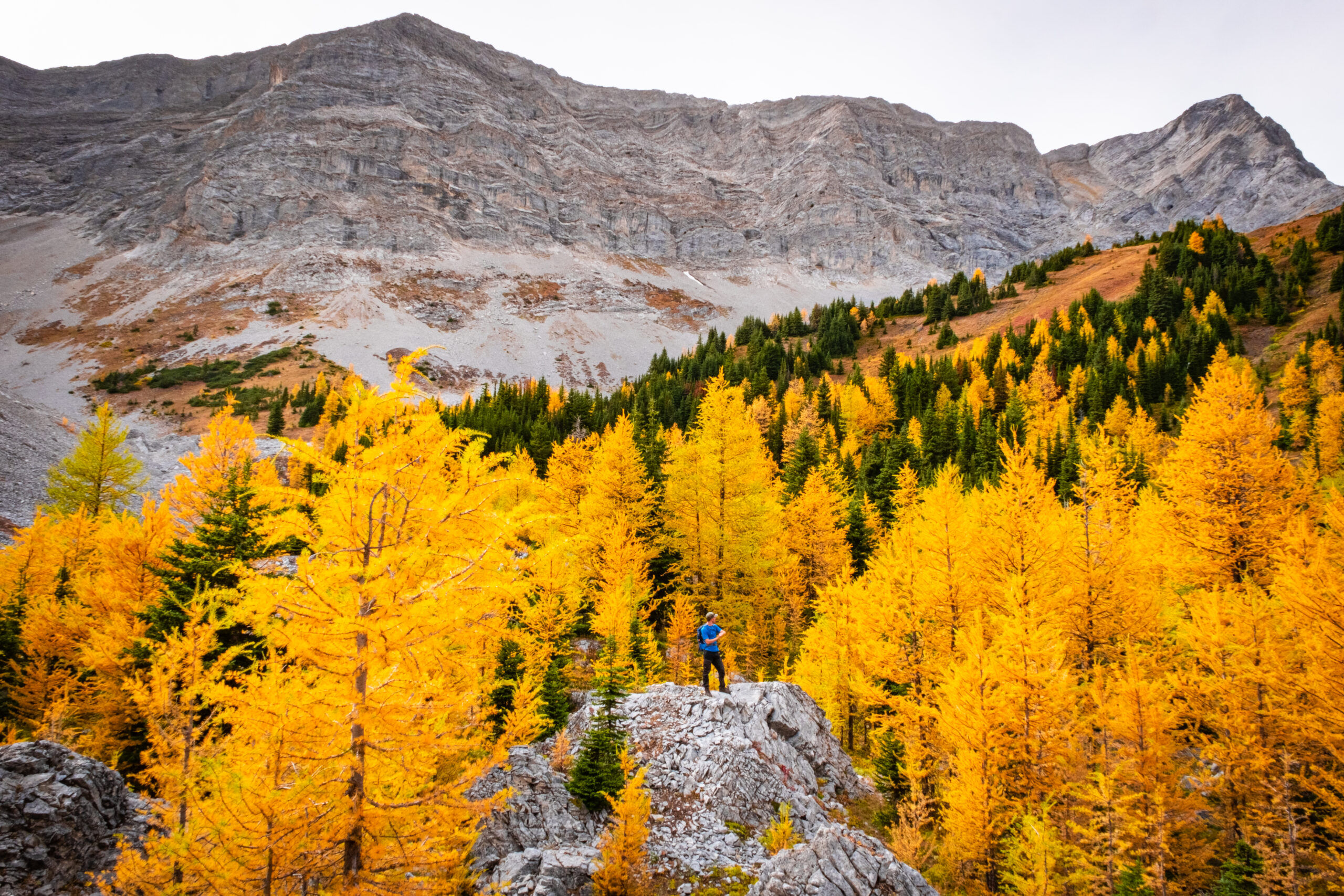
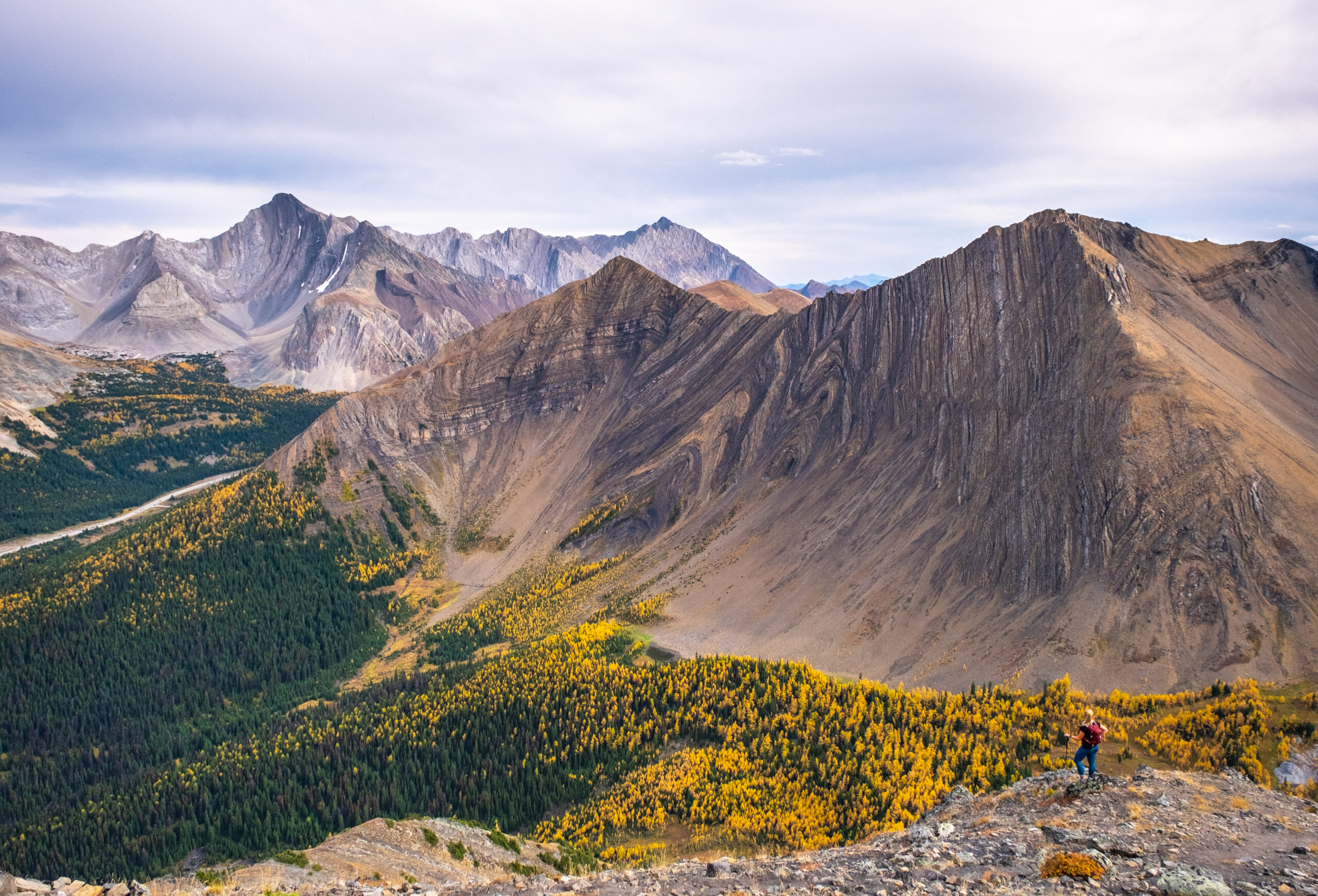
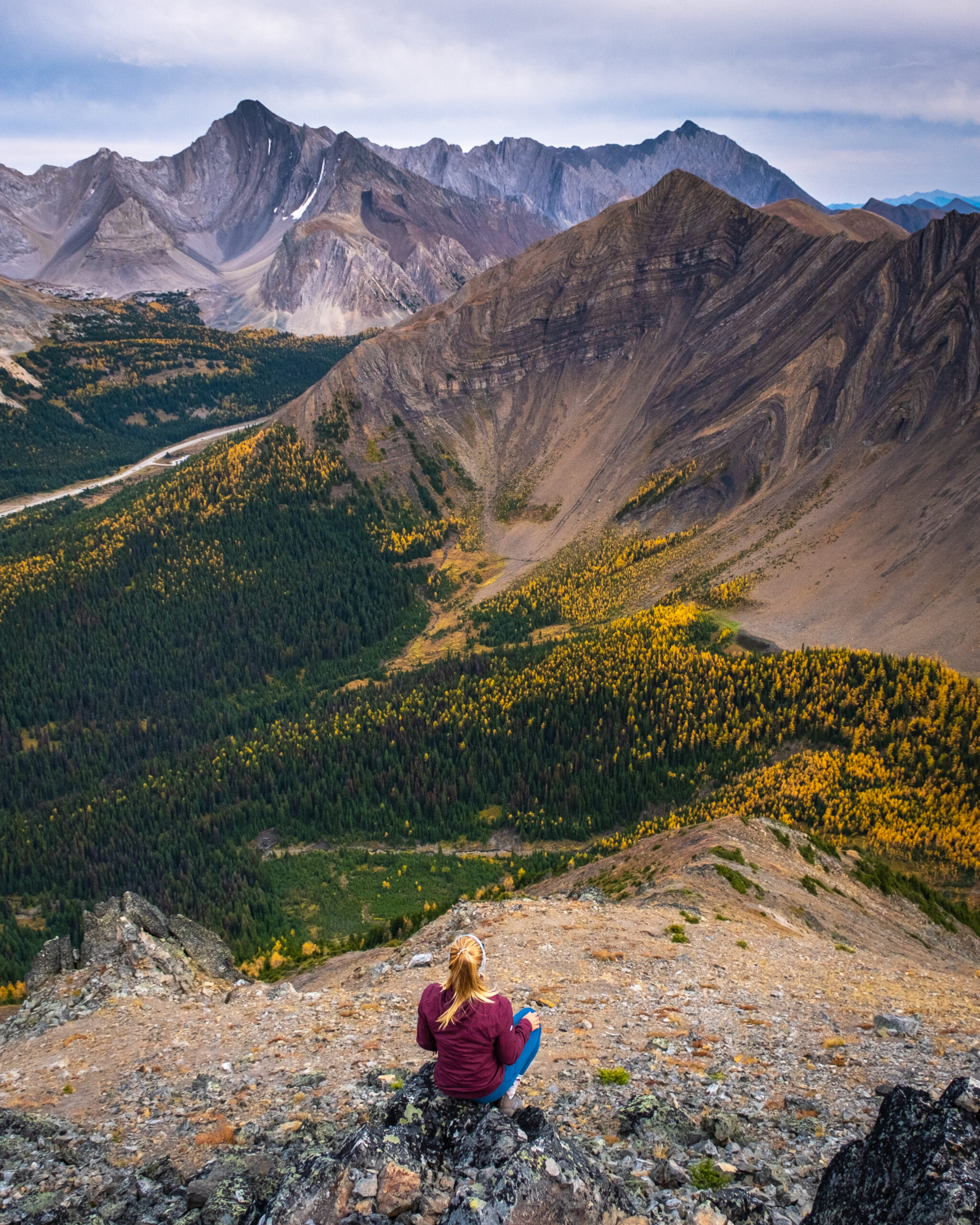
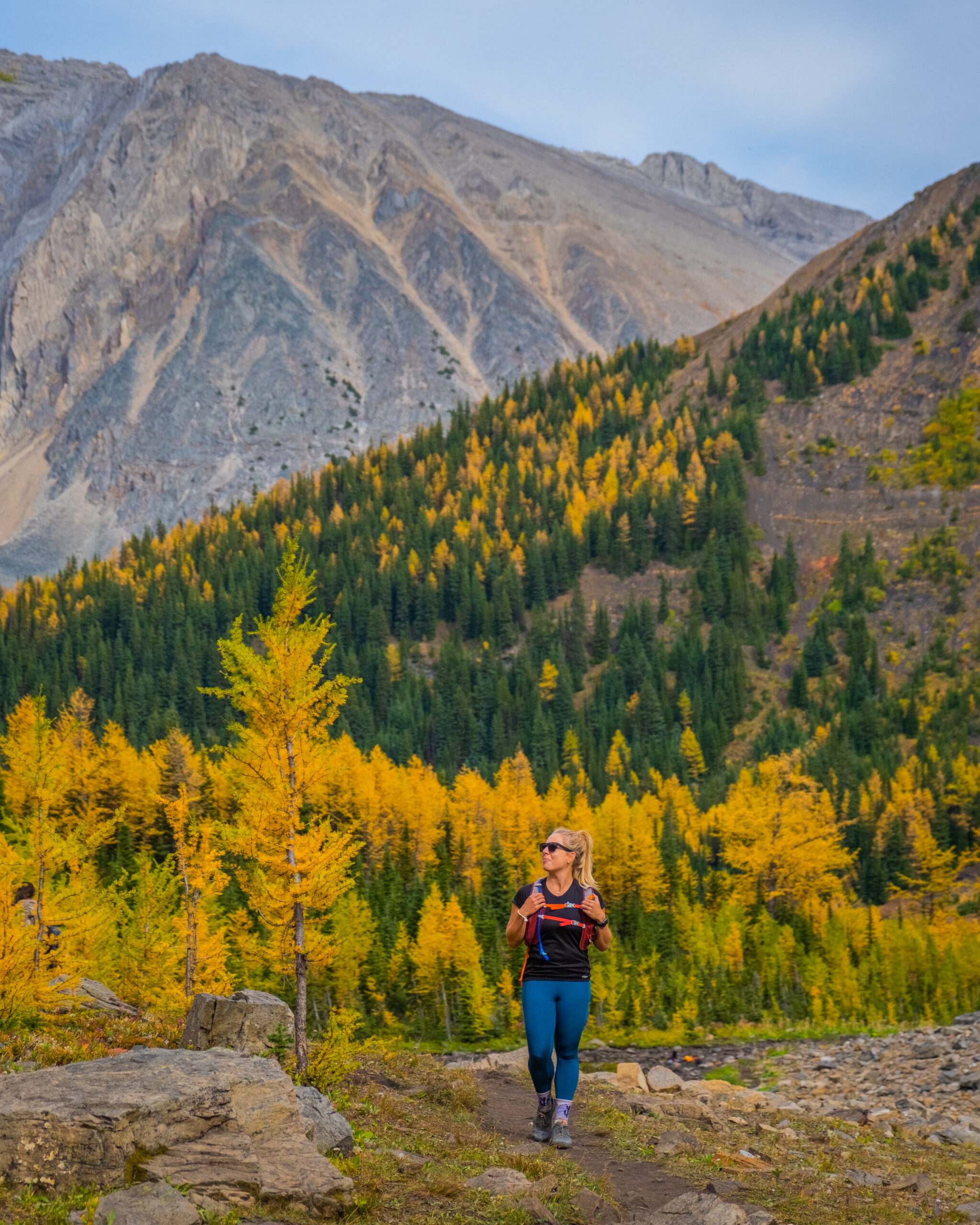
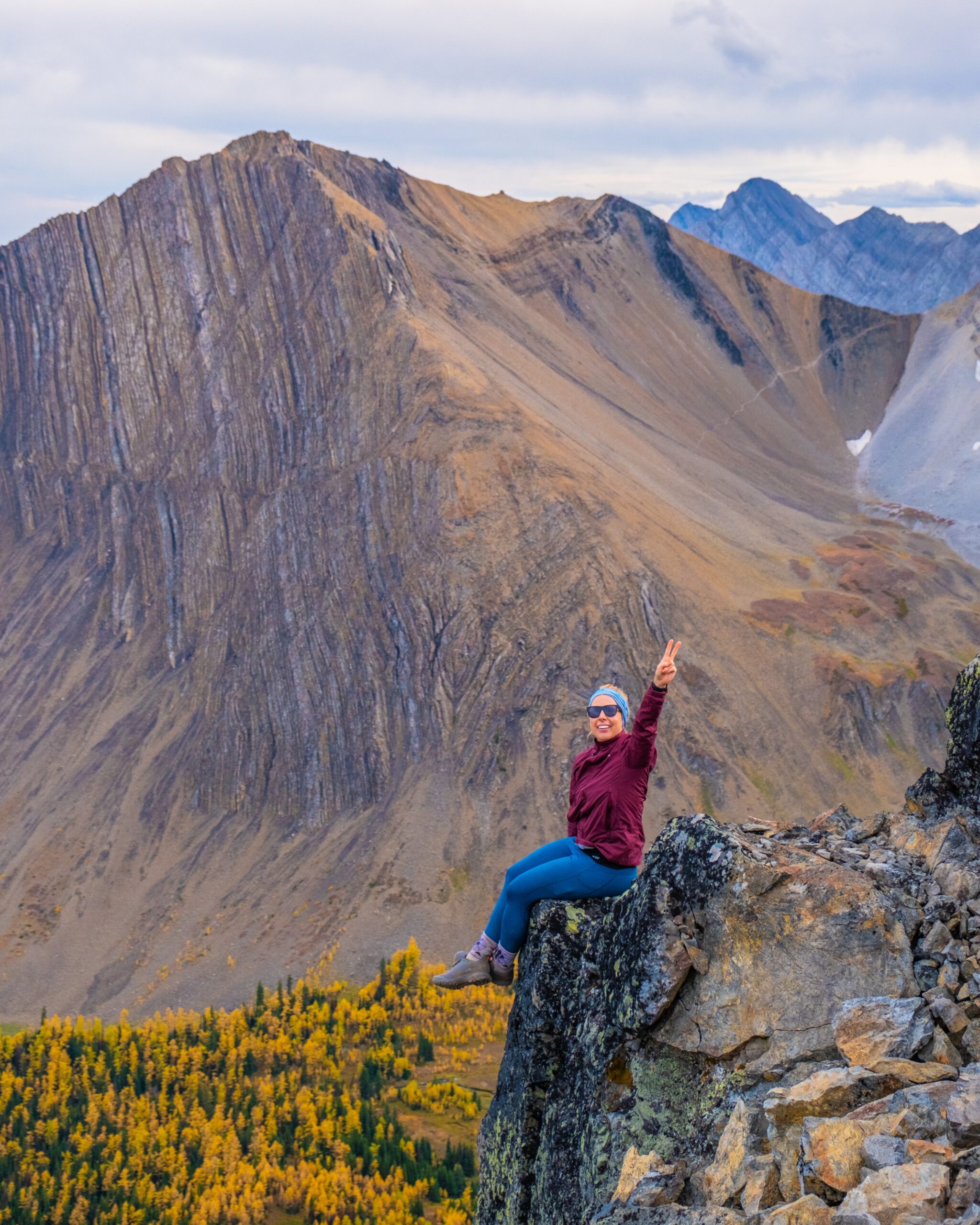
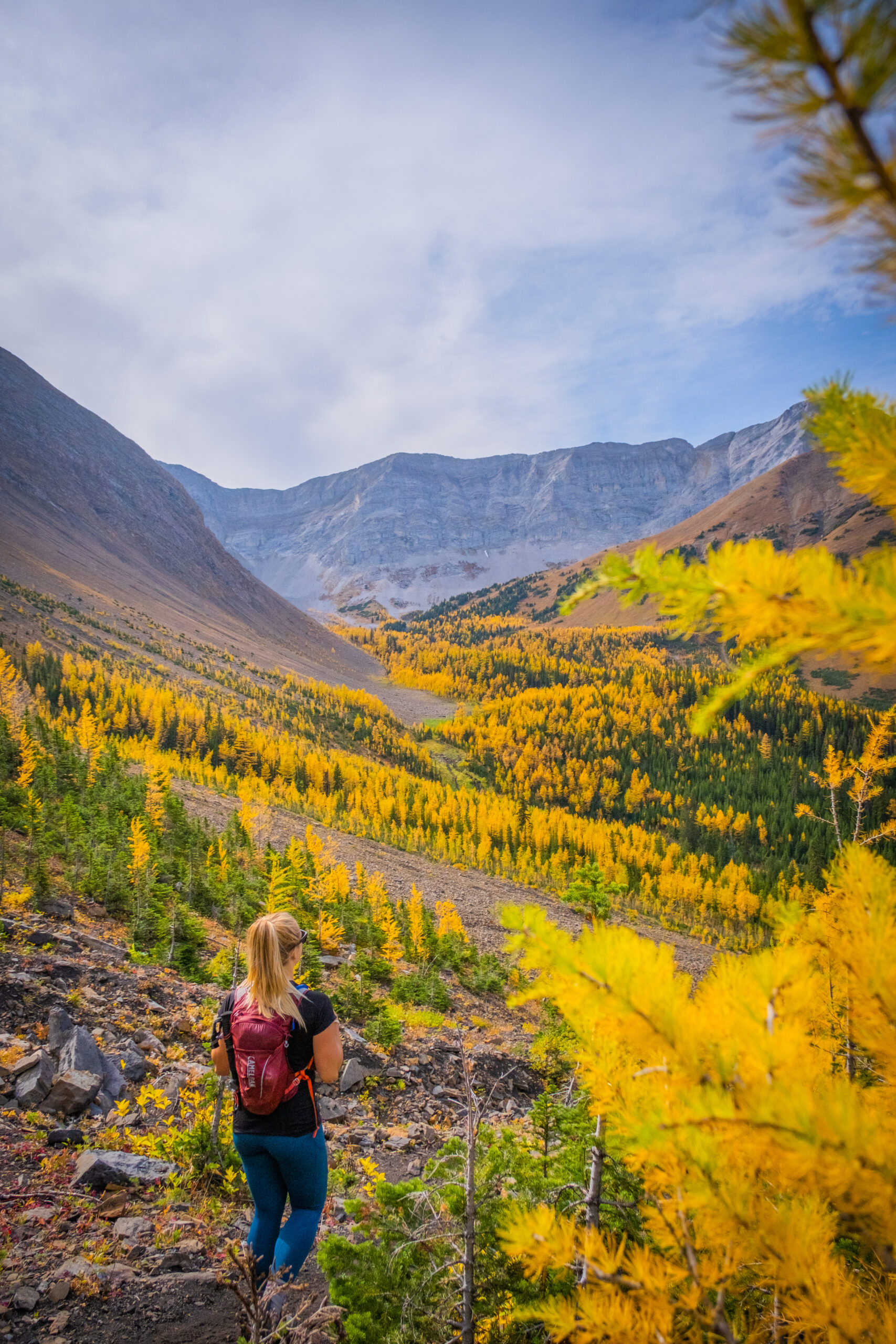
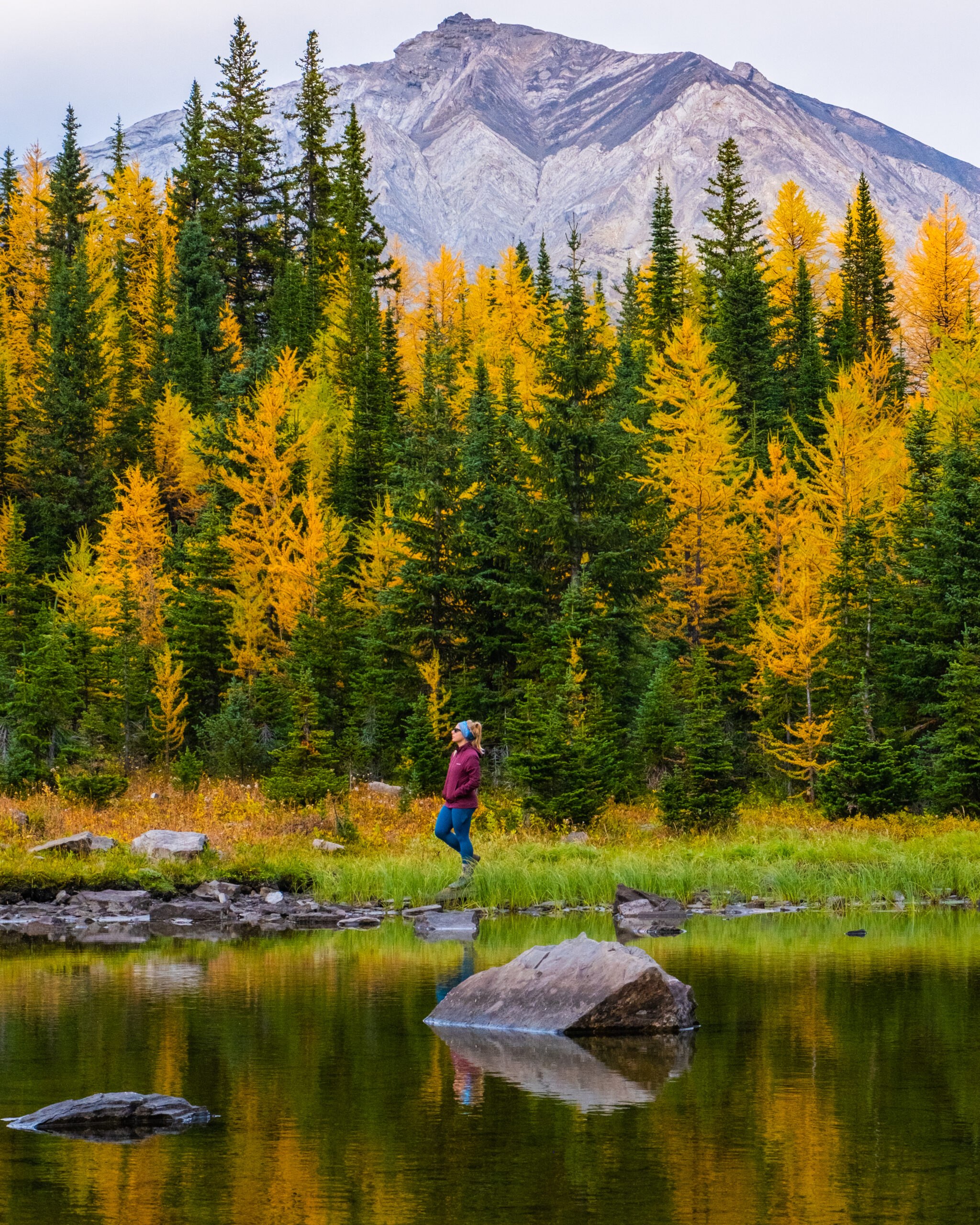
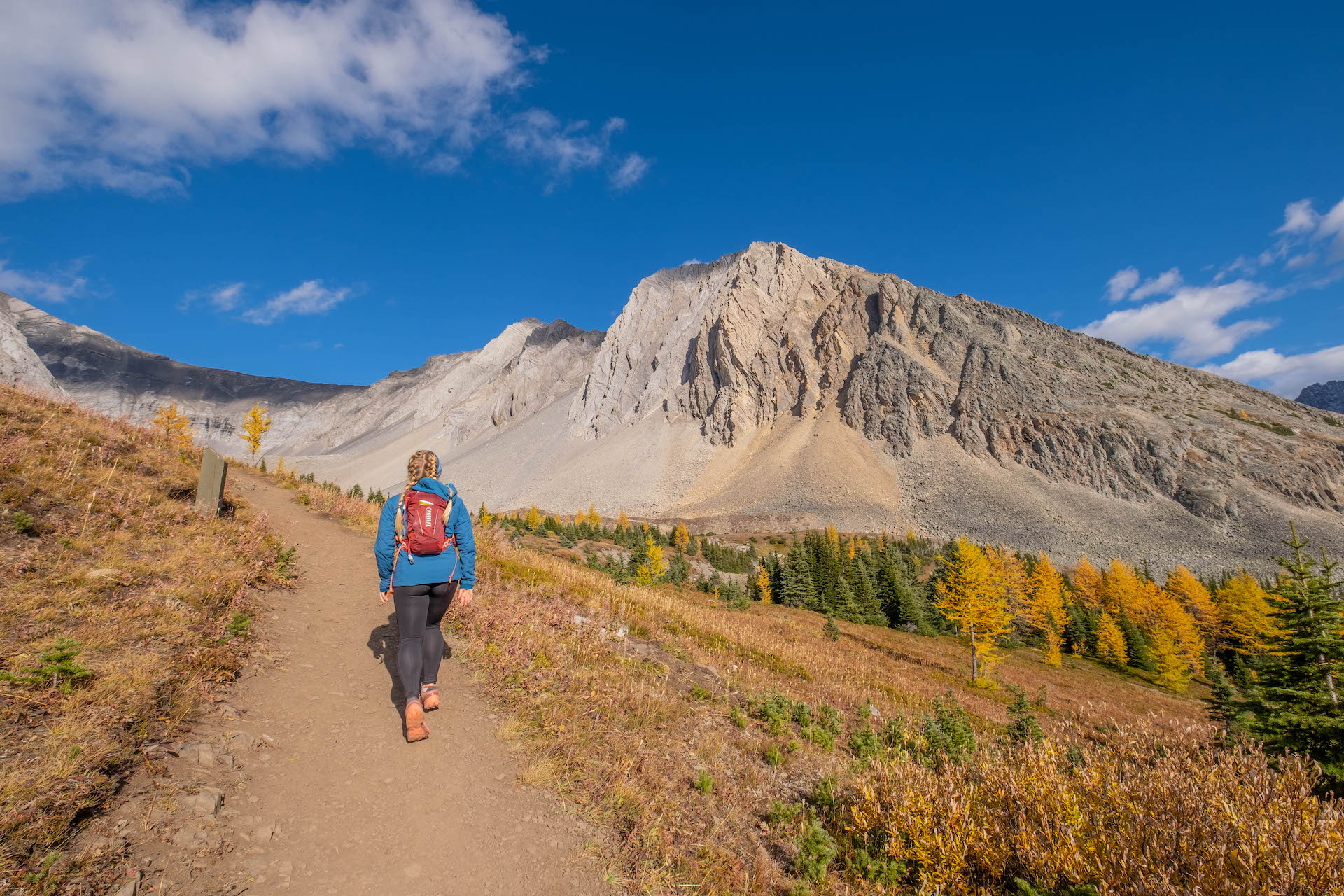
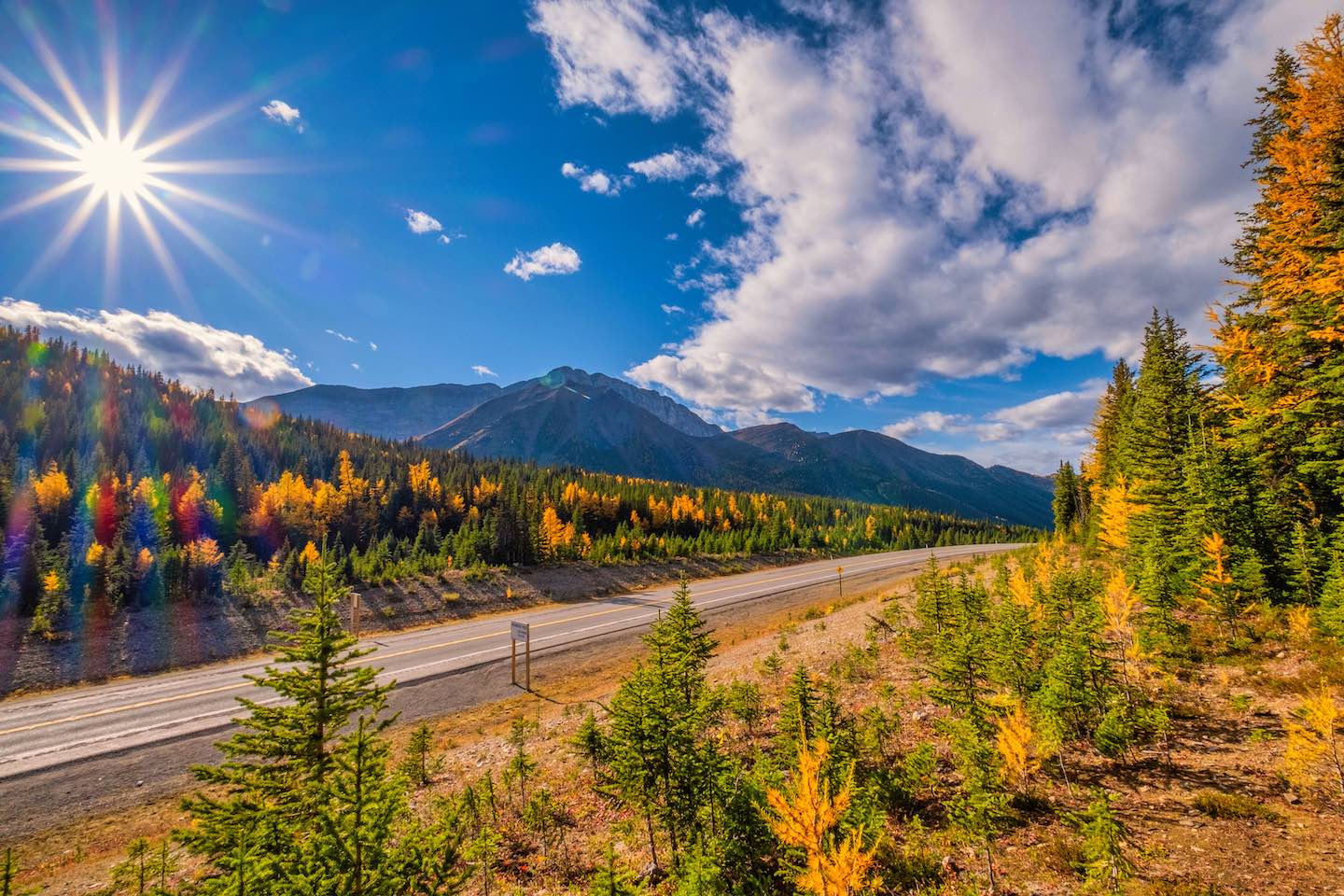
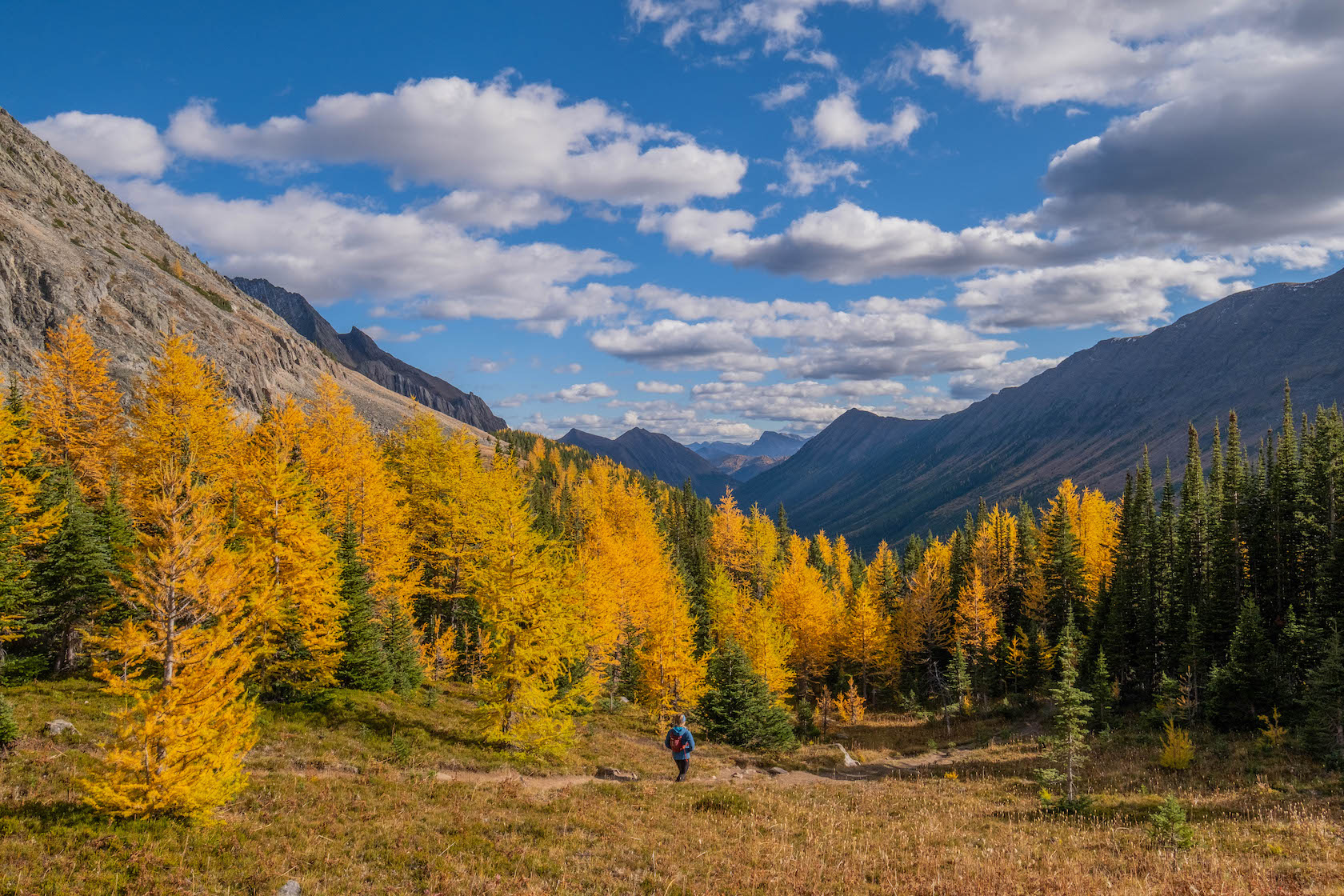
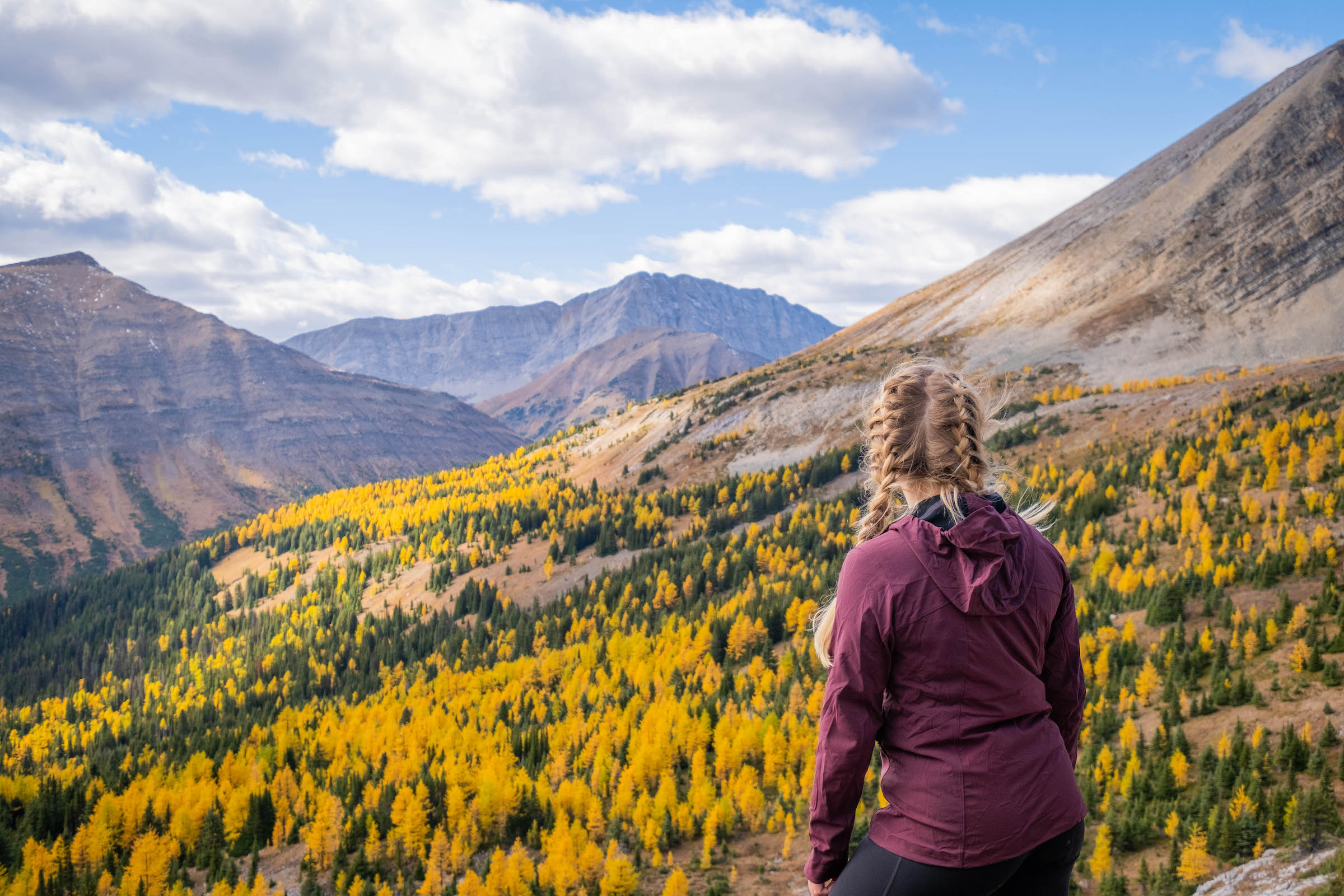
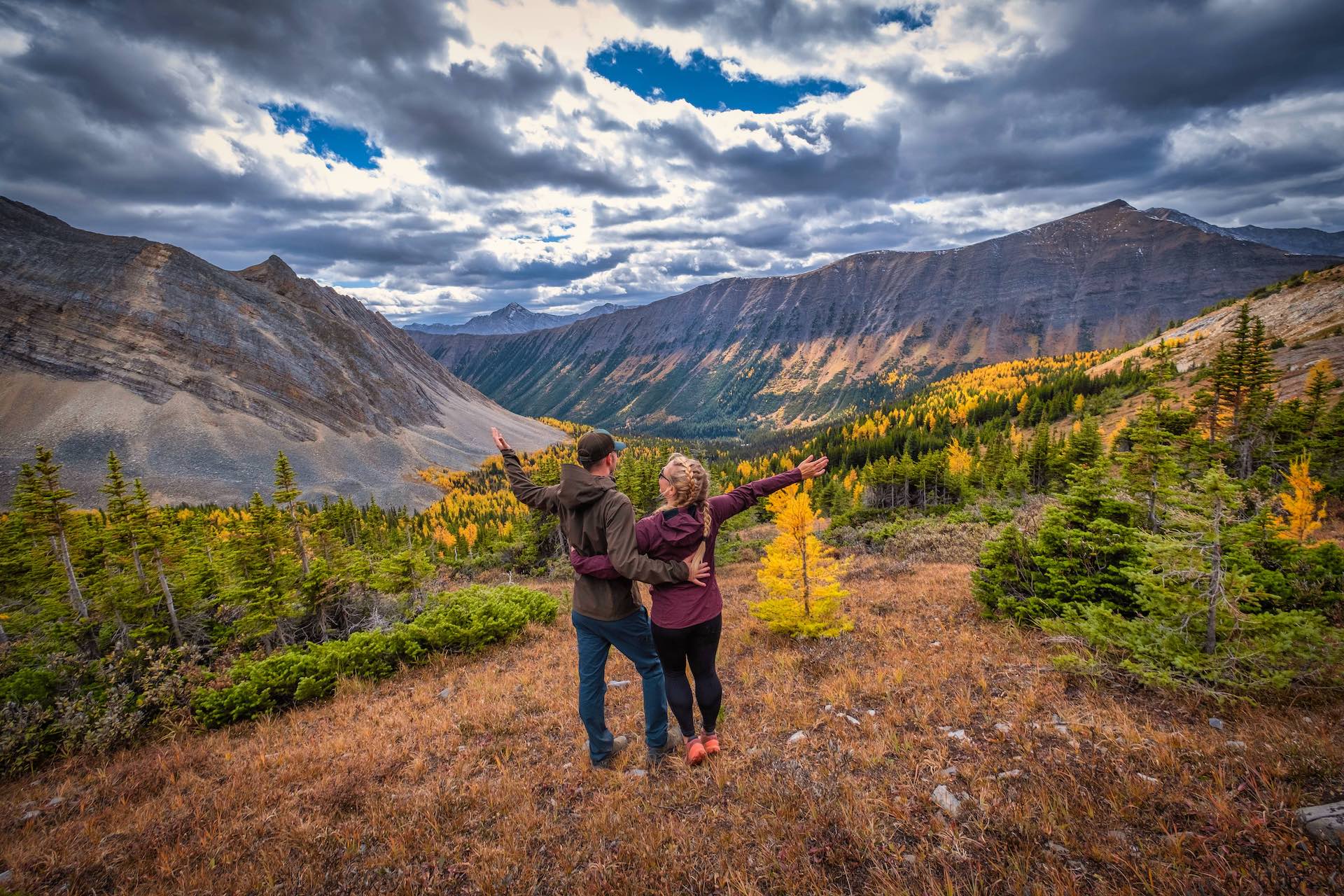
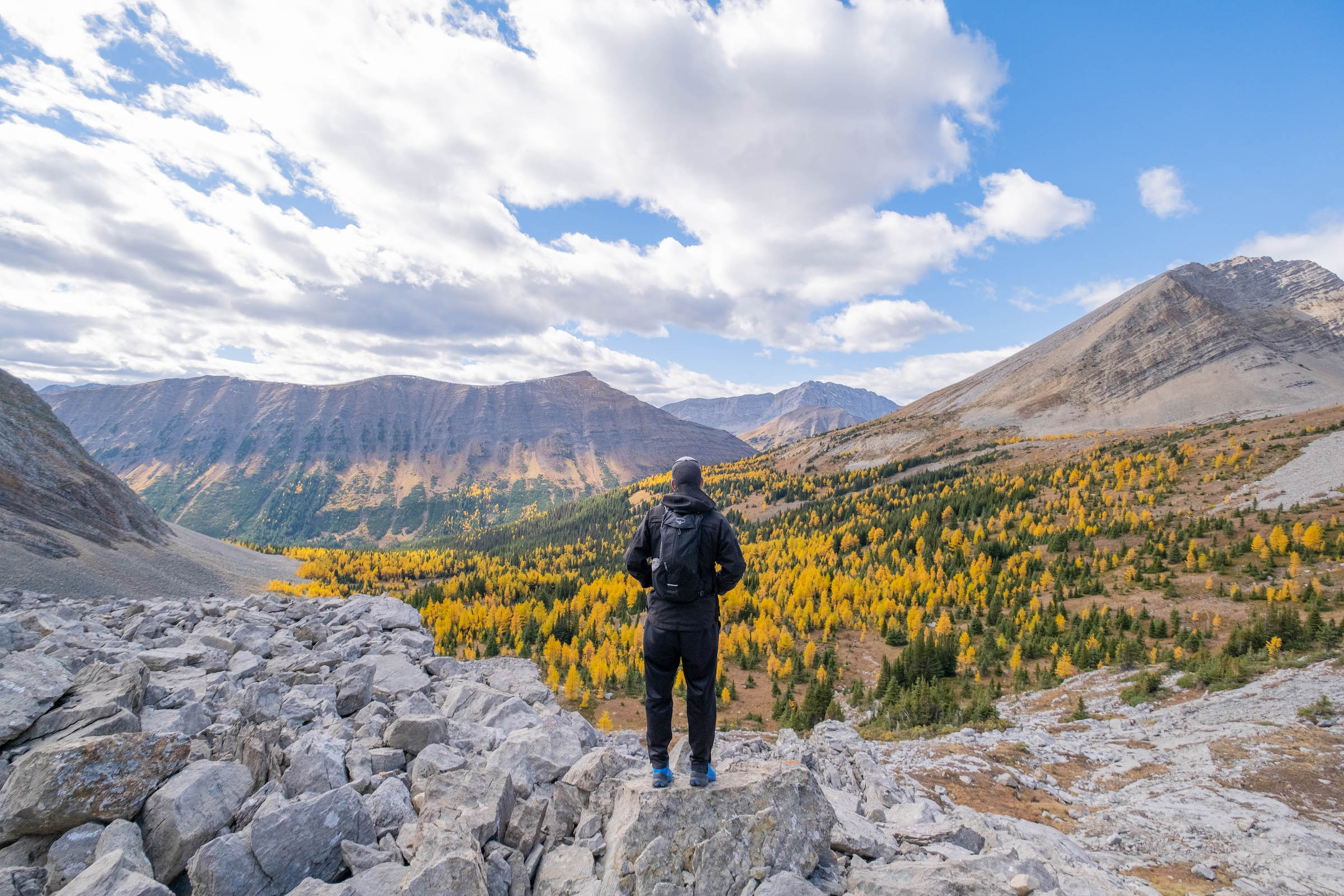
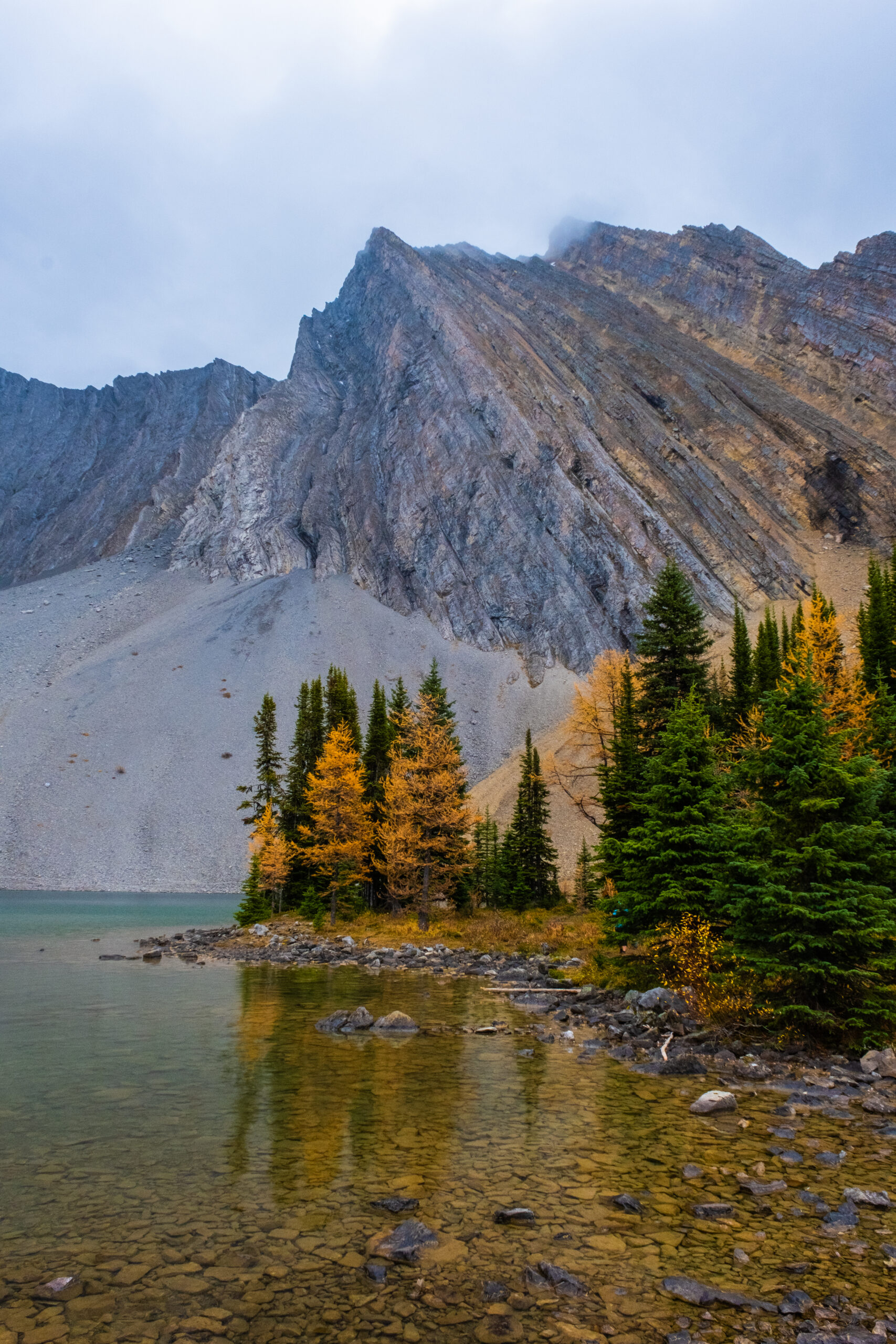
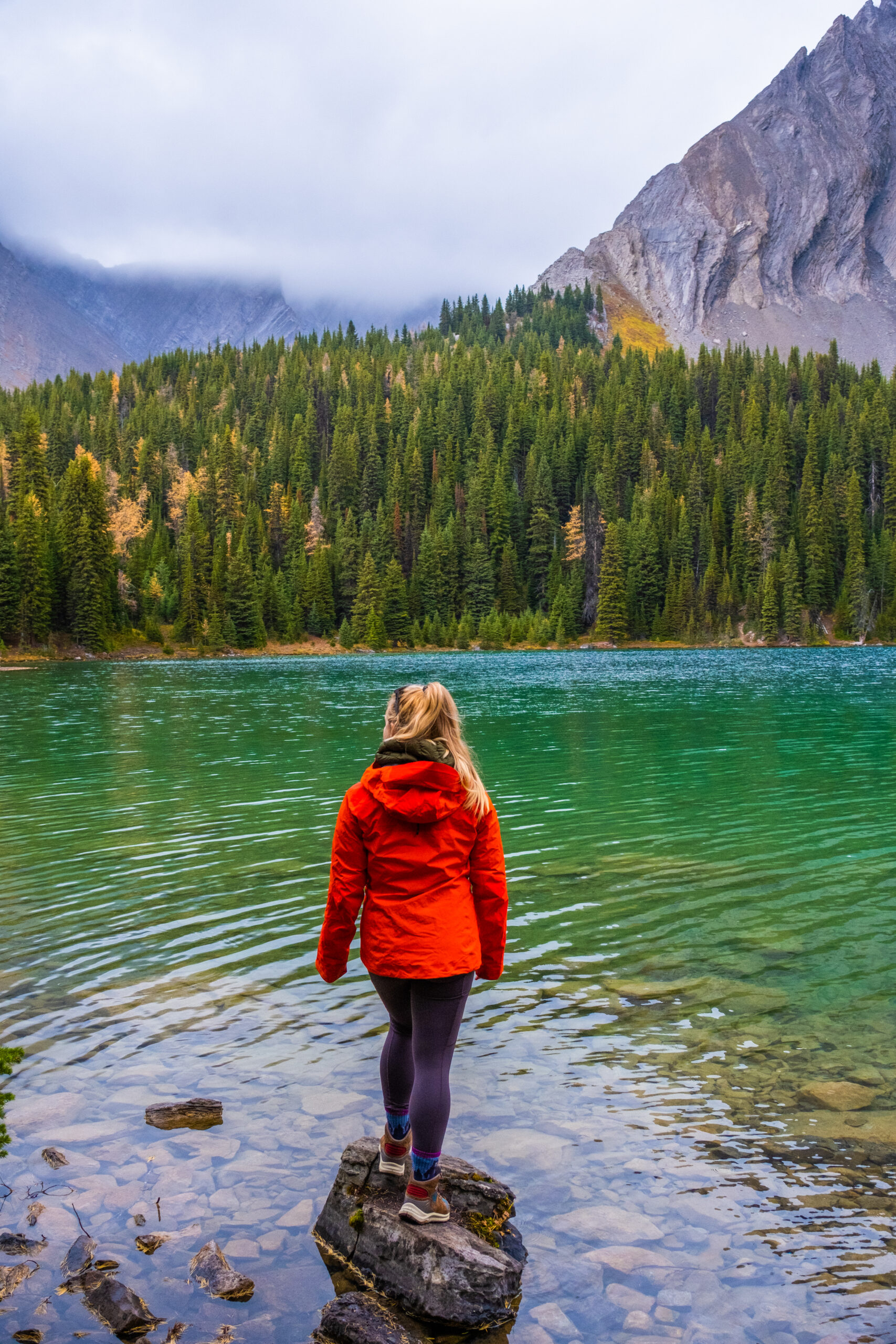
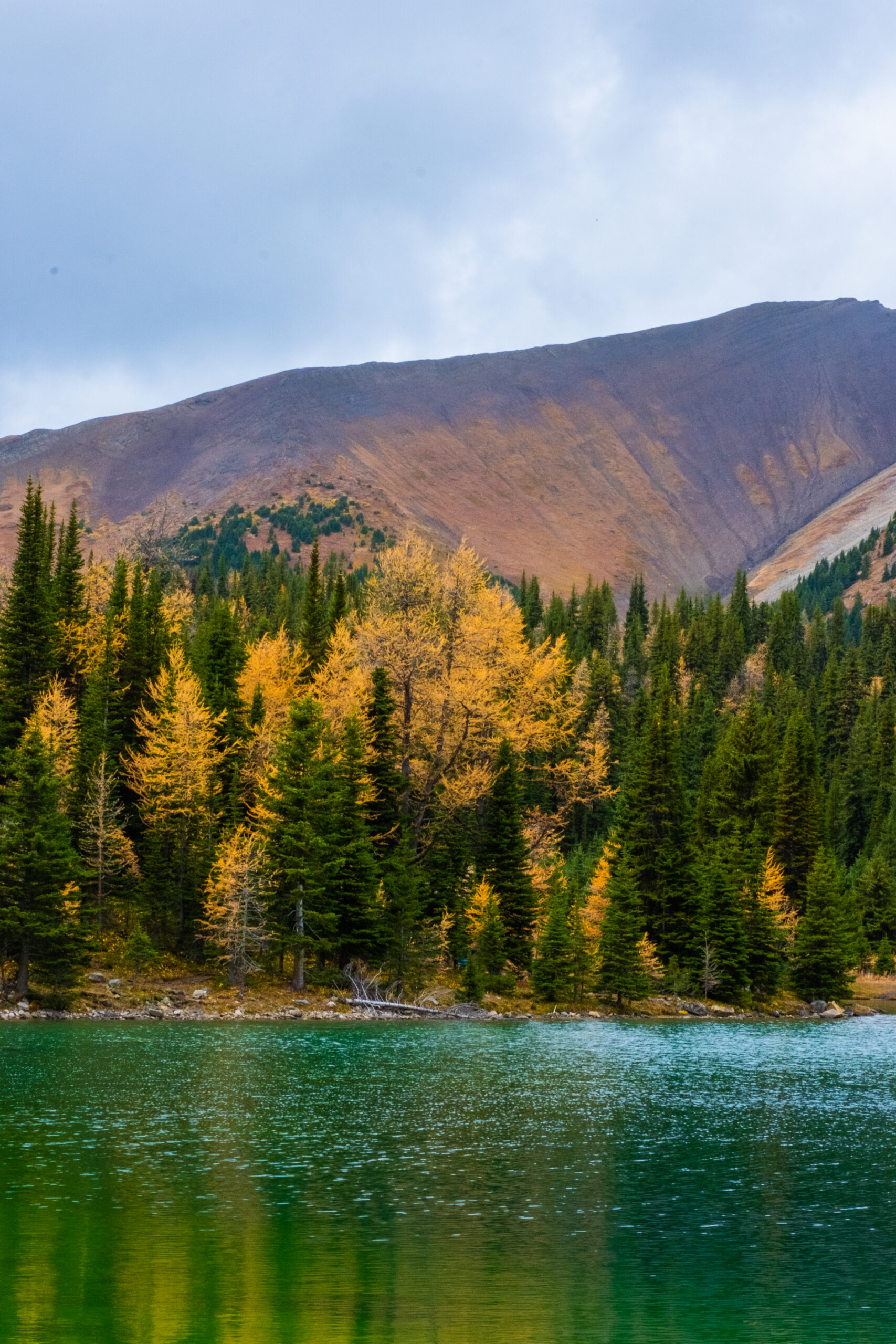
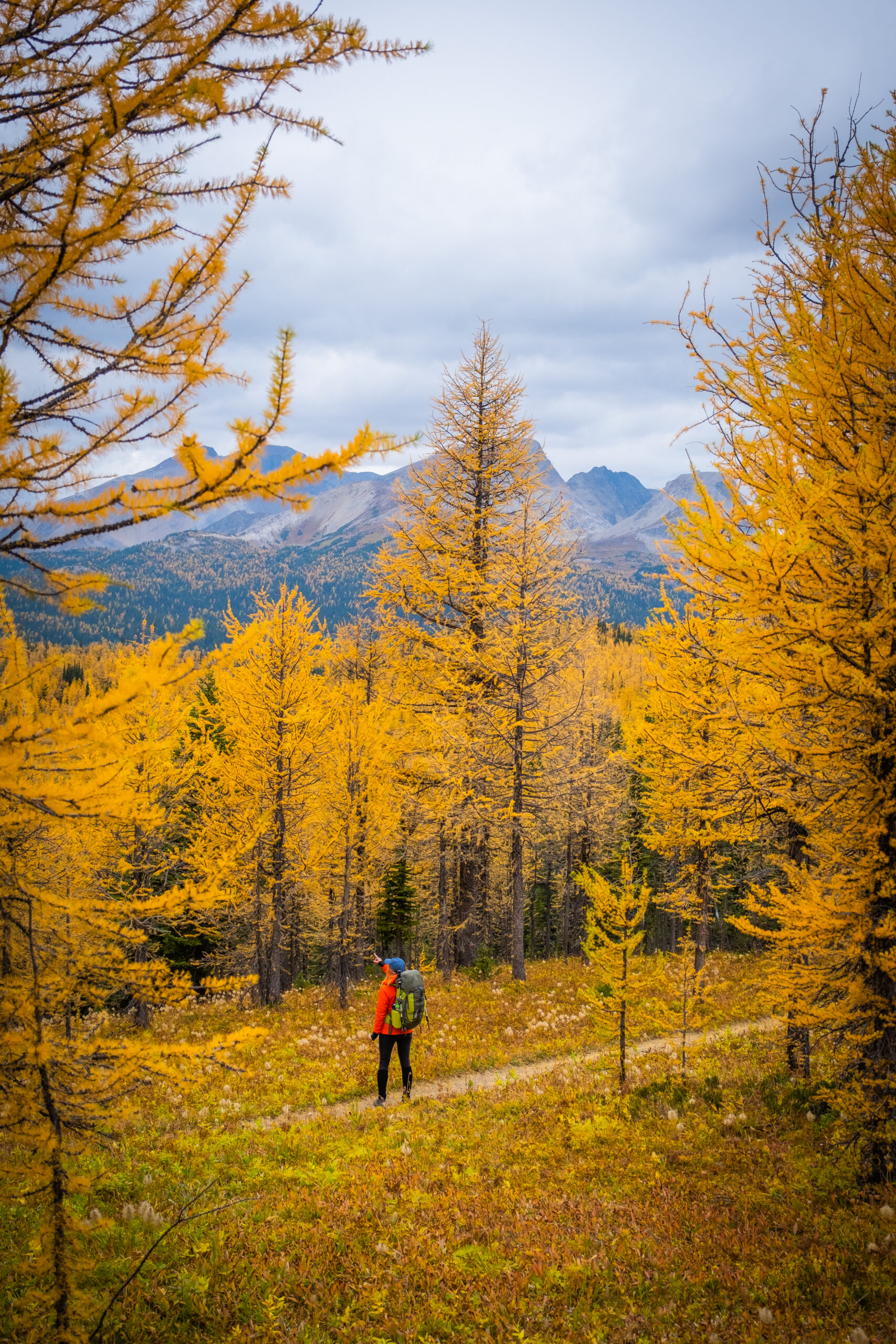
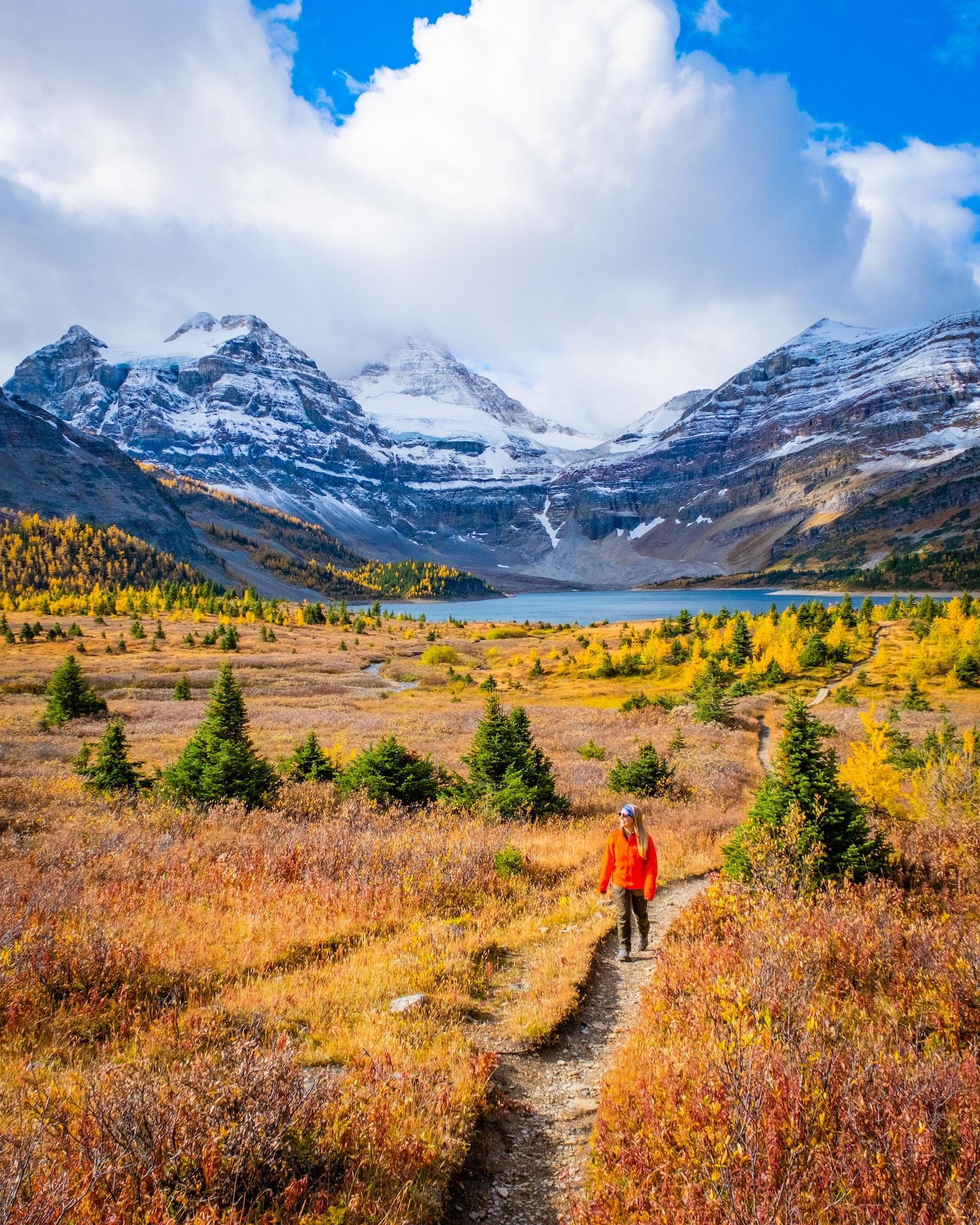
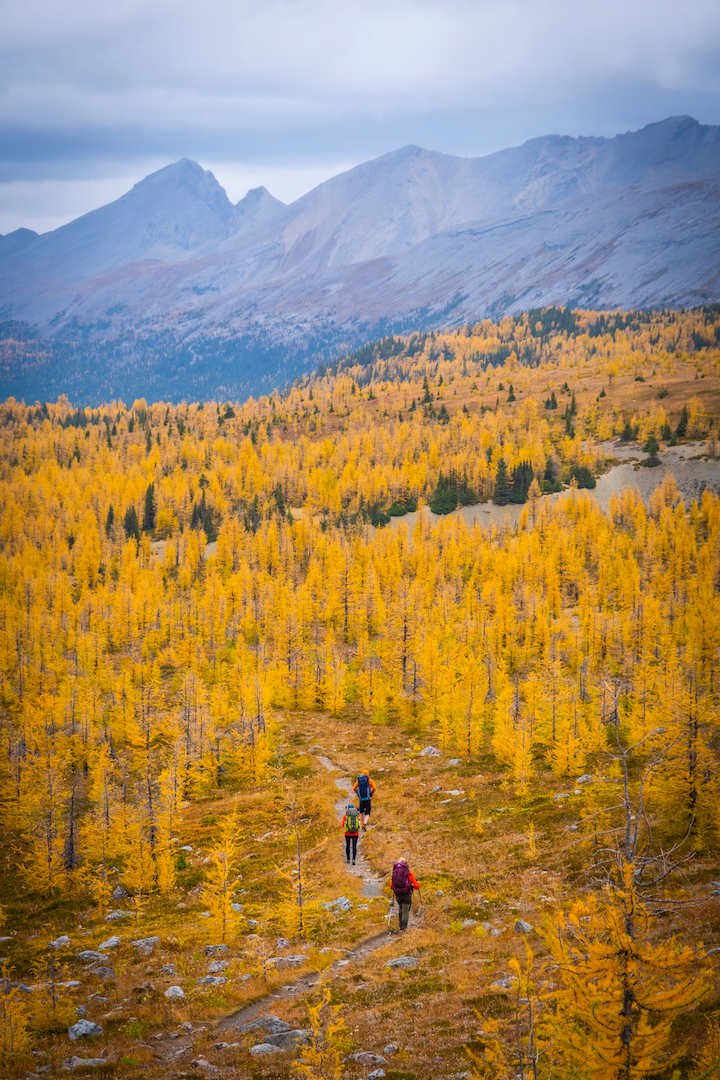
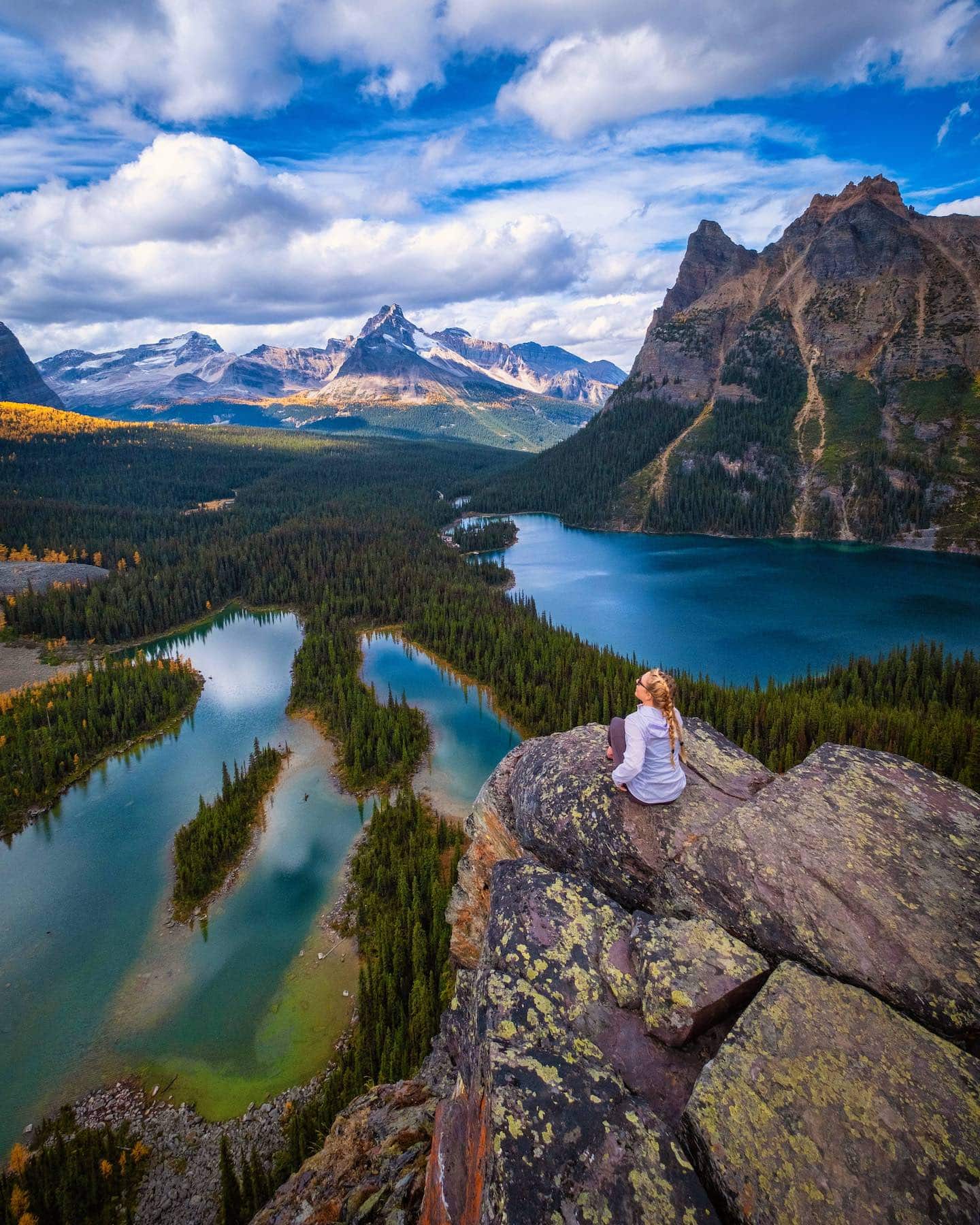
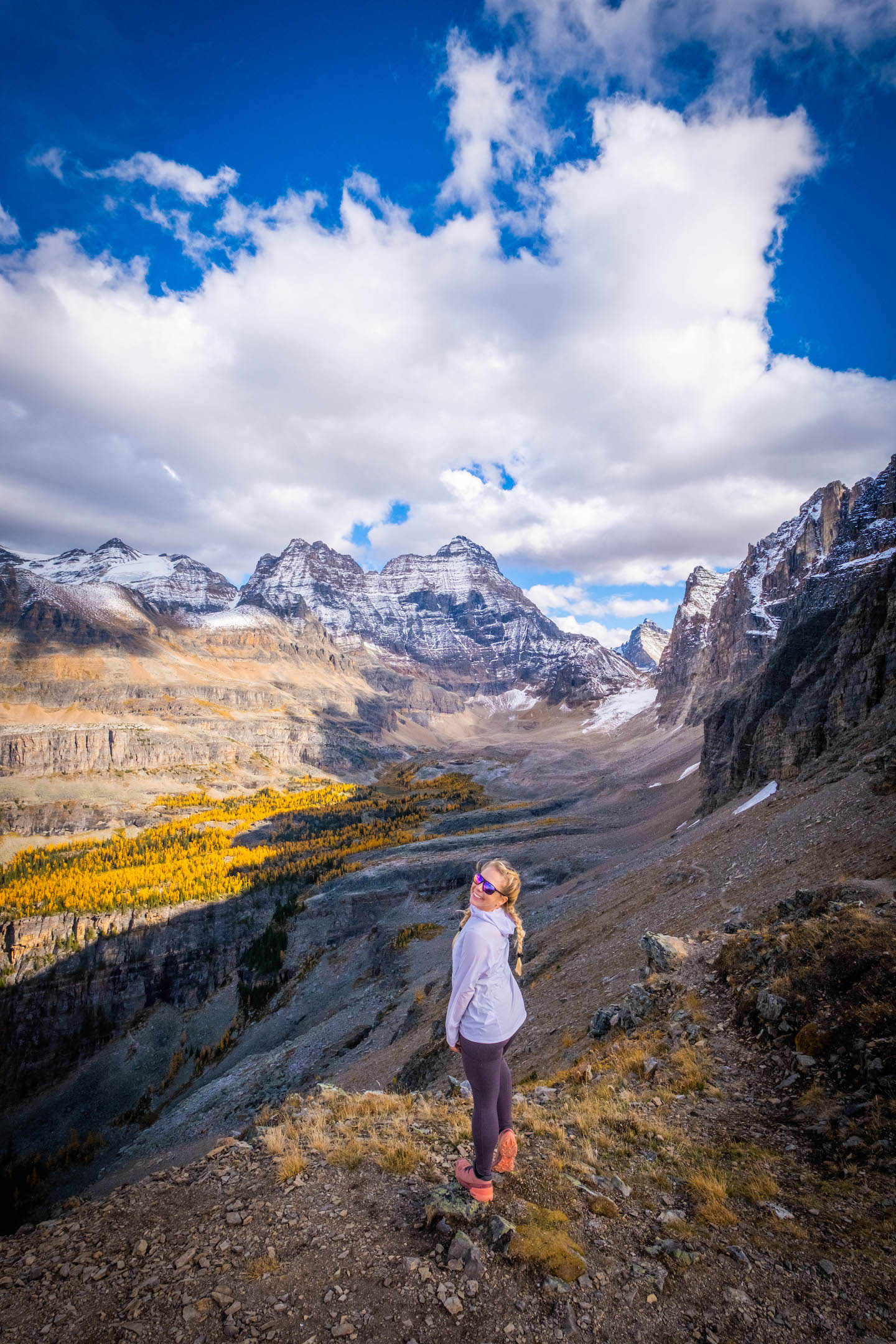
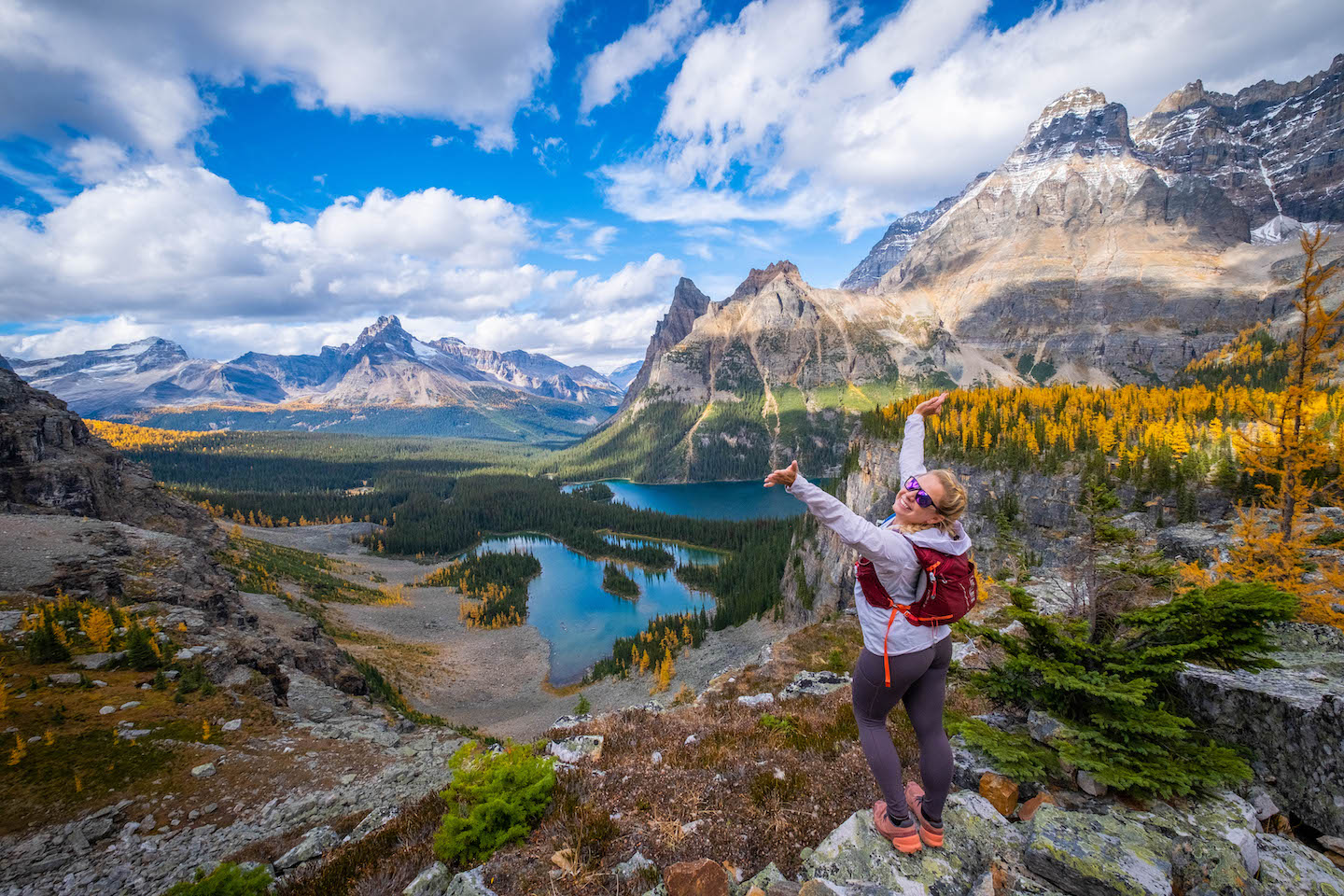
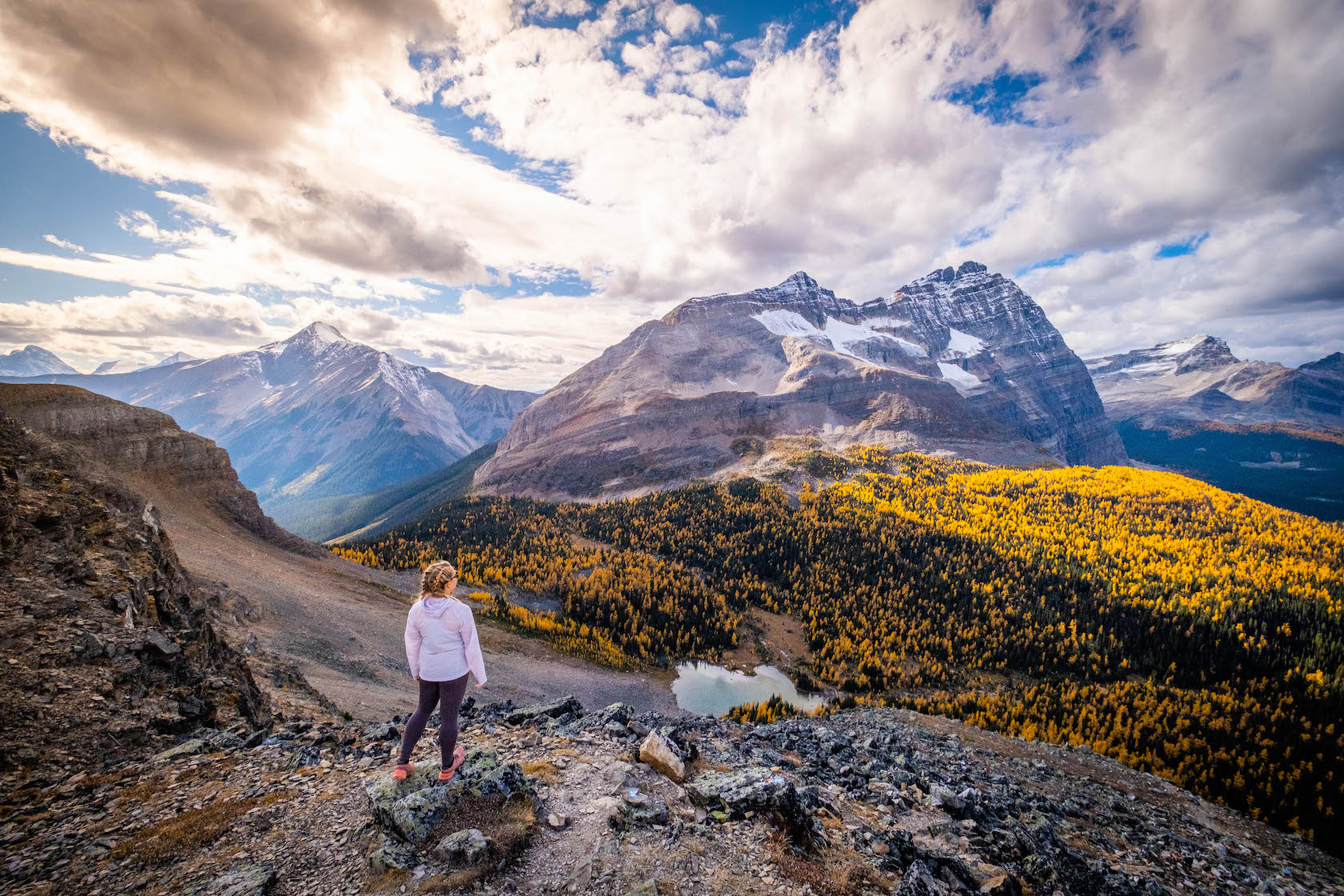
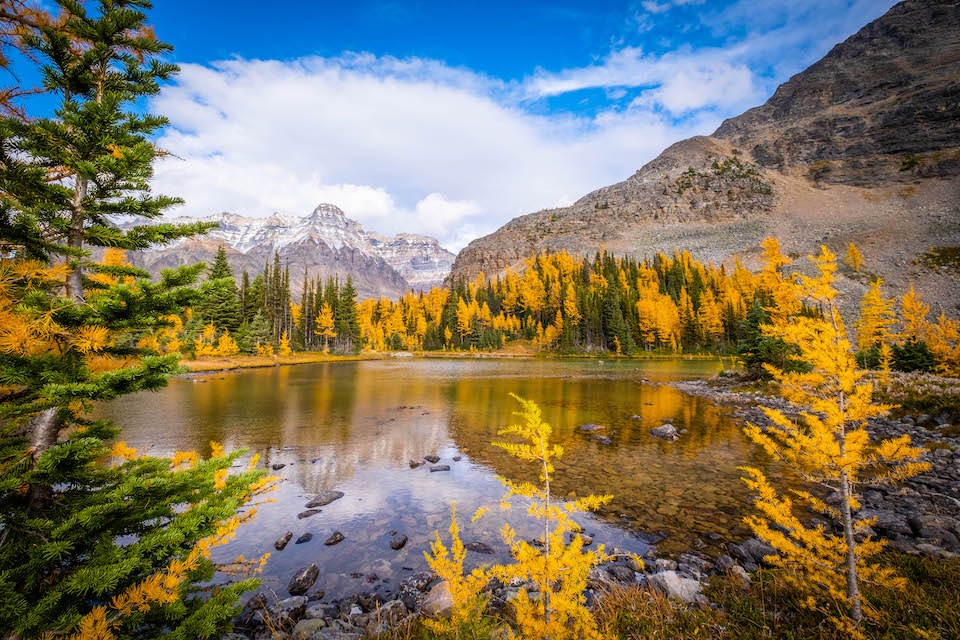
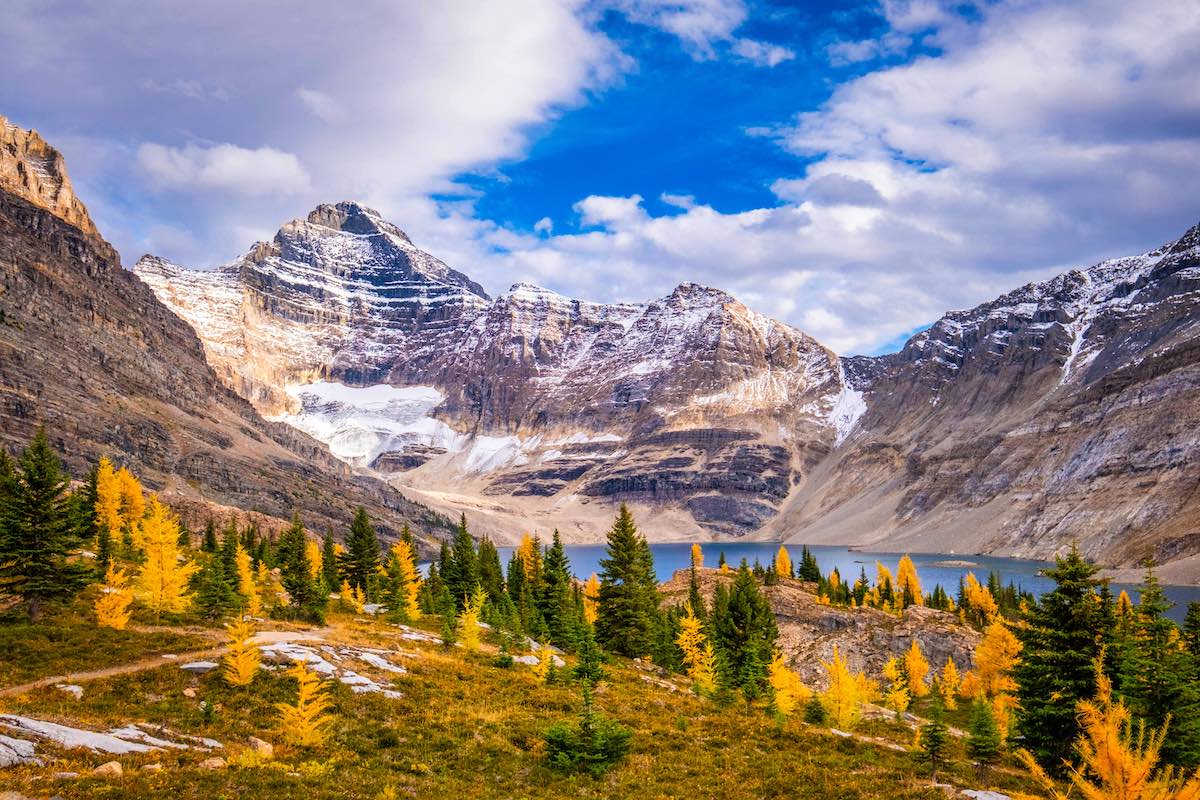
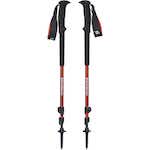
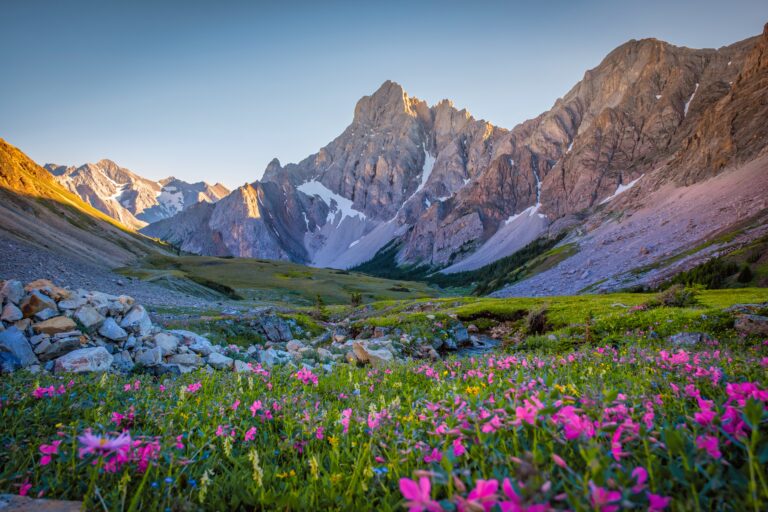
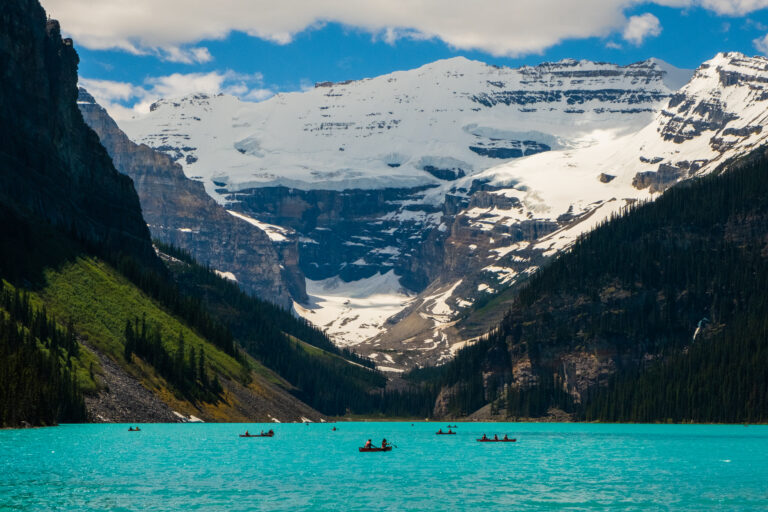
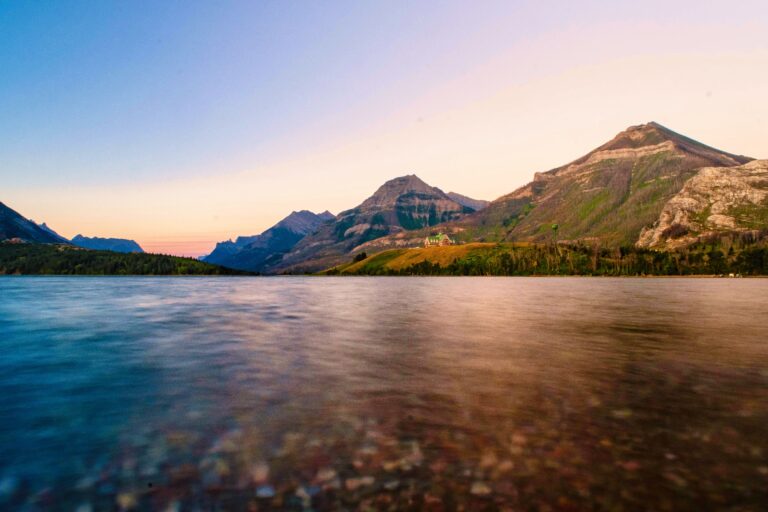
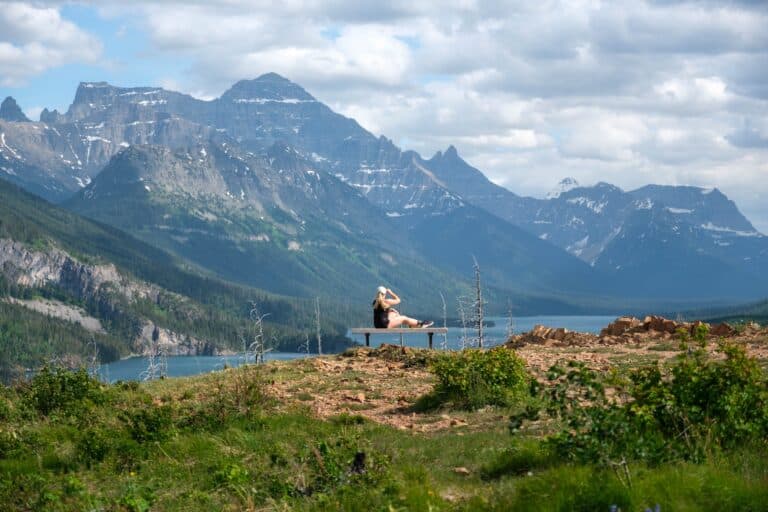
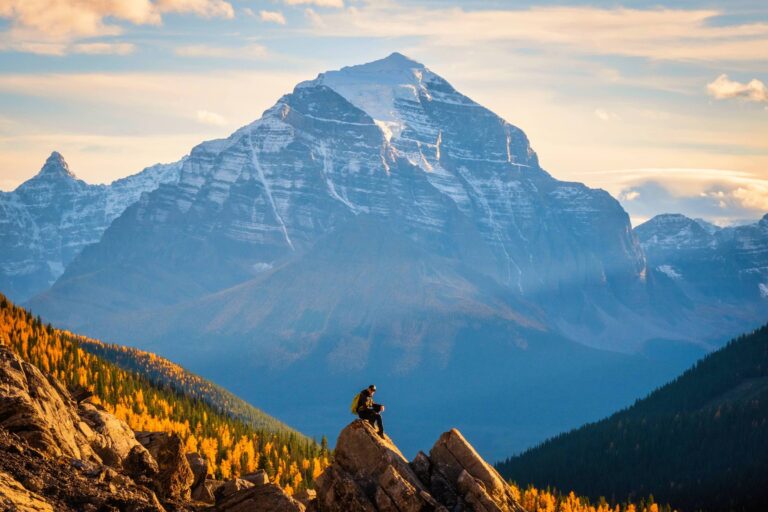
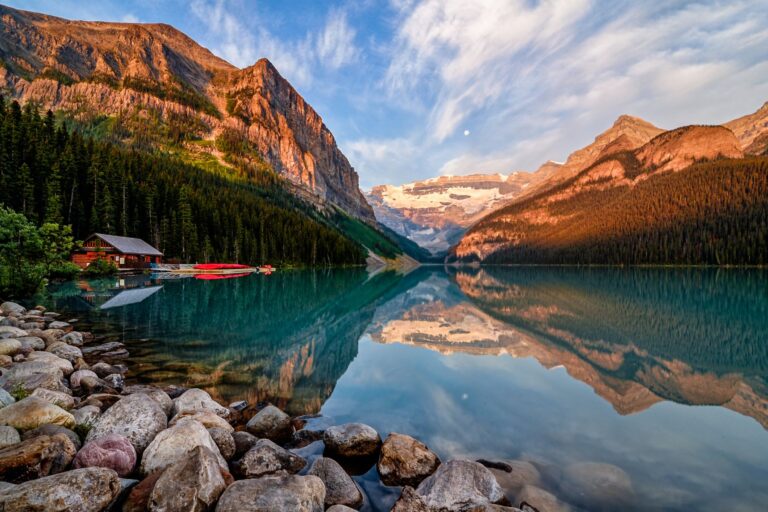
Hello! Regarding the hike combining sentinel pass, paradise valley, Sheol valley, saddleback pass, and saddleback mountain, approximately how long did this take you and what were the elevation changes? We are very experienced day hikers and have done a lot of challenging routes. Also, would there be a requirement to hike as a party of 4 during larch season? Thanks!
Here are my details: https://strava.app.link/niEBpdRIqsb from that hike. We are faster than average hikers. There’s no requirement to hikes in groups of 4 anymore
thanks Natasha! I’m assuming that was your moving time?
Yep! I think the day took us about 8-9 hours total with stops
We did the route in reverse (Lake Louise to Moraine Lake) a couple of days ago. Epic journey! Thank you for the very helpful information!
Headed to O’Hara at the end of September and am on the 8am bus. I am “old” so only have endurance/time for one of the hikes. Which one do you recommend for best Larch photos? Love you article, though wish some of the hikes weren’t so “epic”. 20km, round trip, is about my limit.
Hi Craig! I would probably suggest Opabin Plateau for a good viewpoint or Lake McArthur for the best larches – you can see all the photos and info here: https://thebanffblog.com/lake-ohara/
“However, you can typically count on frolicking through a sea of golden goodness by the third week of September every year.”
Seems to me it would be the 4th week (Sept 22-28). Maybe we are counting differently. What dates are usually best for Larches? We came last year Sept 14-22 and didn’t see much in the way of golden Larches. That would be the third week by my count.
PS Your blog has been very helpful in selecting day hikes. Thanks!
I answered all of this in the article. As stated in bold every year is different “First I need to emphasize that every year is different in the Canadian Rockies, and the time the larch needles change from green to yellow depends on several factors.”
“Fall in Banff is very short, but it is terrific. If you are basing a whole trip around seeing the larches, I suggest planning a trip between September 20th and October 5th – give or take a few days. Most of the photos in this article were taken in that period.”
They started turning in the Rockies a few days ago, which is the third week of September. The last week of September is typically great, as well as the first week of October. Unfortunately the trees do not operate on a timed schedule.
It turns out that my problem was not one of time but of place. on Sept 18 we went to Larch Valley and were amazed by the larches. On Sept 19 we hiked to Saddle Mountain from Lake Louise. The larches at the Saddle were stunning, especially because it snowed the night before. An otherworldly experience.